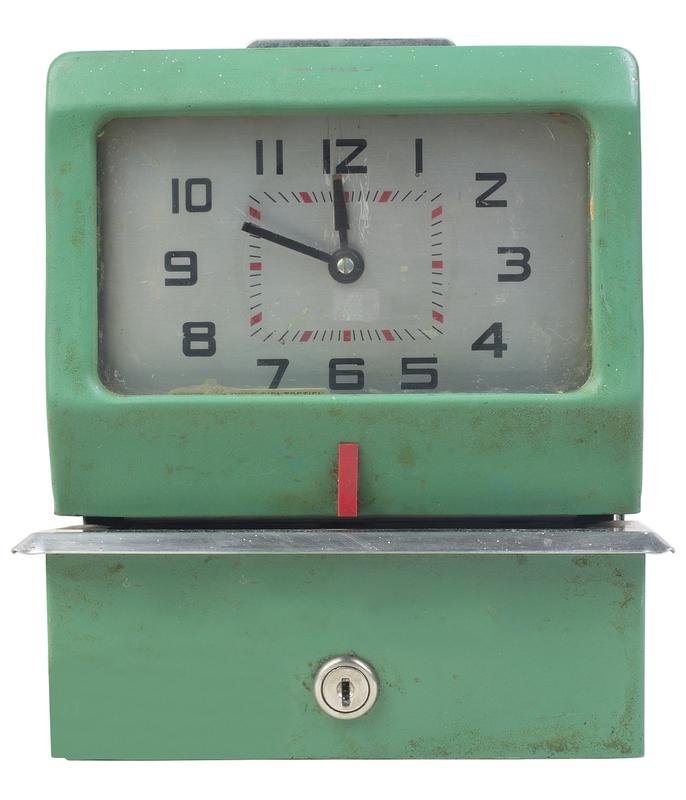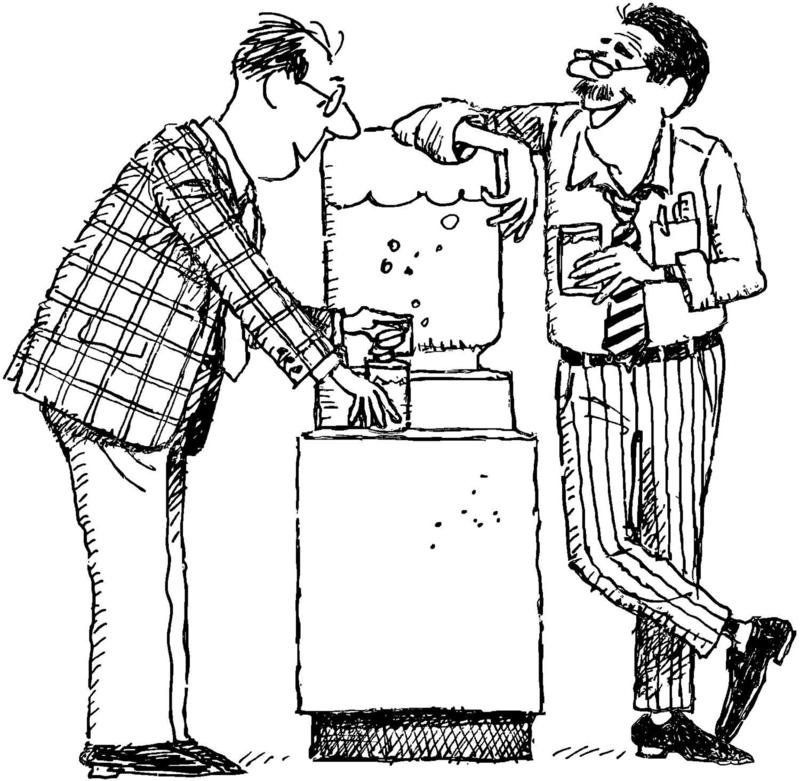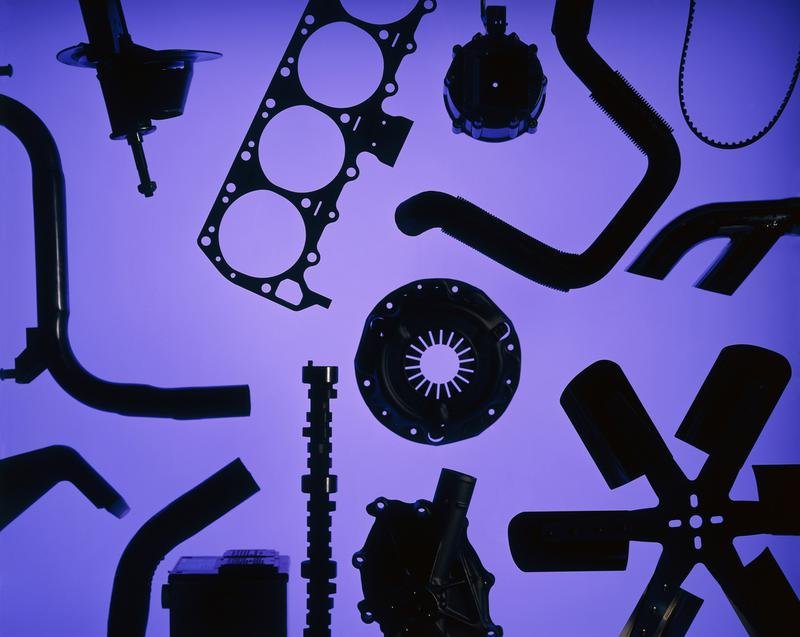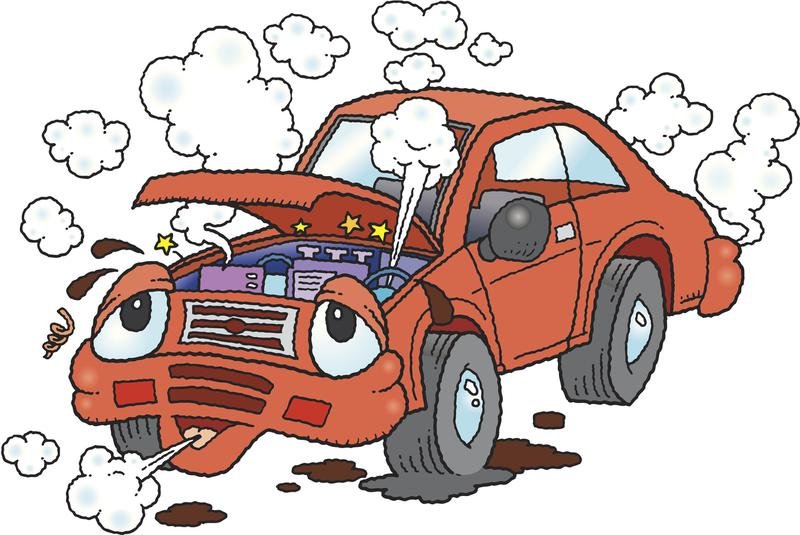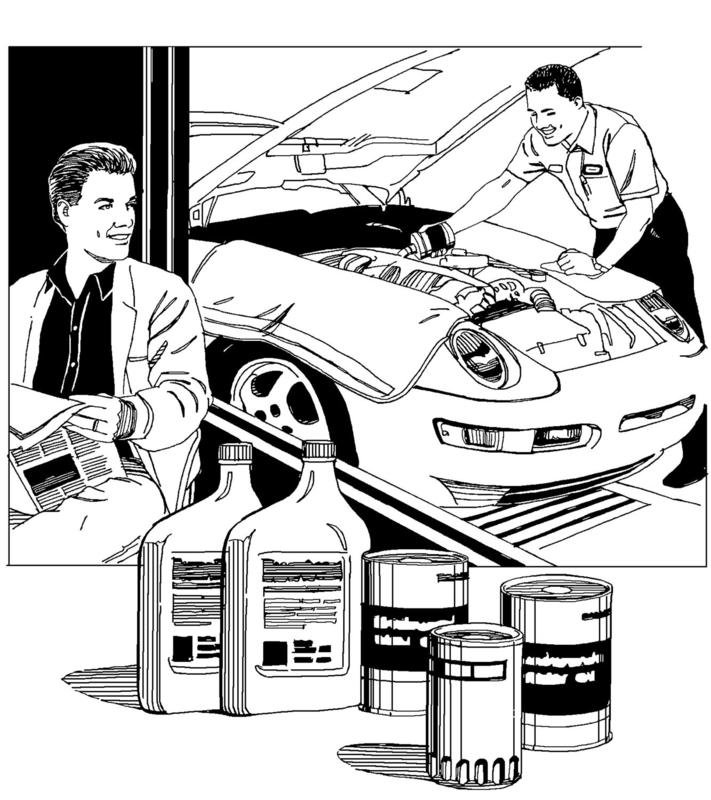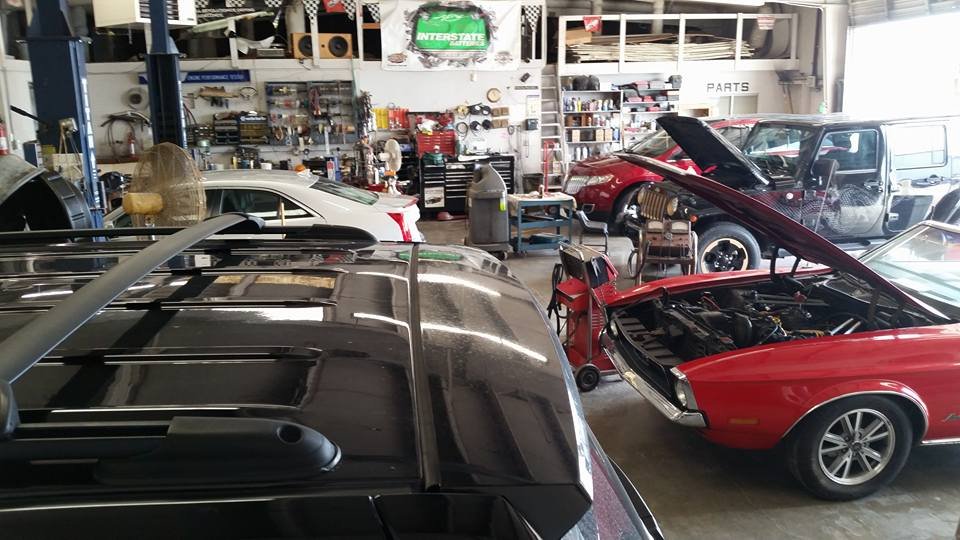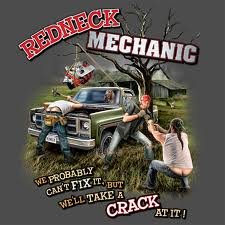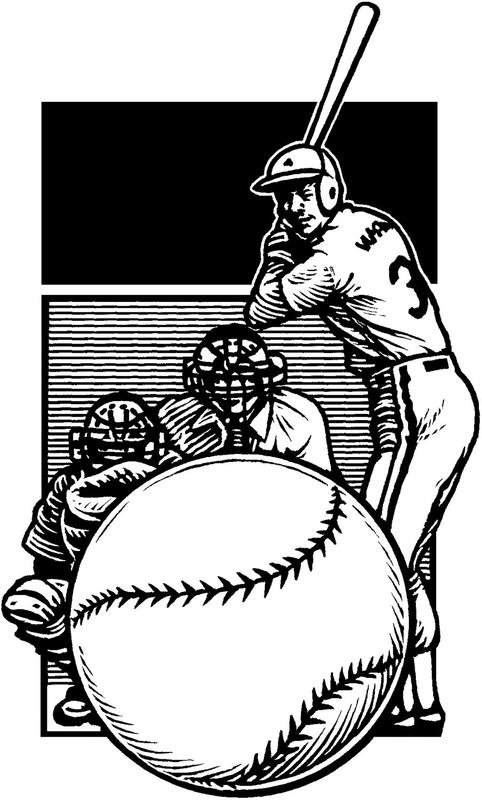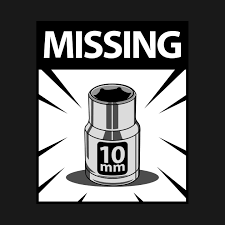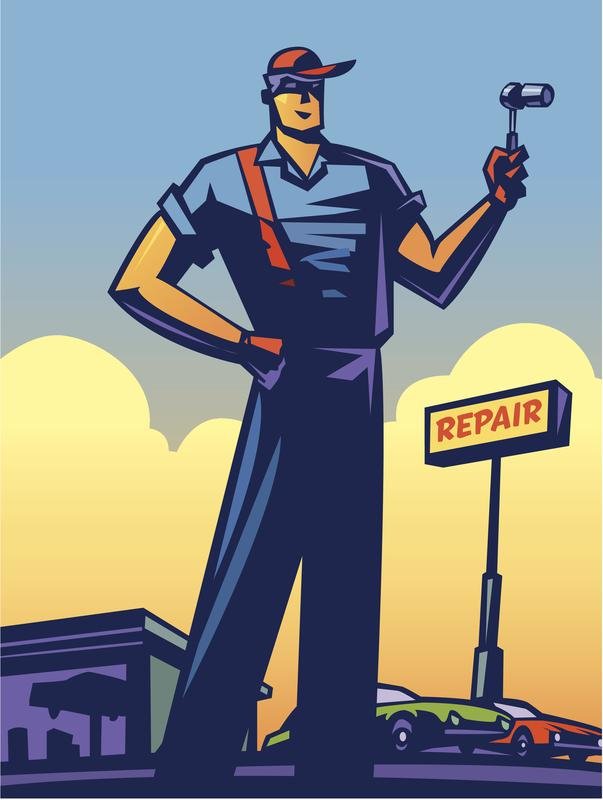Leaderboard
Popular Content
Showing content with the highest reputation since 01/25/2010 in Articles
-
One Penny at a Time One year I thought I’d try something to drum up some new business. I’ll try a cash discount for large jobs. Maybe this will bring in those new customers. It sounded like a good idea at the time, but as they say, “The best laid plans of mice and men….” certainly got involved on this little adventure. The cash discount was going to run for a month, just to see if it was going to work. All expectations looked promising. Jobs from a few weeks earlier had been contacted and informed of the new promotion to see if they’d like to reschedule that big job they were putting off. Almost all of them set an appointment before the promotion deadline. Soon, the shop was bustling with new activity and jobs were getting stacked up waiting for an open service bay. Unfortunately, as usual, there’s always one sourpuss who has to ruin all the fun for everyone else. Mr. Gripey came to the shop for an engine swap. He was your typical bargain hunter/never going to be a regular/always had a complaint type customer. As he put it, “I’m going to be your number 1 customer, if you can get me done on time.” I assured Mr. Gripey that everyone is our number 1 customer here and we would do everything we could to get him done, within reason, in a timely manner. It was just another Ford Ranger V6 engine swap. Nothing different from any other V6 Ranger we’ve done. That is except for Mr. Gripey, of course. His periodic snooping and interrogating questioning of the mechanic (and his mentor) about the job was relentless. It never fails, you get a snoopy-arrogant person barging in on the work the outcome is the same. It spells d-i-s-a-s-t-e-r every time something like this happens. I was prepared for the inevitable and personally took on the job of double checking every part, every fastener, and every existing blemish on the vehicle just to be sure there was nothing Mr. Gripey could question once the job was completed. The engine slipped back in place without a hitch, and every nut and bolt was torqued down to specs. Everything was going as planned, except for one small detail. The promised date of delivery. Because of the work load and the arrival of the replacement engine, we missed his scheduled time of departure from the service bay by one whole day. This was all the fodder Mr. Gripey needed to begin his wrath of expletives and insults as to how awful we’ve made the entire experience. Was I surprised? No, not at all. Now he wanted an even bigger discount than what the promotion had offered. I offered my condolences and gave a bit more off the top of the cost of the job. That wasn’t good enough. He wanted it for free now. Of course, that’s not going to happen. Now, he has decided to refuse to pay for the job. Several days passed between unanswered phone calls and messages left for Mr. Gripey to return for his vehicle. The daily reconnoitering of the service bay when his truck was being serviced came to an end too. The mechanic and his apprentice mentor were relieved to move onto the next project. Me, I was still stuck with the task of collecting the balance on the job. Which, is usually a rather pleasant experience filled with smiles and thank yous followed by a check, credit card, or cash. But, not this time. A week has gone by and Mr. Gripey hasn’t made an entrance yet. Time for one more phone call, but this time with a little added incentive. Mr. Gripey is going to be informed about storage charges for keeping his little pickup behind locked doors and that the charges would keep adding up until he showed up. He was given a grace period until the end of the week, and if we didn’t hear from him by then… the storage charges would start from the day of this phone call. It’s no surprise, Mr. Gripey managed to show up at the shop that very afternoon. “I’m here to pay my bill and get my truck out of your $&^#*!!! shop,” he said, in a very disgruntled manner. I gave him the total and said, “That’ll be cash, sir.” I wasn’t about to give this guy a chance to walk out with the keys with anything less than a paid in full with good ol' “American currency” and a completed repair singed off. Mr. Gripey turned around and went out to his car and returned with three large bank bags. He tossed the bags onto the counter and said, “Here ya go. Count it if you feel like it.” The bags were full of good old American currency alright, all of it … … … entirely pennies. “I’ll take my truck now. If you don’t mind,” Mr. Gripey said. I looked at the pile of coins starting to pour slowly out of the split open bag and looked back up at Mr. Gripey, “Uhm, sir, this is legal tender alright, but this is no way to pay your bill. But, in your case I’ll accept the payment only after it has been fully counted,” I said to him, trying to stare down his angry gaze, “So, just have a seat and I’ll get this counted and when it has been counted I’ll gladly hand the keys over to you.” Mr. Gripey hadn’t planned his little caper out as well as he had thought. He thought I was just going to hand the keys over and I’d be stuck with several hours of counting pennies while he was long gone with a smirk on his face thinking he just pulled a fast one on a repair shop. The fact is, he wasn't getting the keys until I had every last penny was counted. With some help from the crew, we sat in the front office counting each and every penny one after another. And no, I wasn’t about to give the guy the satisfaction of taking the bags to the bank and have them counted. I wanted him to sit there waiting the hours it took to have it all hand counted. It was by far the best bonding time I had with the crew. As we counted we talked about jobs in the shop, what was coming up next, tools, where we wanted to be in the next few years, our families, kids, and pastimes. Indirectly, Mr. Gripey did us all a huge favor by allowing us all to have a few hours of time together away from the wrenches. We kept at it until we finished and never once did we remain quiet or stop for breaks. By the time the last penny was counted we were all tired of stacking pennies. We could finally get up from our chore and get Mr. Gripey out the door with his truck and warranty paper work. His warranty has expired a long time ago and if it was no surprise, he never did come back for even an oil change. I’ve been paid with all kinds of things over the years. From a stack of Susan B Anthony coins to a case of beer. But, this was the first time anyone paid for an entire job with sacks full of pennies. Just for the record, if there is a next time… I’m not counting all those pennies again. I’ll let the bank to do it and make the guy come back the next day. Just don’t tell Mr. Gripey that. He still may need another lesson or two on how to act civil at a repair shop. Even if it is one penny at a time.5 points
-
How Long is a Labor Hour? Did you ever stop and wonder how long a labor hour actually is? I’m not talking about time ticking away on a clock. I’m talking about the actual time spent on a repair vs. the labor guide’s suggested time. Personally, I’ve never had a job that started and finished exactly to the second of the given labor time. It’s not like the labor guide’s hourly chart is set in stone, or that they’re wrong, but when it comes to getting paid it sure seems like they are. Any mechanic will tell you that a labor hour can stretch to half a day if a lot of research is involved, or it can last 15 minutes. Most labor guides typically don’t take into account how much research, diagnosis, equipment setup, or the time it takes recover your 10mm socket that just fell down into the motor. Time, as they say, is money. If you don’t think so, take your car to any bodyshop and read off the labor charges. You’ll find the labor time is divided into a 1/10th of an hour. However, in the mechanical repair shop, seldom are the labor costs scrutinized as they are when dealing with insurance companies. Even still, I’ve never once been asked to break down the mechanical repair labor into diagnostic time and the actual physical labor when giving an estimate. Estimates are usually quoted by the R&R labor time for a particular repair. Generally, that doesn’t include diagnostic time. Even though the book time has been calculated out, it’s still not a complete guide and certainly not the Holy Grail of the repair industries time clock. Try sticking with an estimate for changing a starter that’s listed as one hour job. More than likely the estimate is only going to be quoted straight from book of a one-hour labor charge and not any diagnostic time included. Even with all the technically advanced diagnostic tools a professional mechanic has at their disposal there are still people who can’t understand why diagnostic time should be included in the labor estimate, even though it’s not part of the R&R for the component. In their mind, (as I’ve been told numerous times), the mechanic should already know what’s wrong when they pull their car into the shop. What’s worse is the price shopper who calls from shop to shop looking for the cheapest repair. I’d bet to say the cheapest quote is probably nothing more than the R&R labor time for whatever part they’re concerned about. However, nobody mentioned anything about the crusted connections at the battery, or the leaking valve cover that’s coated the starter in oil, or whether you’ve installed aftermarket headers. Not to mention any diagnostic time, because the real problem isn’t the starter at all. On the other hand there are the stop watch aficionados. You know, the people who literally count the seconds of every minute and are bound to argue over any labor time discrepancies on their invoice. The mechanic’s entire career, (in their way of thinking), is strictly turning bolts and slapping on parts. These tick-tock-time-keepers, watch their timepieces with precision and inevitably use “time” as the only determining factor for the cost of a repair. For instance, let’s say the book time said an hour, and everyone involved agreed upon the charges, but the mechanic got it done in 25 minutes. The argument has always been that the cost of the job should be no more than the time it took to do it. Should the mechanic be penalized for doing his job proficiently and having completed it early? Where does it say he should give the job to the customer at some discounted rate because he can beat the book time? Doesn’t seem right at all. But, what if the same job that was quoted for an hour has taken four hours to complete? Who pays for the time difference now? So in a sense, a labor hour isn’t an hour at all. It’s an arbitrary amount of time that may or may not be exactly 60 minutes. If it was as accurate as some people believe, then theoretically you should get an estimate for that hour’s labor, pull up to the repair shop, and walk out in exactly 60 minutes with the job completed. Not a second sooner or a second later. Yea, good luck with that one. Like most trades mechanics get paid by the hour, however it’s not like you punch a time clock in the morning, work all day, then collect a 40-hour paycheck at the end of the week. Most mechanics work on flag time. Realistically, let’s call it what it really is… piece work, (the piece being the car). Very few mechanics are offered an hourly pay and a guaranteed 40-hour work week, (although there are some places that use a combination of both flag time and hourly pay). More times than not, a mechanic ends up eating a whole lot of labor time for problem solving. Whether there are rusted bolts, bad connections, illusive intermittent problems or poor information from the get-go, something is going to use up time which eventually won’t go towards a paycheck. Any time money and people are involved in the same situation, and you’re dealing with something that’s not widely understood, such as the modern car, it’s up to the mechanics and the repair shops to make sure they do. Customers also need to understand that this is a business based on suggested labor hours and not a time clock. There needs to be a reasonable amount of trust in the labor guide estimates from both sides of the counter. Because, it’s hard to say how long an hour of labor really is.5 points
-
PM Importance The mere idea of an intermittent problem that can’t be reproduced is a diagnostic situation that comes up way too often for mechanics. Another is the car that comes in that has had absolutely no preventative maintenance performed, and we all know how that’s going to end up. After decades of being behind the service counter, as well as under the hood, I do get a bit frustrated that people won’t do any preventive maintenance, or neglect to tell me about an intermittent problem they’ve had forever, because they feel it has obviously nothing to do with the reason they’re here today. I can only do so much, and without some prior history of any symptoms or what work that has been done, it makes it rather difficult to do my job as a mechanic to the best of my abilities. Information is the key when it comes to just about any subject, and preventive maintenance can lead to a lot of information, which is by far the cheapest and best way to prevent even larger problems. I found out the hard way a PM doesn’t just apply to the family car. Your internal engine needs some maintenance once in a while, too. Neglecting the early signs of an intermittent problem with a car may not have as devastating effect as neglecting your body’s own advanced warnings. Let’s face it, a car drops a valve or burns out a PCM, all your friends and family don’t send flowers or come visit you in the service bay. This is one of those times when the sure footed mechanic with all of his snarky comments about people who don’t listen to their car and won’t relay the pertinent information to their mechanic is now the patient, not the repair guy. Hardly a car will make it for its entire life without clogging the EGR passages, blocking the VVT ports, or have the occasional reduced air flow from of a dirty air filter. It’s inevitable that some sort of maintenance procedure will need to be performed to maintain that “as new” drivability. Me, the mechanic, well… I don’t have a check engine light to forewarn my impending doom. If I’m feeling a bit down, maybe a bit slow, or a slight tightness in the chest I’m likely to shrug it off and get back to work. Until the pain literally throws me to the floor, while clenching my favorite ratchet to the chest, this stubborn old guy won’t realize I’m about to cash in on that life time warranty I thought I had. You know the type: the “A” personality, all knowing, self-assured, and can take care of any problem on my own mechanic guy.” Well, age and time, diet, stress, and my family medical history have done me in. You’ve met your match, Buster. You’re about to throw a rod. The mechanic with “A” personality traits, and the “I’m the guy with the answers, and I’m right so often it’s a shock when I’m not”, as well as the, “Large and in charge” attitude usually means they’re (I’m talking about myself of course) not likely to listen to anyone else. They tell themselves those chest pains felt off and on are from some bad pastrami, but it’s a heart attack and it’s only going to get worse. And, it did. I can still hear all the times my wife and kids harped at me as I was being wheeled down the hospital hallways on the gurney, watching the neon lights zip by as I was rushed into Triage. I hate to say it, but that’s me to a “T”. I often wondered why the surgeons were held to such high esteems, and why they all seemed to have an air of confidence about them. I believe it’s a result of the years of training, the years of answering questions, and the years of listening to halfwit, poorly conceived ideas of what ails a person from people who have no idea what they’re talking about. Which is not that different than what the trained mechanic goes through on a daily basis. People ask questions and expect educated answers. Basically, if you’re one of those guys who pushes himself all day and night, works from sun up to sun down, or tells the wife that my job comes first and we’ll go on that big vacation when I retire, are fooling themselves and their families. Most of the time you’re so busy you forget to PM yourself. You overlook the obvious signs of an impending failure from those intermittent chest pains or backaches, etc. Life’s too short to say, “I’ll wait until later to get checked out.” Imagine what the surgeon is thinking when he props your chest open, looks in there and sees obvious lack of PM. Don’t be the mechanic in every situation. Don’t assume that you can fix everything. There are other people out there who are just as professional in their field as you are in yours. Hopefully you’ll get a second chance as I’ve been given. Don’t waste it on working until you die. The customer cars will wait. Follow your body’s PM schedule, and you’ll get to live a little more.4 points
-
There’s the bargain hunter, the bargain shopper, the bargain finder, and the “I ain’t shopping anywhere, unless I get a bargain” shoppers. But, there is one more bargain shopper who tries their best to get something for nothing at the repair shop, and that’s the “Sinch’ ya bargain shopper. The sinch’ ya bargain shopper isn’t hard to find, they’re everywhere. But, there are a lot of places where this form of shopping never works, such as the grocery store and at the gas pump. Now, the sinch’ ya shopper may try it at a doctor’s office, but I seriously doubt when they’re at the dentist getting a cavity filled they’ll ask, “Sinch’ ya got that tooth fixed, can ya look at this other one too?” and not consider the fact your dealing with a professional who gets paid for that sort of thing. Basically, what they are trying to accomplish is to get one thing done while sneaking in something else. You know the type. At the repair shop it is a habitual occurrence. Take the guy who comes in for a brake job, and then asks, “Sinch’ ya got it here, could you see why the check engine light is on.” Sometimes, the shop will bow to their request, but a lot of times this simple check ends up taking a considerable amount of the technicians time, because the problem in question isn’t a simple problem after all. It could be their thinking process assumes it’s no big deal, since the car is in the service bay already. Although, sometimes it’s pretty obvious it’s an intentional effort to slip in another repair on the cheap. And you can bet, if the mechanic checks things out and finds it’s a major issue, they’re not inclined to pay for any diagnostic time. I mean what was the mechanic thinking? They just wanted you (the mechanic) to “look” at it, not diagnose it. Now, that’s another thing. That word “look”. It seems to go hand in hand with the “Sinch’ ya” bargain shopper. “Can ya look at this for me too? Since it’s here?” however, when the service writer says, “They’ll have to charge you for the time to look at it”, you can bet the next thing they’ll say is, “Oh, never mind then. If it’s going to cost me anything I’ll just wait until next time.” That little word “look” tends to lead to other issues as well. Time after time I’ve been asked, “Well, if ya can’t look at it for free, what do ya “think” it is?” Oh here we go again. Now, the mechanic isn’t looking, he’s gotta think, sinch’ ur there and all. Which is probably the worst idea ever. Guessing at a repair just starts the wheel of parts spinning and hope it lands on something cheap. You can guess at a probable solution, with luck and experience the mechanic might actually have the correct answer. But, I have to wonder, is that all they really wanted in the first place? You know, a free spin on the parts wheel. Obviously the answer can only be based on what information was given. What if it’s not the right solution? What if the mechanic’s answer doesn’t match what they’ve researched on the internet? What if they think it’s still something else and the mechanic is wrong? Now what? I’ve solved these “thinking” answers with my own little tidbit of wacky wisdom. I’ll tell them, “I try not to think. It gets me in trouble every time. I’d rather test it and be sure.” Which only leads to, “Then, what would be your best guess?” Now we’ve gone passed the sinch’ ya, the look, and the think, and have gone straight to the guess. I’ve got a standard answer for the guess. It’s an answer that throws the whole question of sinch’ ya, look, and think right out the window. I tell them, “Well, it sounds like butterflies in the muffler.” Imagine the unusual stares I get. For me, it’s a priceless moment. It’s about then they realize I’m not about to tell them anything worthwhile about my job, their car, or their problem. Let’s face it, the long and short of it all is thinking, looking, and sinch’ ya’s don’t put supper on the table. Of course, it’s all about the dollar. It goes back to why it’s not such a good idea to give estimates over the phone without knowing the condition of the vehicle. Despite their best efforts to explain things, I’ve found over the years if they knew what was wrong in the first place chances are we wouldn’t be having this conversation. But, sinch’ ur here, maybe I can make an exception. Maybe I’ll bend a bit and take a look at the problem. Yea, I’ve slipped up more than a few times, usually after I’ve forgotten the golden rule of not “looking” at a customer’s car unless we’ve agreed on a fee. And, what happens 99% of time? They’ll thank me and tell me they’ll be back later to have the work done, but I wouldn’t hold your breath you’ll ever see them again. In large, urban shops the whole concept of the sinch’ ya bargain hunter is probably a whole lot different than the same type of customer in a small rural town. Meaning, there isn’t one set rule or answer to the issue. The big problem for both the big city and the small town is educating the customer, as well as the technician on what it takes to do this job. I’ve got to admit, after 3 decades of working on cars I still don’t quite understand the general public. Sinch ya’ gotta have them, you might as well “look” at their car and tell them what ya “think”, at least that’s my best “guess”. But, I am sure of one thing, when I retire from all this wrenching and scanning I won’t be the bargain hunter type of customer. I know from experience what it takes to do this job, and I highly respect anyone who takes on this trade and performs the job with professionalism. But, I might ask ya to check the butterflies in the muffler, sinch’ ya got it in the shop and all.4 points
-
Got your attention? Good! Before I start, let’s get something out of the way. Does technician aptitude or attitude affect the productivity of your shop? Absolutely. But this is the exception, not the rule. If your overall production levels are low, that is the sole responsibility of management. Let’s look at a few reasons for low production levels. The first area I want to address is billing. Many hours of labor go unbilled due to not understanding how to charge. This area is most prevalent with testing and inspecting. If your technicians are handed a work order, with no direction and not a clear process of what to do, or when to stop and ask for labor testing fees, there will be a ton of wasted labor hours, never to be recovered again. Next is training. Service advisor and technical training is a key component to high production levels. But let’s not forget in-house training. All policies and procedures must be reviewed often and refined if needed. Your team must follow a process. With no road map, labor dollars are lost. By the way, if you don’t have procedures in place, you need to make this top priority. Every successful organization has a detailed set of workflow guidelines. Let’s look at shop layout. How organized is your shop? Are shop tools and equipment readily accessible? Or do techs tend to wander around looking for the shop scanner or TPMS reset tool. Are stock items such as wiper blades and oil filters fully stocked and cataloged properly? Do technicians have separate access to technical information? Or are techs waiting to use the same computer station? Again, all these things kill labor production, which kills labor dollars. Next up is scheduling. There should be a structured approach to scheduling where the day is balanced with enough opportunity to make profitable sales. Have a process where vehicle history is reviewed before the customer arrives. Any previous service recommendations or notes is any opportunity to make a sale. But the key ingredient is in preparation. A customer that’s scheduled for an oil change may have forgotten that he or she received a recommendation for tires. Informing the customer at the time of scheduling and preparing for the work ahead of time, greatly improves productivity and overall efficiency. Another problem area is with service advisors and their workload. The service advisor, in many situations, handles the front counter, the phone, scheduling, helps with dispatch, part procurement and sales. All these tasks are critical to the daily operations. However, nothing happens in the shop until a sale is made. You need to look at your service staff. Are estimates getting processed quickly and upsells getting back to the technicians in a timely manner? If not, this is another area where production suffers. Carefully analyze your staff and run the numbers. More estimates processed means more sales and higher profits. Adding a service advisor or an assistant may be the missing link in a shop’s production problem. Knowing your numbers is another key component to attaining high production levels. I will refrain from giving you benchmark numbers, since all businesses models are different. With that said, you need to determine your breakeven and establish your labor goal for the week. Then knowing your labor goal, you need to calculate how many labor hours you need per technician. Then, you need to communicate this number to each technician. Having clear expectations and knowing the goals of one’s position is essential for hitting production goals. With regard to the technician’s responsibility, let’s remember one important fact; the technician has control over his or her efficiency. That’s it. If you dispatch a four-hour ticket to a tech, the ability of the tech to meet or beat that time depends on the technician’s skill, experience and training. There are a lot of other factors that influence production, such as the right pay plan and hiring the right people. But perhaps the most important influence is leadership. The shop owner or manager must study and look at the entire operations of the shop. Productivity goals must be established and then a system of monitoring production must be put into place. This includes sales goals, as well. Service advisors and technicians must get continuous feedback on their progress. Improvements in sales and in production, no matter how small, must be celebrated. The bottom line is this: If you’re not happy with your production level, you need to look at every aspect of your company that influences production. Improvements in key areas put technicians in a position to win. When they win, so do you. This story was originally published by Joe Marconi in Ratchet+Wrench on March 1st, 20193 points
-
Poking it with a Sharp Stick It's not so much that I work with the general public in my daily business, it's more of what kind of 'public' gives me the business. I'm not talking about people who can think and reason like most educated, knowledgeable people. It's that ever present cave man mentality. You know the type, the guy who's elevator doesn't go to the top floor, or the couple who can't seem to keep both oars in the water. The all seem to lack one simple characteristic, common sense. The very quality that every halfwit adventure I've either seen, (or been a part of) have in common. (I can't leave myself out of this one... guilty as charged) It stands to reason if some of these mental giants were among the intrepid pioneers who crossed the great divide in a Conestoga wagon, they probably would be the ones that never made it. But, with so many modern conveniences like diet, clean water, and modern medical care, these half-wit trail blazers roam freely throughout every part of the countryside. There was a comedian some years ago who told a story about his ancestors from the Stone Age. He commented on how some people felt it necessary to leave the safety of the cave to take on some huge beast with nothing more than a sharpened stick, only to be trampled to death by the same prehistoric behemoth. He went on to say, “My relatives were the ones who stayed in the cave... how else can explain my being here?! If my ancestors were the ones who got killed off, how would it be possible for me to be standing here telling you all about them? My relatives had the good sense to stay out of harm’s way. Were my ancestors brave? Sure they’re brave, they’re just not stupid.” “Oh look, large man eating beast outside the cave, I’ll stay here… you can go out there. I’ve gotta sharpen my stick, and while you’re gone I'll paint your picture on these cave walls. Our ancestors will think you’re great hunters that way.” (“Right, when in fact they’re running for your lives…!”) Funny, yes, true... I guess so, and in similar ways, it’s how some people tackle car repair. In most states there’s no regulation to keep someone from poking their pointed stick under the hood of their car, or hanging a shingle on a shop door and call themselves a “mechanic”. The unsuspecting consumer is at the mercy of the phone book (and other sources) to find a shop that can actually make the appropriate repairs on their car. It's like the car has turned into a huge mammoth, and the person attempting the repair is just taking stabs at it with a sharp stick. No training, no experience, and more than likely no clue what they are doing. This is but one of the many reasons why the automotive field gets such low marks in the consumers’ eyes. As one of my customers told me, “It's getting harder and harder to find a good mechanic these days”. And, from what I can tell, it hasn’t been much better in previous decades either. A typical example of this was last week. An older gentleman came into the shop with an air conditioning problem on his 1967 Thunderbird. Sweet ride, entirely original... just the way he liked it. He had been to several shops trying to get the air conditioning working. This car was factory equipped with the old style compressor and A/C lines that didn't use a Schrader valve, but instead had the hand shut off valves that you moved (in the correct direction) to recharge or change the compressor. The owner’s story was that every place he went to, no one knew how to use the hand valves correctly to refill the system. They were all good at replacing parts, but had no clue as to how the system worked. I'm old enough to have worked on these when they were very common. All the previous shops could have figured out how they operated, if they would have just put down their pointy stick, and did a little research. (FYI - There's only 3 positions to be concerned about: Front seated blocks off the compressor, Mid-position is used to allow flow between entire system, compressor, and the gauge port, and the most important one, back seated, which allows the entire system to work normally.) Turned into an easy job for me; all in all, the A/C system was blowing cold air in no time. All it took was a little basic knowledge rather than guessing at it. (No telling what parts actually needed replaced, by the time I saw the car everything was new, oiled, and mounted correctly.) Too bad for the owner though, he paid each and every one of them to do what I just did... make cold air. The T-bird owner was overjoyed to finally have his air conditioning back in working order. (He did tell me he wasn't about to use those other guys ever again.) I guess after so many pokes with that sharp stick the T-Bird owner had had enough. Then there’s the DIY'r trying to repair the car in the family cave. First it’s a jab with the pointed end of their stick, then two, then another, until they either figure it out, or they find the information they need to make the repairs. There's been a lot of talk lately about the factory information not being available... really?? What Neanderthal told you that? I've been working professionally in the car repair business for a long time and I've never had any problem obtaining factory information. The hard part is getting the right scanners (at reasonable prices) and education these days. It's out there; it just may take a little poking around to find it. (Pun intended) The big thing is, it’s not free, never has been. Poking the sharp end of your stick at the manufacturer and expecting him to roll over like a wounded mammoth and hand you the information for free … just ain't happening… ever. I have this mental image of a DIY'r and their protégé the “untrained mechanic” as the cave men portrayed in the painting with the great mammoth in center. The cave men are throwing their spears into the beast, but the huge behemoth of prehistoric times still isn't quite finished off. It's not a futile effort, if they keep stabbing at it they’ll eventually get the job done. Gee, doesn’t that sound just like a couple of guys trying to figure out what’s wrong with the car by throwing part after part at it? It does to me. Poking around with that Stone Age sharpened stick method of diagnostics is a slow and unproductive way of making any kind of automotive repair. But, I still see the same kind of poor workmanship even today. Working on modern cars, and even one from a few decades ago requires the right tools, the right information, and some good old fashion common sense. If you’ve got all that, you’ve got half the battle won. That common sense and good repair practices goes a long way. One thing’s for sure… it beats poking it with a sharp stick.3 points
-
Water Cooler Diagnostics We’ve all heard the phrase, “codes don’t fix cars, good diagnostics does”. Codes are merely a direction or path, not the answer as some might think. Those “codes fix it all” believers are usually at the bottom of the diagnostic chain. You know the type; those Neanderthals with little wrenches and big cheater bars, or the ones that follow the old adage, “When in doubt-rip it out” method of diagnosing a problem. It’s seems to me that car repair for a certain demographic of people has always been something related to hand-me-down repair information, not diagnostic skills. I believe it’s all because of the availability of cheaply made parts and bad information. Some of it is hearsay, but a lot of it comes from two guys chatting next to the water cooler at work, and neither one of them have any automotive diagnostics background at all. This latest case study is a perfect example of why swapping parts and paying attention to those water cooler experts isn’t always a good idea. A trained technician with diagnostic background and less time at the water cooler may be what you need. A 2007 Dodge 4.7L pickup came into the shop with a stalling problem. The owner had already stopped by the water cooler and made a trip to the code fairy. Since no codes were stored, there wasn’t much for him to do except follow the water cooler genius’ advice. He swapped out every sensor and computer part he was told about and a few more he could barely reach, just to be safe. All of which didn’t change a thing. Before writing up the work order, I had to listen to his story, which ended like most of them do, "I've already spent too much on this truck, and I don't want to spend a penny more." (I wonder what kind of commission the water cooler guy got from the part store for helping this guy spend all his cash.) The stalling was pretty predictable, usually every 15 minutes. Just as it would stall, the check engine light would rapidly flash, then the truck would sit silent. If you turned the key off and back on, the truck would run perfectly as if nothing happened, right up to the very moment the whole scenario repeated itself. Since the only odd thing was this momentary flashing of the MIL, I decided to hook up a scanner and wait to see if this odd failure would show up on the screen. Sure enough, code P0688 popped up momentarily, just as the truck stalled “ASD signal low”. Out of habit I reached up and cycled the key. Dang it, the code never stored and the truck is back to running correctly again. I’ll have to wait one more time and see if I actually had the right code number. Since it only occurred as it went through its death roll, catching this failure was going to be tricky. It was the correct code alright, but no signs of dropped voltage or weak connections anywhere to be found. It’s time to pull out the big guns. Break out the scope boys! With the scope hooked up to two different injector leads and the remaining channels on a couple of coils, I spent the afternoon watching the ASD voltage like a nervous hen watching her chicks. As if on cue, the truck died. Not a bit of change on the scope. I’m definitely going at this the wrong way. Something is dropping off, or at least I assumed it was. Instead of looking at the ASD signal, how about checking the injection signal and coil signals from the PCM? This time the scope did have a weird response. Just as it stalled there was a little extra squiggly line that didn’t belong in the pattern on the coil input leads. Very subtle difference, but enough of a difference that it needed closer attention. The voltage signal spiked a bit higher than normal just as the truck would stall, and then the voltage would drop to zero. It must be the PCM or a coil. Since the signal was only there for a brief blip on the scope, it wasn’t exactly something I could put my finger on just yet. Time for some old school tricks. Since the PCM was new, I could at least (with some trepidation) rule it out for now. I could test further, or I could try to create a problem that might mimic what I was seeing on the scope pattern, or with luck, if it was a spike that was coming from a coil, disconnecting it could show the problem. I decided to give this truck a miss of my very own and see if I could increase that little squiggle into a bigger one. I'll unplug one coil and watch the scope pattern. If I’m lucky, the truck will either stay running longer than it normally did, or it might show me a larger voltage spike. Sure enough, I found it on the third coil. As long as that particular coil was left unplugged, the truck ran well past the usual stall time. To verify it, I plugged the coil back in and watched the scope readings directly at that coil. A millisecond before the stall the coil spiked to the top of the screen as the truck shut off. Just as I suspected, if it was on the coil that was causing the problem the spiked voltage would show higher there than on the adjacent coils. The big question for me was why did it not set a code? The reason was the coil lead led straight to the PCM. The extra high voltage going back into the circuit simply turned the PCM off as if the key was turned off. There’s no codes for shutting the truck off, only codes for failures that make it shut off. The solution...replace the coil. Now and then there are problems that don’t follow the diagnostic steps laid out by the engineers. Even though you’d think every aspect and every type of condition has been tried and tested, or at least talked about around the water cooler. There are times when you’ve got to look past the “assumed” problem and dig a little deeper to find the cause. There's no doubt this repair is going to be another one of those conversations around the water cooler, but I seriously doubt anywhere in this story will the novice know-it-all admit that it took an experienced technician to locate his problem, not his water cooler buddy. Oh, and I don’t expect to hear him say as he leans on the cooler, “Codes don’t fix cars, mechanics do” even when there isn't a code.3 points
-
A Tisket A Tasket Every mechanic worth his salt loves a good challenge when it comes to something mechanical. Tearing engines and transmissions apart and putting them back together is kind of like “automotive therapy” for most professional wrenchers. These “therapy” jobs come in all sizes, big and small, and even in green and yellow baskets. They all start out as recognizable pieces of machinery but are now a disemboweled mechanical nightmare, haphazardly strewn into a motionless collection of parts at the bottom of a cardboard box. Yes, I’m talking about the proverbial basket case. They really do come in baskets, but cardboard boxes, shopping bags, burlap sacks, pillow cases, milk crates and the occasional pickup bed loaded down with what can only be described as pure chaos will suffice for a good old fashion basket case. True to form, the owner of these discombobulated ancient relics will always tell the mechanic the same thing, “Everything is there.” Yep, everything is there alright. Everything you took apart is probably there, but what about all the parts that were missing before you started? You know, those parts that probably set this whole thing in motion, and why it ended up in these assorted parts boxes. And, I believe you when you tell me, you haven’t lost a bolt, a nut, or that specially shaped washer that is rarer than hen’s teeth to find. (Not!) What makes matters worse is not so much what they took apart, but how they took it apart. There are numerous components that seasoned mechanic knows better than to try and separate, even though there might be some obvious screws or fasteners or a sealed cap. However, to the weekend nut spinner it looks no different than any other part. Somehow, someway, they manage to take that sealed cap off of a spring loaded diaphragm, and the next thing you know … zip, zoom, zing, sproing… the internal pieces fling into the next county. I can only imagine how much time and effort went into removing that sealed cap! From window tracks to engine components, nothing is sacred when it comes to how or what someone will tear apart and then give up on. Sooner or later the quest and the ambition to put it back together dwindles down to another feeble attempt they can mark off of their bucket list. They’ve lost hope of ever putting it back together again. Then, it’s time to toss all the pieces in the nearest basket or container. Someday, they’ll finish it, sell it, or maybe take it to a real mechanic. For the mechanic, the real challenge is trying to figure out what in the world is in the basket, what can be reused, and what has to be replaced. Sometimes the person who brought this basket case to the mechanic just purchased it at some ridiculously cheap price, thinking it can’t be that bad to put back together. Other times, even before they’ve bought these jumbled together crates of parts, they’re already working on how to spring this on their favorite mechanic. Once the mechanic gets his eyes on their latest flea market find the first thing he’s usually is wondering about is why in the world it was torn down this far apart in the first place. Sometimes it’s obvious, other times it only becomes apparent when you start pulling things out of the boxes and assembling what’s there. A perfect example of this was the time an old rare motorcycle came to the shop in bushel baskets. Since it was an old regular customer, and I’m always up for a good challenge, I thought, heck, why not, I’ll give it a go. Turned out the baskets contained enough for about one and a half engines, and as usual several parts were missing. Once I sourced all the missing pieces I could come up with, I managed to get it back together. I was in for a big surprise when I fired it up though. On the very bottom of the engine block there was a slight crack that only could be detected after the engine was warmed up. I really think this was one of those basket cases that should have remained in the basket. And, wouldn’t ya know it, the only part that wasn’t in the baskets and impossible to find… the engine block. It’s simply amazing the extent that some people will go to when tearing down a piece of machinery. I’ve done countless restoration projects where the entire car, bolts and all, end up in little plastic bags, as well as cardboard boxes. I usually mark each box or bag with a number, starting with the first part I take off in a bag labeled #1. Then, using a log sheet I work my way from the last number back to number #1 when reassembling. Seldom do I lose track of the components that way. But, to see these haphazard collections of wires, bolts, brackets, and grease covered components in the same box, all twisted together makes this anal retentive mechanic with a touch of OCD cringe every time. I’ve got to admit the hours spent sorting through the boxes brings out that “kid in the candy store” reaction from me. It adds to the experience of trying to bring life back to an old forgotten piece of machinery, and there’s no telling how long some of these basket cases have been abandoned back in the corner of some old garage. Whether it’s a hundred year old oil pull motor or a rare foreign car with no source of replacement parts, the challenge and the stories you can tell afterwards are priceless. None of these basket cases ever pay nearly what they should, but is it really about the money on these projects? For me, it’s more about the achievements and the chance to say, “I did it.” Yes, these basket cases can be a real challenge sometimes, but honestly, after you’ve put the last bolt on, turned the last screw, and got it to fire up, you can look back on the whole experience and tell everyone how you brought one more forgotten relic back to life, as well as emptying a few peach baskets. That’s when it’s time to flip that peach basket over and sit down and take in all that you’ve accomplished. Believe me, it’s great therapy, and you’ll be smiling from ear to ear when that hunk of iron is up and running again.3 points
-
Nick is on the front lines of customer service each day. He is a talented service advisor, with a passion for helping others. Nick and I often debate what’s more important to the customer: price or value? He’ll often tell me, “I know you preach value, Joe, but people care about price, too. In the end, price is a major concern.” I always respond, “Nick, it’s not all about price, it’s really about value. Build a strong relationship, reach the customer emotionally, have them believe in you and they will trust you. And when that happens, price will not be the focus.” Here’s the reality. I would be lying to you if I told you that price has absolutely no bearing on a person’s decision to buy from you or not. However, are consumers only interested in price? I know that sometimes it may appear that way, but the bottom line is this: being competitive and profitable is a fine line we walk each day. When the perception of value diminishes, price then becomes the focal point. Nick, who debates me on the philosophy of value, learned a valuable lesson recently, which made him a believer that there is most definitely a difference between value and price. About a month ago, a first-time customer called us to ask if we could take a look at her son’s tire, which was losing air pressure. Nick took the call and said, “Sure, we would be happy to help you.” He took down all the needed information and let her know that he would follow up with a phone call as soon as her son arrived. When the son arrived, Nick wrote up the car and dispatched it to a technician and then called the mother to let her know that her son had arrived. He also let her know that he would call her as soon as he knew something about the tire. About ten minutes later, the tech informed Nick that the tire was damaged from riding with too little air pressure and that the tire would have to be replaced. He also said that the other three tires looked new and that it would not be a problem replacing the one tire. Nick prepared an estimate for the tire and called the customer. Nick explained why the tire needed to be replaced and let her know that we could have the tire installed and have him on his way in about an hour or so. Nick then gave her the price for the job. The mother replied with, “Ok, give me five minutes and I will call you right back.” Fifteen minutes later the mother called, and said, “Nick, I found another shop that will install that same tire for $50.00 less than you can do it for. So, can you put air in the tire so I can have my son drive it to the other shop?” Nick thought for a second and responded, “putting air in the tire and having your son drive his car to the other shop is not safe. Here’s what I will do. I will have my technician put the spare on the car. He’ll also check the tire pressure in the other three tires. Afterall, we want to make sure that your son is safe.” The mother thanked Nick and hung up the phone. A few minutes later, the mother called again, asked for Nick and said this, “You know Nick, you were so nice to me from the very beginning when I first spoke to you and right up to now, and you put my son’s safety first. You also didn’t try to force me into buying your tire. Please install the tire at your price.” Nick, now on cloud nine, hung up the phone and told the tech to finish up the job. Nick learned a valuable lesson that day. He learned that he didn’t sell a tire—he sold something much greater. He sold an emotional feeling. He reached the customer on an emotional level and the price of the job became less important. Does this work with everyone? Of course not. But, if you want to make more sales and build the right clientele, sell value, sell relationships and sell a positive emotional feeling. Later that day, Nick told me what happened. I could tell that he was proud of how he handled the situation. And he should be. I just listened as he told me the entire story and relived the moment. After he had finished, I calmly asked him, “So Nick, is it really all about price?” Nick just smiled. This story was originally published by Joe Marconi in Ratchet+Wrench on May 5th, 20202 points
-
Your lead tech is not performing up to expectations. Shop production is slipping and you’re not sure why. You hear through the grapevine that some of your employees are wondering when they will get their next pay raise. After a few agonizing weeks of pouring through reports, you make the decision to give across-the-board pay raises. Almost immediately, you see a boost in production. The shop is more upbeat and all is well. Your decision appears to be correct. Three months later, your shop is once again struggling to meet its sales and production goals—and morale has slipped, too. I have seen this scenario all too often. And, while there are times that we need to give pay raises, if your shop is struggling to meet its sales and production goals, increasing pay to improve business is not the answer. The reality is you have deeper issues. Let’s address employee compensation first. You must pay people a competitive wage with the opportunity to earn more. There should be incentives in place to reward your employees for reaching their personal and team goals. And, there needs to be a process in place where your employees understand how and when they will get a pay raise. However, in terms of long-term company growth, a focus on pay alone will never be the formula for success. In other words, throwing money at a problem is a short-term fix. It’s putting a Ban-Aid on a more serious injury that requires much more care and attention. About 10 years ago, Mercedes-Benz was struggling with its customer experience at many of its dealerships. In response to this, Mercedes decided to increase pay incentives, implement new policies and training programs. No improvements were realized. Mercedes top executives could not understand why customer service was not up to company expectations. After all, this is Mercedes, a car company that represents quality and sophistication. Why were their dealer employees so indifferent? A senior leader at Mercedes recognized the problem and stated, “Pride in the brand was not quite as strong as we thought, the level of engagement with work was not as deep as we thought.” Mercedes finally realized that until the employees at Mercedes genuinely cared more, no amount of money, policies or training would make a difference. Understanding the need to get front-line people more engaged and take pride in their work, Mercedes began to invite its dealer employees to spend 48 hours with the model of their choice. To experience not only the amazing performance and mechanical attributes of the vehicle, but also that they can turn heads as they drive through their neighborhoods or when they drive into the little league parking lot. Mercedes also built its Brand Immersion Center in Tuscaloosa, Ala., in 2014, where hundreds of employees go each year to spend time getting to know how the cars are built, gain a deeper understanding of the brand, the history of Mercedes and experience the legacy of the company. According to Philippa Green, brand immersion trainer for Mercedes-Benz, “The ultimate goal is to engage their hearts and minds around the brand. We’re teaching them about our legacy.” As business owners, we track KPIs, set goals, work on marketing and refine our business plans. We also ensure that we provide our employees with adequate training and a well-equipped environment. These are the essentials of our business. However, we must never overlook the importance of your employees taking pride in their work. And, pride comes from employees knowing who you are, what you stand for, what you do for your community and for the industry. Giving people pay raises can motivate them. But the bounce you get from that is short-lived. Once people have gotten over the excitement of the raise and made the financial adjustments to their lifestyles, the raise is long forgotten. If there are no other intrinsic motivators, then shop morale, production and employee engagement will fall right back to where it was before the raise. Anyone who knows me and has read my articles, knows how much I preach about leadership. The theme of this article also has its roots in effective leadership. You, the leader of your company, have the power to transform the people around you. Focus on the person, not the position. Recognize when your employees do things that are from the heart. Promote your company’s brand, vision and legacy. These are the keys to a long-lasting company. This is what will improve morale, not a pay raise. This story was originally published by Joe Marconi in Ratchet+Wrench on March 1st, 20202 points
-
Roughly a month ago, two events happened on the same day that reminded me that there are things that are so precious, you cannot put a price on them. Those events also reminded me that some of the things we stress over, really aren’t as important as we think. And in the end, it all comes down to the importance of life itself. I got a call that day from Paul, the person who picks up our scrap metal. He asked if he could speak to me in private. Now, being a seasoned business owner, that’s usually not a good sign. But, this had nothing to do with business. I met Paul in my office a few hours later. He appeared very uncomfortable and upset. After exchanging a few words about business and the weather, he told me that his brother died last year. He was one of three other brothers that died within the past five years. He went on to tell me that none of his brothers had any savings or insurance, so it was up to him to take care of all the burial expenses for all the brothers. As Paul spoke, I could see that he was emotionally drained. Then he said to me, “Joe, I really hate to ask you this. I am tapped out. I cannot support all my financial obligations at this time. Would it be possible to lend me the money to purchase the gravestone for my brother? You can make the check out directly to the gravestone company, not to me.” I have known Paul a long time. He’s one of those hard-working, tough-talking guys that you would never imagine asking for a handout. I didn’t hesitate and wrote out the check and handed it to him. He held back the tears as he shook my hand and told me, “Joe, I will never forget this, and I will pay you back.” About an hour later, the owner of a local tow company walked into my office manager’s office to pick up a check we owed him for last month’s tows. I wasn’t paying much attention until I overheard my office manager say, “Oh, my God, I am sorry, Dave. I didn’t even know you were sick.” Dave is 42 years old, married with kids, and has brain cancer that is not responding to treatment. Dave has a great attitude, but understands the reality of his illness. He’s doing his best while on the treatment, but admitted that, some days, he finds it hard to function. He told us how he started his tow company right out of high school and has worked hard his entire life. As he was leaving, I told him to reach out to us if he needs anything. He told me prayer might help. I told him I would do that. Before the two events that day, I was dealing with a few business problems. And I need to be honest: I was not in the best of moods. After speaking to Paul and Dave, those issues that seemed so daunting before, didn’t seem all that important anymore. I sat back in my chair, looked over at a photo of my grandkids on my desk, and told myself that I need to do a better job at arranging life’s priorities. As shop owners, we get caught up in the day-to-day struggles of running a business—sometimes at a cost to our families, friends and ourselves. We anguish over bad online reviews, disgruntled employees, slow days and declining car counts. We sometimes find it hard to sleep at night, reflecting over and over again in our minds, the problems of the day. And we repeat this cycle over and over, year after year. Let me tell you, no business issue is ever all that serious that it cannot be overcome. But, when life throws you a curveball, as in the case with Paul and Dave, those problems are not so easily overcome. There are many reasons why each of us go into business. For many of us, it’s the passion for the work we do. For others, it’s the burning desire to improve the automotive industry. While I cannot say that we are in perfect alignment in every area of business, I do know one thing with certainty: We all need to stop and reflect from time to time on all the things that have nothing to do with business, but everything to do with life itself. Those are the things that no amount of money can ever buy. Those are the things that are priceless. This story was originally published by Joe Marconi in Ratchet+Wrench on June 1st, 20192 points
-
HillBilly HoeDown “Time for an old fashion sing-a-long. You know the tune, now sing it like you know you do when you’re in the shower!" Come on now… you can do it! First a little Banjo pickin’ … ya got it… OK Here we go…. --------------------------------------------------------- Come listen to my story about a man named Jess A do it yerself guy who kept his car a mess Then one day while in a tinkerin’ mood . . . Out from the engine came a bubblin' crude . . . Oil that is, . . . black gold, . . .Texas tea The next thing ya know Ol’ Jess ain’t thinkin’ clear Kin folk said, Jess move that car out a here! Said a mechanic place is where you ought to be So he hauled the ol’ car to the facil-i-ty Repair shop that is, spinnin’ tools, movin’ tires Now with all the repairs done, Ol' Jess can get back He's pritnear giddy not having to be towed… Ol’ Jess says he ain't workin' on his own car no more! He reckons it'd be easier just to come thru the lobby door…. Front door of the repair shop that is, no tow trucks, no home repairs. Ol' Jess yelled out, "Car repair ain't the place fer me!" “Workin' on ur own jalopy ain't like it used to be.” Said, “These here cars, are too complex for me these days” “It takes a heap of schoolin’ just to fix em’ anyways.” Trainin’ that is, conventions, classes, and OJT. Ol’ Jess refers our shop to all his family and his friends, They're so glad that he ain't fixin' cars no more and mention it time and time again. But, now it’s time say goodbye, to Jess and all his kin. We’d like to thank you folk fer kindly droppin in. You're all invited back again to this here locality To have a heapin helpin of our wrenchin’ abilities Auto repair that is. Engines, Transmissions, Brakes, and more… Y'all come back now, ya'hear? A little more Banjo and repeat the first verse. Alright! Ya done well Y’all! ! !2 points
-
Roughly a month ago, I went to lunch with a good friend of mine. He works for the YMCA, so we discussed what the YMCA does to attract new members. A few years ago, my friend and his team realized that while they were good at attracting new members each year, they had little to no retention. It was a constant battle to bring in new members to fill the void of lost members. The YMCA realized that it’s easier and less expensive to keep existing members, than to go out and find new ones. They created a new marketing strategy with a focus on keeping existing members. The plan was simple: create an amazing experience for their members and offer new programs to these existing members. The plan worked. Member retention improved. What worked for the YMCA will also work for your business. Before you spend a dime on advertising, you need to understand one crucial component of your business; the customer experience. Without a great customer experience that gives your existing customers a compelling reason to return, you’re simply wasting your money on advertising. Advertising is often aimed at new-customer acquisition. There is nothing wrong with this. Every business loses clientele each year for a number of reasons, and we need to get our name out to our community about who we are and what we do in order to attract new consumers. But, to rely on new customer acquisition alone without a plan to keep existing customers is not a strategy for long-term, sustained growth. Every marketing plan starts with looking at your entire operation and how it relates to the customer experience. Are you doing all you can to create an amazing experience that builds solid relationships? If not, you will be in the same position the YMCA was: using advertising to fill the void of lost customers. While there are many aspects of the customer experience, let’s focus today on the four essential areas: The customer write-up, the sales process, the car delivery and the follow-up. Each of these touch points must be executed with one thing in mind: create an experience so amazing that the customer will have a compelling reason to return your shop again. Customer write-up starts the process. It’s where you begin the relationship or continue to preserve it. It must be performed as if you are welcoming a guest into your home. The sales process must communicate value and benefits to the customer. This gives the customer peace of mind, reduces anxiety and buyer’s remorse. The car delivery is your chance to leave a lasting positive impression of you and your company. It should not be a transaction, but instead the opportunity to resell the job, you and your company. The car delivery should not be rushed. Take the time to review the invoice, ask the customer if they have any questions. Let every customer know how important they are and how much you value his or her confidence and trust in you and your company. The follow-up continues the customer experience. This is where you reach out to the customer with a phone call, email, or thank-you card. It helps with customer retention by making another positive impression in the mind of the customer. Getting back to car delivery: Make sure you review all future service recommendations and let the customer know that they will receive a service reminder. But don’t rely on a postcard or email alone to bring back customers. Think about this: If you had a bad experience at a restaurant, no offer or ad is going to get you back there—only an amazing experience will. The same holds true for your business. By the way, an amazing customer experience is created by the people in your company. Sure, you need to have a clean, well kept facility with nice amenities. But it’s the people in your company that make the difference. Billion dollar stadiums don’t win championships—it’s the quality of the players on the field that win championships. Everyone in your company is part of your marketing plan. A simple smile and hello from a technician when a customer walks past the bays can do more for your business than any ad can. Let me leave you with this thought: Customers will not remember the mass airflow sensor you installed or the exhaust leak you repaired. But they will remember their experience. A positive experience is lasting in the mind of the consumer. It’s the most powerful marketing tool you have—and it’s virtually free. This story was originally published by Joe Marconi in Ratchet+Wrench on September 1st, 20182 points
-
We all have our favorite customers. You know who there are. They’re the ones that throw their keys on the service counter in the morning and say, “Do what you need to do and I’ll see you at 5 p.m.” They never question your price, they trust you and they keep coming back. But does that person define your true profile customer? The answer is probably yes. But it’s not the only criteria. It’s a little more complicated than that. Defining your true profile customer starts with you. It starts with who you are, why you are in business and the culture of your company. By the way, determining your true profile customer has nothing to do with excluding certain people due to their income level. The young 23-year-old college graduate who sets aside part of her paycheck to shop at Whole Foods does so because she believes in the company and for what they stand. It’s not about what she “supposedly” can or cannot afford. She is Whole Foods’ profile customer because she aligns herself with that brand. And Whole Foods welcomes her with open arms. Many of my profile customers endured tough economic times during the Great Recession of 2008. They lost their ability to pay for some of the things they previously could afford. What they didn’t lose was their loyalty to my company. So, what did we do? We helped them through that difficult time. We helped them manage their car care needs better, offering services that would save on fuel, reduce repair costs, and reduce breakdowns. We showed them how to squeeze every mile out of their tires and brakes. We took care of them and we still do to this day. We consider them family and we don’t turn our backs on family. One thing we didn’t do, and will never do, is compromise on price to get a job. That would not be fair to all my customers, my employees or the company. With regard to pricing your services and repairs, it’s a delicate balance between being profitable and competitive. But I don’t know of any shop that prefers a customer walk away or sends someone to another shop because he or she cannot afford a particular price. A smart service advisor will give options, prioritize the work needed, and offer finance options. If you’re a startup company, your doors are wide open to everyone. You need customers and car counts, and you need them right away. But as your business matures, you begin to realize that not everyone is your customer. And there’s nothing wrong with this realization. As you build your customer base, you begin to see that there are customers that respect the work you do, align themselves with your culture and appreciate what you do for them and for the community. They become your profile customers. Let’s say you sponsor a youth baseball team in your area, help out at community events and involved with local fundraisers. You will become known as the business person that cares about the community and children. That’s making your business stand out among the rest. As you define who you are, you also attract those that want to do business with you and support your brand. While I do recommend treating everyone the same, I don’t recommend trying to be everything to everyone. That’s not a sound marketing strategy—that’s a recipe for failure. Defining your customer and targeting your market does not isolate consumers. It actually increases market share. Here’s an important fact: In your geographical area, automotive shops basically do the same thing; they repair and service automobiles. So, how is a consumer going to choose you over another? You need to stand out. You need to be different. You need to build a brand culture and establish a marketing position that will make people take notice. By the way, every successful company, large and small, understands its true profile customer and creates a marketing plan on attracting them. One last thing: When you build a business around your culture, you put the focus on your brand and the value you provide. This strategy is one of your pathways to success. When you combine value with culture, you will have an enduring and profitable company. If you want to build a great company, ask yourself these questions: Why are you in business? What’s your life’s purpose? Your culture? Build a marketing strategy and a brand message around the answers to these questions. Not all people will take notice, but your profile customers will. This story was originally published by Joe Marconi in Ratchet+Wrench on August 3, 20182 points
-
It’s Doing the Same Thing Being on the mechanic's side of the counter, I've often wondered what does "the same thing" really mean? Nearly every time a customer comes up to the service counter, who has no background in automotive repair, or any idea at all on how repairs are made and what's all involved, but tells me, “It’s doing the same thing”, I have to ask myself… “How do they know?” Is it really doing exactly the same thing? Funny, how it turns out (99.9% of the time), that it’s NOT doing the same thing. I hear this rhetoric from customers now and then, but when my wife starts in on me with the good ol' 'It's doing the same thing', now I'm more than a little curious. Here's an example. We were about to head on our vacation when the bulb warning light on the dash came on indicating one of the rear lights was out. It was a side marker light on the driver’s side of the car. Easily changed and taken care of, and with all the commotion and last minute preparations, the warning light problem became a distant memory. So off we went on our little adventure. Several states and hundreds of miles later while the wife was driving, and I was taking a nap, she nudges me and says, “It’s doing the same thing”. Now I understand there is always the possibility that it really is doing the same thing, but really my dear … you’re married to a mechanic. Can we at least re-think how to inform me of such things? Yes, the light on the dash is “doing the same thing”, but let’s try rephrasing it to the guy just waking up from a pleasant-no-stress-day-off. How about: “The warning light is back on, dear.” At least that way I won’t feel like I’m back at the shop trying to decipher the latest “doing the same thing” dilemma. I’m on vacation for heaven’s sake! At the next stop I performed the usual "walk around" and noticed the passenger side marker light that was out this time. Not to be outwitted by a little warning light, I gave the lens a little tap. Low and behold, the filament lit up, and off we went. As we traveled down the road I had plenty of time to ponder how many times I’ve heard the phrase, “Doing the same thing”. Over the years I’ve seen this escalate into complete madness at the front counter or end up with a tap on a bulb lens. As in my wife’s case, the dash warning light could only indicate that a bulb was out and which end of the car it was. However, when a customer lays down a chunk of their hard earned cash their interpretation doesn’t include the possibility of multiple issues controlled by the same warning light. From their perspective, it's doing the same thing. A few weeks ago I had a 1995 Saturn in the shop that had been all over town, as well as to every relative who owned a tool box. No one seemed able to get the air conditioning to cool. Part after part was changed, but still no cold air. When I finally had a crack at it I was surprised at what I found. The connector for the A/C compressor was exactly the same style and type as the low coolant level sensor mounted in the over-flow bottle. Somebody had flip-flopped the connectors. Once I found the problem the cure was simple… just reverse the connectors and “Ta-Da” cold air. All the functions were working, cooling fan, line pressure, vent temperature, everything was great. Even the “low coolant” light was operating correctly. But where would this story be without a 'It's doing the same thing' scenario. A few weeks later I get a call, you guessed it… “Doing the same thing”. Now, I’m no dummy, I know what they meant. They're actually telling me that it's not making cold air again. I informed them it was probably leaking refrigerant or something like that, but I seriously doubt somebody switched the connectors again. They weren’t buying that, they kept insisting that it’s doing exactly the same thing as before. Even after reading the description of the repair on the invoice, and telling me they totally understood it… they still can't break away from the common reply... it's “Doing the same thing”. This follows right along with the typical scenario right after changing out a blower motor for a customer and a week later they're back because their air conditioning isn’t cold. I’ll ask, “When did you notice the air wasn’t cold?” The usual answer, “Right after you changed the blower motor.” I should have a guy in the background with a drum set patiently waiting for me to ask, "So when did you notice the problem?" and when the customer delivers the inevitable punch line, the drummer could bang out the classic drum roll-rim tap and cymbal crash. A priceless moment for every counter person. The way I see it, the consumer brought their car into a repair shop for a professional evaluation of a problem, and expect to never see a related or similar problem ever again. But, as soon as the work is done and some other problem creeps up that seems to be more than a little bit like what they just had repaired, the mechanic is soon to have the same thing happen again. The fact that there are other things that can go wrong can be a huge mountain to climb. But, with some diplomacy, and tact, a good counterman can get through these situations. One thing for sure, as the mechanic, you've got to get in there and solve the problem no matter if it's the same thing or not. Generally, (from my past experiences) the same thing is hardly ever the 'same thing'. The Saturn, was a faulty compressor due to the fact the last shop didn't add enough oil to the compressor, the replaced blower motor problem, was a faulty low pressure switch, and the wife's car, well... she hasn't had to tap on the bulb lens ever since. But to me.... it's all the same thing.2 points
-
As a young tech, there wasn’t anything I couldn’t do. I diagnosed every car with the accuracy and skill of a Greek god. My efficiency week after week was over 150 percent, and with no comebacks. As a shop owner, I sold every job, and at a profit. Each new day was better than the day before. Boy, when I look back, I was amazing. Those were days. OK, OK, perhaps I am stretching the truth a bit. The fact is my past was not a smoothly paved road to success, but rather an obstacle course riddled with emotional and financial potholes, with more ups and downs than the biggest rollercoaster. Was it amazing? Oh, yes. Amazing because of all the mistakes I made along the way. As the years have piled up in my life, I often find myself thinking back to the “old days” and judge people by how “perfect” I thought I was back then. Oh, don’t get me wrong, I was a good technician and somehow evolved into an accomplished businessman. But was I really as good as I remember? I was outside the bays talking with my manager when Nick, one of my techs, began his road test on a Chevy Tahoe. As he passed us I could hear that unique “squeaky” sound a seized, worn out u-joint makes. I yelled to him, “Hey, check the u-joints.” He nodded his head and drove off. About 30 minutes later, I walked over to Nick and asked him what he found on his multipoint inspection. He told me that the wiper blades were torn, there’s a little play in the right side outer tie road and he recommends a four-wheel balance with a wheel alignment. I asked him, “What about the u-joints?” Nick replied, “They’re fine; nice and tight.” I could feel the tension begin to rise when I continued with, “Nick, I asked you to check the u-joints because I could hear that something was wrong. How did you check the u-joints? Do you know how to check u-joints?” Nick was visibly upset, so I suggested another road test—this time with me. During the road test, I told Nick to roll down the windows and listen. I said, “Do you hear that squeaky sound? That’s a seized u-joint.” Nick listened closely and then said, “I never heard that noise before.” To myself, I said, “You must be kidding me! How in the world can this tech not know it’s a seized u-joint?” But, thankfully I paused, and replied with, “Nick, how old are you? He responded proudly, “Twenty-one, boss.” Nick is a recent graduate of a well known tech school. He comes to work on time, works hard, and learns every day. His production improves each month. He has a lot of raw talent and a great attitude. At 21, how in the world could he know what I know at 63? I often forget how young some of my employees are. I also need to remember that people will make mistakes and they need the time to hone their skills through years of experience. They don’t have the gray hair of knowledge that often comes with decades of experience. Allowing people to grow will mean making mistakes. A tech will make the wrong diagnosis. A service advisor will lose a sale or forget to sell the tire rotation. But, did you or I diagnosis every car correctly? Did we make every sale? Were we absolutely perfect in everything we did? Of course not. So let’s be a little more understanding. I am not suggesting we settle for mediocrity. People need to strive for excellence. But even the best home run hitter will strike out at times. As business owners, especially those from my generation, it’s our job to pass the baton, to teach others, to be a mentor and a coach. Don’t be too judgmental. If we are honest with ourselves when we look back on our lives, we will see triumphs mixed with a lot tough days. When you feel yourself losing your temper or getting upset over the mistakes or lack of knowledge from one of your employees, just think back and view your own past. Don’t look back with a skewed memory of your greatness, but with an honest recollection of your struggles and mistakes. And you never know, you just might help others avoid some of the mistakes you made. Oh, by the way, my approach with the way I handled the situation with Nick and the seized u-joint? Another mistake on my part. So even at 63, I am still making mistakes. Kind of humbling, right? This story was originally published by Joe Marconi in Ratchet+Wrench on July 6, 20182 points
-
Semper Fi Bob was well into his late 80’s when I met him. He’s quite the talker, and he’ll never run out of things to tell you. I like old Bob. We have a few things in common, not much because of the years between us, but just enough that we can relate on quite a few subjects. We both served in the USMC. Of course, the years we served were decades apart, but even with the differences in time served, we still could “talk-the-talk” like two old veterans who just got their discharge papers. Bob had a problem with the horn buttons on his ‘92 Buick. It was the kind of horn that has its buttons and the air bag all built as one piece. He didn’t have the money to replace the entire airbag, but he did want to get that horn working somehow. I thought I could get it to work even if I had to “rig” something up, but that was OK with him. With his advancing years catching up with him, his hands weren’t the best. Most of his strength had faded with time, and so did the ability to straighten his fingers all the way out. I had to come up with a way that he could hit the horn button with the palm of his hand, rather than with a finger tip or thumb. Not a big deal, actually if he didn’t mind the look of an old style horn button attached to the edge of the air bag (so it didn’t interfere with the air bag operation) it could work just fine. Now Bob, being Bob, talking was his gift, and finding somebody with a little military background, and stuck in the driver’s seat of his car was all he needed to tell one of his stories. Bob hopped in the back seat and leaned over to watch what I was doing. As I worked on his new horn button, he told me all about his time in the Marine Corps. Fascinating story; I could have listened for hours. In fact, I made sure I took long enough for him to tell his story in full and without any interruptions. He told me about his time in Korea, in Inchon actually. It was a cold winter when he was there. A bitter cold wind and heavy snow was only part of the horrific condition he had to deal with. He went on in great detail how he was just a young kid who didn’t know a thing, and how you would be talking to someone one minute and the next minute the fellow Marine sitting right next to him froze to death. When he told me that part of his story I had to stop and turn to him to ask, “That really happened, just like that, Bob?” With a stone cold look on his face he said, “As sure as I’m sitting here talking to you, my friend.” I don’t think he was kidding. He was dead serious, but it was as if he was telling me a story from a distance, but at the same time, a story where he was actually there in the mountains of Inchon still fighting the bitter cold. I think it’s a way for time and age to allow a person like Bob to separate themselves from what was probably a terrible event in their life. I certainly have never experienced some of the things he was telling me about, like the chow, the hours of watching for the enemy, or how his boots didn’t have much in the way of insulation, so you put on as many socks as you could along with any straw or grass you could find. Bob made a point to tell me that if you needed to run to the “head” (bathroom for all you none GI type) … well, you tried to wait as long as you could, because exposing yourself in that kind of cold could be the end of you… and I don’t mean just “your” end that’s exposed. I finished up my little project and gave it a try. It worked just fine. “Hop up here Bob, and see if you can make it work like this,” I told him. Bob made his way into the driver’s seat and gave his new horn button a try. A gleam came over his face, beaming from ear to ear. He had to try it a few more times, and each time the smile kept getting bigger and bigger. “Don’t you know I needed that horn! Mercy, there’s some little kids in my neighborhood who get out in the street to play, and I just want to toot my horn to let them know I’m coming. Thanks partner, ya done me right.” The old Marine got out of his car and opened his wallet, “How much do I owe ya?” “Bob, it was an honor to do this job for you. I can’t take a thing.” “You most certainly are, Marine!” he said to me as he palms a twenty in my hand. “Thanks Bob, I appreciate that, but I really appreciate the stories. You know I write a column for a magazine, and I think I’d like to tell your story if that’s OK.” “Sure, not a problem. Go right ahead. I think I’d like that.” You don’t shake hands with Bob, because of his crippled hands; his way of shaking hands is to “bump” knuckles. Good enough for me. It’s the thought that counts. Then Bob turns to the car sitting in the bay just in front of his car. With whatever strength he had, he did his best to straighten one finger and point at the car in front. “I’ll never get over seeing this,” he said. It was a Kia Sportage in for a no start condition. I made the assumption it was because it’s a Korean car, and I thought it must be bringing back some of those painful memories he had as a young man. “I understand where you’re coming from Bob, it’s a Korean car. I understand completely; it’s something your generation had to deal with on the battlefield where your friends had died. I’m sorry it brings up some bad memories for you.” “That ain’t it,” he said as he walked closer to the car, and pointed directly at the name branded on the back door, “Killed – In – Action.” I think my knees buckled a bit when he said that. I didn’t know what to say next. Bob waved good-bye, and pulled his car out of the shop, and tooted his horn as he made his way down the street. I see old Bob once in awhile, still driving the same car, still tootin’ his horn. I don’t think I’ll ever forget his story of how he served our country. He’s one of the last of that generation, a much simpler time, before computers, before cell phones, and when KIA stood for only one thing. I’m proud to have served my country, I’m even more proud to have met a great man like Bob. We should all be as lucky, and we should all remember what his generation and many others have done to keep this country free. So the next time you see a Kia, think of it as something other than a car, think about my friend Bob. Then, say this to yourself: Semper Fi Bob, Semper Fi.2 points
-
If you want to build a more profitable, successful auto repair business, you’ll need to make sure that every single employee has a clearly defined, written job description. If you’re a shop owner who has a manager in place, then here’s a list of things you will need to include in their job description. 1. They must know the goals of the company, as well as all of the relative Key Performance indicators. For example, when it comes to the company goals, they’ll need to know the long-term goals, as well as the annual, quarterly, weekly and daily goals. They will also need to know the goals for car count, sales, ARO, customer retention and satisfaction, gross profit, technician productivity and efficiency, and taxable income. 2. All shop managers must embrace the mission and culture of the company. The mission is why you do what you do, and the culture is the glue that holds your team together. For example, the mission may be to be to better your community, and the culture of your company may be defined by your shop’s ethics. 3. Shop managers need to ensure that they have a team of superstars, and they need to know how to keep their employees operating at peak performance. This means they’ll need to know the minimum levels of acceptable performance for each position, and all company policies. They will also need to know how to hold effective team meetings and perform reviews, and how to deal with every type of employee issue. 4. Shop managers need to know how to effectively manage customer concerns, and have a firm grasp of the situations that warrant contacting the shop owner, or their designated superior. 5. Shop managers must know how to properly secure the facility, vehicles, cash, checks, credit card information, all customer information and all employee records they have access to. 6. All shop managers must be able to properly maintain equipment, and process both customers and vehicles in a safe and efficient manner. This includes managing the shop’s labor inventory and expenses, properly assigning and dispatching work, and complying with all governmental requirements. 7. All shop managers need to know how to report to the shop owner, or their designated superior. We understand that every shop owner will have different reporting requirements, but at a minimum the manager should be required to provide a daily report on all relative KPI’s, violations of company policies, and customer concerns. This reporting must also include scheduled meetings with the owner (or their superior) to discuss the performance of the business and their recommendations for improvement. 8. At Elite we realize that there will be limitations on the control and authority assigned to the manager, but regardless, they must be held accountable for the overall success of the business. If the manager feels there is something that is holding the company back, or causing harm to the brand in any way, they have an ethical responsibility to advise the owner or their superior immediately. 9. All shop managers must effectively manage their time and tasks. They need to ensure they have a daily plan in place that allows them to remain focused on their goals, roles and responsibilities. 10. Shop managers must accept the fact that it is their responsibility to provide leadership to all the employees. They can fulfill this requirement by remaining focused on the goals of the company, fulfilling the requirements of their job description, treating all others in a professional way, and behaving in a manner that reflects that they will never compromise their ethics, show preferential treatment, or put money ahead of people. Since 1990, Bob Cooper has been the president of Elite, a company that strives to help shop owners reach their goals and live happier lives, while elevating the industry at the same time. The company offers coaching and training from the industry’s top shop owners, service advisor training, peer groups, along with online and in-class sales, marketing and shop management courses. You can learn more about Elite by visiting www.EliteWorldwide.com, or calling 800-204-3548.2 points
-
Some Days You’re The Oil, Some Days You’re The Filter In the auto repair business hardly a day goes by that something doesn’t try to upset the apple cart. It might be the new lube guy who spilled 30 gallons of oil on the floor, or that lost set of customer keys. No matter what it is, something or someone is bound and determined to make your day different than the next. From time to time it helps to go with the flow. You know, just let things slip on by and not take things so seriously, because no matter what, there’s always another hectic situation just around the corner to test your stress level. Think of it this way, you could be the oil or you could be the filter. You either let things slide through the day, or you’re trapped with the rest of the grit and grime. Speaking of oil, take the day of the oil SNAFU. I have several customers who have their own preferences as to which brand of oil they would like to have in their car. Now, of course, I strictly adhere to the appropriate type and weight, but as far as brands of oils I’m up for any name on the bottle. (Although I do have a few brands I consider taboo.) Funny thing is, I never seem to get through to some of these folks the importance of a quality oil filter. I believe this should be a higher concern than the brand of oil. This particular day was a rather chaotic day with more than one issue on the rise. Being the well-seasoned shop owner, I was more than up for the task of getting each and every job in and out the door with the skill of a professional. In comes two of my old time regulars with their precious chosen brand of oil they have hand picked off the shelf. Oh yes, I mean hand-picked. These guys remind of the careful shopper at the grocery store who goes through the produce isle finding that perfect melon or apple. I can picture these two guys at the parts store picking up each bottle and examining it in detail before selecting that very bottle for their car. A bit eccentric, yes, but at their age it’s something technology hasn’t taken away from them. It still allows them to feel they can contribute to their car’s well-being, even though they can’t physically work on their own cars anymore. Needless to say these cherished oil cans are treated like gold when they enter the realm of the service bay… or at least that’s the normal way we handled it for our golden years customers. Today, well, it was a bit different. We have our new lube tech, Clifford in charge of the oil service bay. He’s doing a great job, and even managed to up-sell a few seriously overlooked problems on a few customer cars. I have high hopes for this youngster, and encourage him to study for his ASE tests and further his education in the automotive field. This afternoon we already had 4 oil changes lined up for him. Two were the normal, ‘getrdone’ oil changes and two were our regular old timers with their hand selected oil. Clifford has these oil change scenarios down pat. Everything from looking up the actual amount and type of oil required, to verifying what oil they brought, if there is an adequate amount, as well as saving the empties to show the customer when all was said and done. As the cars were shuffled in and out of the service bay, somehow between the front office, the service bay, and back to the front lobby, the wrong box of oil was sent with the wrong car, or at least it was assumed. (No one knows for sure) Luckily, the oil weight, amount, and type were exactly the same from car to car. The only thing that was different was the one thing the owners of these cars had the most pride and input about, and that was the ‘brand’ of oil. Mind you, for some of these regulars who bring their hand-picked-hand-selected oil, they’re quite serious about it. You just don’t calm the situation down by telling them you’ll replace the oil with the brand they originally wanted. Oh heavens no! That’s sacrilegious! That would mean a complete engine tear down (while they watched over you like a hawk) with the interior of the motor completely hand wiped to remove any traces of this foreign oil. I wouldn’t doubt it if they would have gone as far as having the molecular structure of the oil checked and verified that none of the competitor’s brand of oil was left to contaminate their engine. By now, our new lube tech, Clifford has been dragged from the service bay and was about to receive a third degree interrogation while trying to explain his side of this debacle to the older gentlemen. I took it upon myself to advert the possible cardiac arrest in the front lobby and save Clifford from a fate worse than a stuck on oil filter. As usual, there is one thing that separates the counter guy, the lube rack guy, and the owner… the person who makes the final decision on how to dissolve a situation, that’s me, the owner. At the front counter the two old gentlemen were busy sorting through the bottles in each box while holding each of them up to the light for a closer inspection. The conversation went from who did what, to who didn’t do what, and why their brand was better than the other guys brand. Each of them now were trying to play “oil detective” and locate the slippery individual who screwed this all up. As things go with this typical bunch of grandpas, they were soon talking about vacations and grandkids. In fact the two old guys were starting to wonder which oil was theirs in first place. I stepped in between my two elderly customers and their precious boxes of empty oil bottles. Without saying a word I ever so graciously reached for the oil bottles that each of them were holding and placed them back into their respective boxes. Then, with the moves of a Las Vegas magician, I switched box A with customer B and box B with customer A. Then cheerfully said, “There ya go, just a little mix up. It’s all good, you’re all set.” and walked away without another word. I just looked at my counter guy and gave him a wink. He knew what to do, as I guided the bewildered lube tech back to the service bay. I don’t think I’ll ever find out who mixed up what oil with what car, or if there ever was a mix up at all, but you can be sure Clifford won’t forget about this. One minute he’s changing oil, the next he’s got two old guys shaking empty oil bottles at him. Sure made for an interesting day. Sometimes, ya just never know what’s going to happen when ya unscrew that drain plug… some days you’re the oil, some days you’re the filter.2 points
-
Where’s That Machine? Even in this age of electronic gadgets, voice recognition systems, and cell phones, there are still a few things that require the dexterity of a human being. For some skilled and unskilled jobs the physical work or mental intuitiveness hasn’t been entirely replaced by machines, microprocessors and LED’s, just yet. Automotive diagnostics and repair is one of those fields. The modern mechanic is still very much a part of the repair equation. But, go to any repair shop in this country, and you’ll probably hear somebody at the service counter ask the service writer, “You guys do have one of those machines that tells you what’s wrong, don’t ya?” Yeah, we have one of those machines. It’s that guy in the service bay leaning over your car right now. You know, the mechanic. Oh, you know who they are. They’re usually the guy you spot in the elevator or at the supermarket who has more than a few grease spots on his clothes, scuffed up shoes, a pocket screwdriver, rough calloused hands, and wearing a shirt with his own name on it. He’s generally not a college graduate, probably doesn’t know the difference between Harvard and Yale, and probably doesn’t care either, but intelligent just the same. Yes, a machine all right. A walking, talking, hardworking, diagnostic and mechanically inclined individual who uses tools and equipment to solve your car problems. Look how the tools of the modern mechanic have changed over the years, such as scanners and meters. They are an aide, a machine, a tool if you will, but they don’t give out answers. Although, these tools can do so much in the way of diagnosing a problem in the hands of an expert mechanic. They show the technician a code or information in regards to the internal aspects of the vehicle. Code numbers and definitions are a strategic direction for the repair. This allows a trained technician to know which pathway to take in making the repair. To put it in other words: the real machine that finds out what’s wrong with your car is those two hands and brain of the very guy with his name imprinted on his shirt. Not some box of transistors and relays, but people still ask about and believe there is this magical mystery machine that does all the work. The automotive field isn’t what those reality TV shows portray it to be, either. Most of these shows highlight the automotive industry as a place for stupid, filthy, disorganized-knuckle dragging fools who can’t read or write, and wouldn't know a dentist office if they stumbled in one. It’s just one more reason why it’s so hard to find sharp, young talent to take up the trade. Car technology changes so fast these knuckle draggers can’t keep up with the true professional mechanic field and what goes on in a real repair facility, but for some reason somebody at these networks think reality shows of guys taking old non-computerized cars apart is what we want to watch on television. I for one would rather watch something useful like reflashing a GM than what it takes to weld in a new quarter panel. You want to get the next generation interested in the field…show em’ something of interest in the way of a modern computer driven vehicle. The vast number of computer systems, hydraulics, electrical, radar/navigation systems and mechanical aspects of the modern car are constantly changing. This means continual education is a must for the professional mechanic. A modern mechanic is more like a surgeon than a brick layer is to one. Even though both are considered laborer trades, one is more artistic in nature while the other is more technology driven. For some people, the mere thought that somebody out there knows more about their car than they do is quite disturbing to them. They seem to think they are far more intelligent than the engineers, designers, and the mechanics combined. In their interpretation of the automotive repair world, the mechanic has to be an idiot to even think they can make a living fixing this stuff when it’s just as easy to fix it yourself at home in the garage. I’ve been told more than once by an irate customer that it doesn’t take a rocket scientist to fix a car, so it shouldn’t cost that much. So, why would these types of people even want to talk with this guy who has his name tattooed on his shirt? Why not bypass him altogether and go right to the mechanized technical wonder they can’t seem to find at the local part store. You know, that machine. That thing-a-mabob that tells those dimwitted Neanderthal mechanics what part to change and how to make their car all better. As far as they are concerned, diagnostics are not needed, because following a path laid out in a diagnostic chart isn’t a skill that’s required when making a repair. Just read the results on the scanner, order the part, stick it on, and then get back to their own lives with as little interruption as possible. All they want to pay for is what they consider the main reason for going to the mechanic in the first place. You know, let them get greasy, change some widget and make their car run like new without costing them a fortune, and if it doesn’t… blame the mechanic, and not that dime store diagnostic machine they relied on. Where the idea of a machine that can answer every type of automotive problem by simply plugging it into the car is beyond me. I suppose, some of it comes from growing up with the TV and watching sci-fi shows, but reality doesn’t come across as real with a portion of the driving public. They’re still stuck with the notion that Mr. Spock will break out his Tri-corder and inform them about the composition of material making up their engine block, and the exact cause of their engine misfire. Seriously people, get a grip on reality. The idea that this perfect machine actually exists is simply absurd, but the mystery of it all still lingers in the minds of those tried and true believers of all this technical wizardry of which they don’t understand. In their minds that “machine” is real, and any mechanic that doesn’t know about one is a fool. In the near future, even this mythical, magical machine may actually be more fiction than myth. Telematics and remote diagnostics may make the vision of a “one machine can fix-all” far more real than we can imagine. Not that I believe there really will be a “fix-all” machine capable of re-gapping a worn out spark plug, but I do believe a lot of systems will be diagnosed, and possibly electronically repaired by remote intervention. Although, those tough diagnostics that can’t be sorted out will still require the skill of a good diagnostic mechanic to accomplish them. Maintenance and wearable item repairs will most likely be the commonplace activities at a repair shop in the future. Needless to say, the days of a home mechanic with a set of tools picked up at a garage sale may soon be a thing of the past or left up to the hobbyist working on antique vehicles. The modern technically advanced vehicle of the future may become too far advanced for anyone except for the skilled mechanic. We may be in a technically advanced computer age, and there’s no doubt there are further advancements to be made, but the trained mechanic is still a big part of the future. So, the next time someone asks, “Where’s that machine?” tell them it’s where it’s always been, in the service bay, and you’ve been talking to it all this time… your mechanic.2 points
-
Nothing Beats a Full House There’s days, even weeks (depending on the time of year) when a pair is pretty good. Then there are days when three of a kind ain’t bad. But in my book nothing beats a full house. I’ll bet you thought I was talking about poker, didn’t ya? Nope, I’m talking about the automotive repair business. When the shop is humming, and the jobs are flowing, and business is brisk, that’s when I know I’ve been dealt a winning hand. It might mean coming into work really early or staying late, but at the end of the week it’s a pretty good feeling to know you’ve played your cards right. There’s been many a day that closing down the shop early is better than being dealt jokers or cards that won’t play. The phone isn’t ringing, the shop is empty, all the tools and service bays have been cleaned, and all the shelves are stocked, but not a single car in the service bays. Those are the days that even a pair sounds good. I’d even settle for pulling one decent card out of the deck on those days. “It’s feast or famine,” a good friend of mine told me. He’s a realtor, and his business is the same way. One day everybody is calling, and the next day you have to pick up the phone just to see if there’s still a dial tone. (Boy, do I know it, I certainly can relate to that.) There is a pattern to all of this chaos though. It took me years of running a shop to figure it out, and I’m sure the same thing happens in every part of the country, just like it does here in the southern part where I live. Take the holidays… no, seriously… take them. There a joyous time to be with family and friends, but it’s not that great if you’re making a living servicing cars. It never fails when a holiday is on the calendar you can bet it’s slow. But, the day or so before a long weekend holiday you can guarantee it’s going to be packed at the repair shop. Seems everybody waits to the last minute to get the car ready for a trip and everybody wants their car done… RIGHT NOW! I pretty much know those are the days I’m coming in early and staying late. Then there’s when school starts… listen close…can ya hear the crickets out in the shop? I know I can. Usually the week or two before school starts everything slows to a crawl. Oh you might get a couple of pair, maybe three of a kind but it’s doubtful you’ll get a full house. As soon as school is in session the cards start to fall in the right place again. It’s a sure bet the shop is going to be full for the next couple of weeks. Of course there’s Fair week. Don’t get me wrong, I like the Fair, I think it’s pretty cool, but not from a business stand point that’s for sure… it’s the week to fold your hand. Nothing ever happens Fair week. In my early years there was one Fair week that I’ll never forget. I had one car for the whole entire week… yes… one and only one car. However, it was a super huge job that nearly took the whole week to finish. (Funny how things work out that way.) Temperature and the weather have a lot to do with what cards you’re dealt in this crazy world of auto repair. Heavy snow or monsoon rain means… stay home, fold em’. Now a light rain, one of those steady down pours that doesn’t seem to end has a different affect. The shop slows, but the phone rings constantly. The usual caller will tell me something like this; “Yes, I’m having a problem with my wipers can you fix them?” I’ll answer, “Why yes, we could get you in right now.” “Oh it’s raining, but as soon as it lets up I’ll bring it in.” I know better than to assume they’ll be in on the next sunny day. As soon as the sun comes out they forget all about their wiper troubles. I guess it’s one of those “out of sight, out of mind” things. Although, I’ve learned to get their phone number, and call them the next day and remind them of their previous call and set an appointment to get it in the shop. Surprisingly enough, it works. Now the temperature, that’s a real fickle issue. Too hot or too cold does some strange things to cars. Usually means it’s going to be busy. Then again if it’s a “room temperature” sort of day… it’s probably not going to be that busy. There are the calls of course, there’s the “stop by the shop and chat about it” kind, and then there are the ones that just want to pick your brain and price check everything. When it comes to creature comforts in the car, it’s a safe bet on those high or low temperature days those systems are on the top of the repair priority list. Wouldn’t be the first time someone has come in the shop with their brakes metal to metal, but they’re not worried about that… that A/C is a must. Now in the winter months it’s the heater, or the defroster, or the wiper blades that froze to the windshield the night before and they didn’t bother to clean them off… they just turned them on, and now... oops… they don’t work at all. The one ace in the hole that does take the edge off of the ups and downs of the seasonal changes is to have a back burner job sitting in the corner of the shop. Maybe a restoration project or some personal toy you can pull out of moth balls for the guys to fiddle around with when it’s slow. All in all, doing this job is a great reward; it’s a great career choice. You meet some really interesting people from all walks of life in this business. A lot of them become regulars, and stop by no matter what the temperature is or whether or not the Fair is in town. Ya just got to play your cards right, know when to fold them and know when to hold them. When it’s slow you might tend to dwell on things and think you’ve done something wrong, but then things pick back up and you forget all about those thoughts. You’re taking a gamble in just about any career choice you make, automotive repair is no different, and when someone asks, “How’s it going?” I always answer with, “It’s slowly getting busy or busy getting slow.” A couple of cars in the morning, maybe three of a kind later that afternoon, whatever there is that’s the hand you’ve been dealt for the day. But, in this game of auto repair… nothing beats a full house.2 points
-
There’s an App for that Technology has a way of surprising us all by surpassing itself over and over again. One day you’re dialing a rotary phone wired to a land line, and the next we’re communicating between micro wave towers and satellites. We now have the capability to talk to anyone anywhere on the planet with a small hand held device just as long as you’ve got a signal. But, talking isn’t enough for our modern world. We want the ability to connect with everyone and every sort of business or hobby we can think of through our magic little smart phone for any reason and at any time we’d like. It could be for local or world news, maybe to keep in touch with friends across the country, or how to do something you’ve never done before. Book a hotel room, find a new job, check the weather, the possibilities are endless. The technology in our hands is by far more technically advanced than what was used for the Apollo space missions. Think about it, we sent men to the moon with less technology than what you have in your pocket right now. Looking at it in those terms makes me realize the depth and scope of this new technology, it’s truly amazing. If it wasn’t for museums hardly anyone born lately would have any idea how life was before transistors. Something else to consider is that anyone born a decade ago has never known a world without a smart phone. People born just a few decades earlier have never known a world without the internet. Another decade more and those people have no concept as to how the world made it from day to day without a home computer. Going even further back before the home computer, a computer to those folks was this huge machine inside a climate controlled building with these big reals of magnetic tape spinning randomly around or large stacks of punch cards that zipped through a machine at lightning speeds. Going back to the 30’s and 40’s, a small screen 2 way conversation wrist watches was only in the newspaper comic strips and something that might resemble a computer was only found on a sci-fi movie down at the Bijou. Now, we not only communicate, but we can source information about anything you can think of right at our finger tips. Need to know the yardage at the golf course, there’s an app. Want to know the ingredients of a chocolate cake, yep, there’s an app for it. Can’t figure out how to fix your car, you got it… there’s an app for that too. Wait a minute… Did I say fix your car with an app? I thought car repair was some sort of highly skilled trade that took years to learn the proper techniques and even longer to be proficient at it? That’s right, the very same. Anyone with a smart phone can be an expert in any field they would like to be an expert in, and it doesn’t take much to make a “You Tube” video on any subject, especially on how to fix your car, and with a little extra effort you too can make an App on car repair as well. Some are developed, produced, and edited to a high standard and at a professional level. Others, well I’m not sure any thought was put into the content, background, or the poor grammar they used. Years before the internet a mechanic learned their trade by being in the trade, now we’ve got what are commonly referred to as “You Tube Mechanics”. These are the guys who couldn’t repair much of anything without consulting a You Tube video or going to their favorite App and more than likely never considered going to a trade school or opening a repair manual to find reliable information. Even though the general rule of thumb in the business these days is not to follow a traditional apprentice program but to learn as you go doesn’t mean you won’t learn something from today’s method of watching videos or viewing Apps, it’s just how much knowledge is lost or passed up by not following in the footsteps of our seasoned master mechanics and learning the trade from their well callused hands. I’ve got to admit, there are a lot of great Apps out there for the mechanic to have on their smart phone. For example, OEM1stop or NATSF where all the manufacturers’ websites are listed. You can find an App for calculating the cylinder volume on an air cooled Volkswagen, or the alignment specifications for just about every car out there, to what type of headlamp fits a certain car. It’s endless. Whatever information you need, chances are there’s an app or some sort of site for it. But, with all this helpful wisdom an App can’t fix the car for you. You still need somebody to get in there and make the repairs accurately. It used to be (years ago) a car would come into the shop that a friend of a friend spent the weekend under the hood trying to solve their friends car woes. Then, along came the internet and the smart phone which brought a wealth of knowledge at their fingertips. But, in the end, the car still has to limp into a repair shop for a mechanic to get it back on the road. Take this typical internet repair that happens on any typical day at any typical repair shop in any typical town in the country. The car comes in on the hook and before it’s even on the ground the mechanic notices parts dangling out from the bottom of the car. The repair order only states that it stopped on the customer while driving and that he had attempted to look at the problem himself. Upon further investigation the dangling parts and the condition of the motor showed signs of someone trying to remove the timing belt. The plastic cover had a crack from the top to the bottom and it just so happens to be one of those covers that secured various hoses and wires away from moving parts. It was clear that somebody had tried to take it apart without knowing all that needs to be known on how to remove it. A few words were mumbled by the mechanic that we don’t need to repeat and a call was made to the owner. (On a smart phone of course) The conversation started and ended with how he watched a video and downloaded an App that showed the timing marks. The App had some great information on it, but the video lacked the complete step by step procedures. The kind of steps that a seasoned mechanic would do without thinking about. You know, checking for hidden bolts, or how you should always give a light tug before reaching for the prybar and damaging something. Things like, cleaning the surfaces before starting so that you’re less likely to miss a bolt or fastener or have a tool slip on the greasy surfaces, to name a few. But, the app didn’t mention any of that. Now the customer isn’t here just for a timing belt, but a new timing belt cover, a harmonic balancer that was mauled into a useless pile of metal because he didn’t have the correct removal tool, and to replace all the missing special timing belt cover bolts the owner let fall into his gravel driveway never to be found again. Not to mention, nothing has yet been properly diagnosed. Maybe what the automotive field needs is an App that shows a consumer how to dial their smart phone and contact a professional mechanic before they attempt a DIY repair at home, in a gravel driveway, with off shore-poorly made tools, and no proper safety equipment. All the while, trying to balance their cell phone on the edge of the fender watching a You Tube video from a source with no credentials showing their expertise or experience. Yea, there ought-a be an App for that.2 points
-
How Accurate Are Reviews? According to some surveys over 80 percent of the buying public rely on reviews as a way to determine if a product or service is suitable for them. That being said, are those reviews a true depiction of the business or product, or can those reviews be skewed by a person’s attitude or ego coming through? That’s the problem with these reviews. They’re often written by an individual with something to say, who only has half the facts but a whole lot of fiction. A lot of times they’re writing a review, but don’t fully understand the product or the service. Sometimes they’re upset for various other reasons that aren’t related to the product or service at all; it’s more of two egos colliding together, but write a review they do. Automotive service seems to be one of those services on the chopping block with the average consumer. It doesn’t matter if it’s a dealership repair facility or an independent shop, somebody is going to have an opinion about something good or bad. Although typically, the disgruntled person who is going to write a less than desirable review is usually the same type who goes to a restaurant, eats their entire entrée, then complains to the manager they found a hair in their soup and want the whole meal removed from their bill. I’m always open to suggestions from the business experts who tell repair shop owners to put themselves in their customer’s shoes and ask themselves what they would want in customer service if they were the customer. It’s a good way to look at things, but I also tend to wonder what is going through the minds of some of these people who make the decision to go to a rundown repair shop in an old building with their hand painted sign dangling by a rusty nail, only to complain that the service and repair was substandard. I mean, what did you expect? What’s more disturbing are those who leave a comment, but don’t even have the nerve to leave their real name, nor have ambition to confront the repair shop before confirming their complaint. I had one who left a comment with the name “Chris P. Bacon”. Now, I’m not knocking the fact that your mother and father with the last name Bacon decided upon Chris P. as your first name. I’m just not sure you’re who you say you are. Besides, you’d think I’d remember a name like that on a RO. The name, and the complaint….sounds a little… too crispy. But like any of these reviews, the big problem comes in trying to right the wrong by removing these posts. It can be a bigger ordeal than you can imagine. Is there a cure? So, what to do? Well, it’s pretty simple. Ask all your customers to leave a comment every time they have any type of service work done at your shop, and not wait for a problem and let that be the only review. Start using the digital world as a billboard to let everyone know what you do and how well you do it, not just as a complaint department for those disgruntled irritants who seem to use the internet to voice their opinions on subjects they don’t really understand. Are you part of the problem? As usual, your tone of voice and off color sarcasms may not be for everyone. Of course, that may be just the way you talk and act, and not necessarily an attitude, it’s just you. For some people, that’s not acceptable, which means from the get-go you’re not going to have a very successful relationship with them. For me, I’ve never been one to think I was going to make personal friends with everyone that came in the door I always figured you get what you give. You come in with an insulting attitude about my trade and profession you’re going to get the similar type of attitude back at ya. This is where as a shop owner, or head mechanic, you’ve got to take a step back and realize the service counter may not be the best place for you. If your expertise is diagnosing the various systems in today’s vehicles and not in holding a meaningful conversation with a soccer mom, even if they came in to the shop telling you her van is overheating because of a faulty tail light. You know there’s no way that could happen, but you can’t keep your mouth shut or think you’re going to correct the situation by telling them, “Nope, that can’t happen ma’am”, maybe you don’t belong behind the service counter. You might be turning into your own worst enemy. Doing the work is one thing, getting the work in the door is another. That’s where hiring a service writer or taking some business coaching classes to become more aware of your personally fault, and yes… we all have faults. It’s just sometimes hard to admit it or recognize that we have them at all. Grasping at the reasons why The big thing to consider is whether or not these reviews are justified from your approach to the repair, results of the repair, or perhaps your reactions at the service counter. You have to ask yourself, “Are these reviews worth the time to worry about, or are they a real representation of the shop?” Either way, if 80 percent of the buying public refer to them, whether they are good or bad reviews, that’s still a lot of potential customers reading them. Digital reviews are here to stay, and I would say they are important to the future jobs you may or may not get into your shop. Maybe you shouldn’t put a lot of faith in the accuracy of some of these reviews if you know deep down they’re not true. It’s also good to keep in mind that most sensible people reading can see through those crackpot type reviews, and if plenty of your good customers are saying something positive in a review it will offset those wacky responses. It’s all in the perspective other people have that’s important. It’s a reflection of your abilities you want to shine through. The accuracy of these reviews is important, and sensible people as well as yourself, know the real story. Now, make sure everyone else knows too.2 points
-
REDNECK REPAIRS There’s some good ol’ boys out there who love to tinker on their cars every chance they get. They're not necessarily Harvard scholars, nor are they from back in the hills or down some dusty dirt road. They’re from every neck of the woods, and from every city street. They will tackle any problem out there, and usually have some really interesting ways of solving them. Give these guys, or gals a few tools, a cutting torch, and a welder, and you might find a redneck in the making. A little grinding with sparks a flying along with a few 2X4’s, and they'll soon have a new creation coming out of the garage. When it comes to every day repairs, they have their own unique way of taking care of them, to say the least. I'm not talking about the duct taped window with the split open garbage bag over it, or a pair of lock grip pliers for the blower switch. .. no, no, no... those kind of quick fixes are too common and don't even rate to be called a true redneck repair. I'm talking about the ingenious methods of taking care of their car without the aid of a manual, common sense, or good judgment. These are the true rednecks that blanket the country with the most hilarious methods of keeping their cars on the road that anyone could even imagine. I’ve got a few examples… let’s see if you agree. The other day I was making my way home when I spotted an old pickup a few cars ahead of me. It appeared to be hauling a load of scrap metal, but as I got closer it was clear this scrap metal was lashed onto the truck itself. This guy had an old aluminum screen door laid across the back of the cab horizontally, and had it silicone sealed in place as well as wire straps in several places. He was using it in place of the rear glass of the cab. Not only did he have the glass window pushed up, he was also using the screen window to allow the breeze to enter his cab. (It wasn’t hard to tell with the bits of paper getting blown up from the truck bed, and then sticking momentarily to the screen.) Yep, I’d say there's no doubt, this guy is officially ... a redneck. A few years ago I had an old car come in for some front end work... boy, was it a pile of junk. There wasn't a straight piece of metal on the car anywhere. Talk about clearing the barn out of bailing wire, this guy had it everywhere. The oddest thing was this piece of rope tied to each of the wiper blades which he had running through the open front windows. I had to stop what I was doing, and ask him what the rope was for... he was eager to show me. While sitting in the driver's seat he would pull the rope back and forth and his wipers would move accordingly. Cleaver ain’t he? … I guess so, his reasoning behind it seemed pretty sound…… the wiper motor froze up some time ago, and to avoid repairing it he came up with this little rig. Can’t deny it… that's a redneck repair if I ever saw one. Oh there's more...there’s always more redneck repairs out there. Just hard to keep from looking at some of them sometimes; just makes ya shake your head at what they have created. Of course, there are these guys that fall in the category of real redneck engineers out there. These suspender wearing-beer chuggin’ tool connoisseurs like to think of themselves as automotive structural re-engineers. I've seen everything from a Pinto four feet off the ground with a complete 4WD set up under the chassis, to SUV's with the tops cut off like a convertible. In fact one guy was using his revamped SUV as a way to haul his livestock around his farm. The only time he would get it out on the highway was to fill it up with gas at the local station. Once in a while he'd bring his pigs, goats, or whatever else he was hauling along for the ride. You guessed it, definitely... a redneck. So what constitutes a redneck? I suppose the best answer to that would be someone who dares to be different. Someone who has enough “moxie” to attempt the impossible without any concern or care what anyone else thinks about their remake of their horseless carriage. They're out to take care of a problem, or a need they have, with the tools and scrap metal they have at hand, and by golly, they’ll get it done for sure. I know I've done my share of redneck repairs in the past, and there's no doubt I've got a bit of that redneck in me too. I'm sure most of us do, just some of these good ol' boys just take it to the extreme. We've all probably seen the beer can strapped to the exhaust to keep it from leaking, the flashlights duct taped to the fenders, the chain and lock in place of the door locks, and of course the odd battery clamp. That’s just amateur stuff compared to some of the professional rednecks out there. These folks take care of business in their own special way. There's no end to their creativity, nor the ability to come up with something so weird or unique that you'll say, “Yep, that there is a redneck thru and thru.” (I would just stand clear if one of them says… “Hey now, watch this.”) Now, on occasion you'll spot some of the creations from these backwoods garages that will totally surprise you. At a VW car show many years ago I saw an old type III Volkswagen where this creative genius took a V6 Pontiac Fiero motor, suspension and drive train, and somehow shoehorned it into place where the original motor and backseat were. You could practically change the plugs from the driver's seat…… it was that close to his head. Did it work? You darn tootin' it worked. Work so well he could stand the front end up as it shifted into second gear. Ya gotta love these redneck creations. They make me smile; brings a chuckle out once in a while, too. As a mechanic I'm generally skeptical of these lofty ideas they have, but as a spectator at a mud bog...I just love this stuff. Give me some good old American ingenuity any day of the week. The one thing you can say for all those good old boys out there... these guys sure know how to have fun. Just keep trickin' out them there vehicles and show em' off, ya hear. I've heard of other countries claiming they have some good ol' boys of their own, but they can’t hold a socket wrench up against a couple of good old home grown U.S. of A. Rednecks, that's for sure. The heart and soul of us all... … … …Rednecks - a true American original, and dang proud to be one myself.2 points
-
Isn’t It Time We Rethink What a Master Level Technician Is? By Joe Marconi, an Elite Worldwide Blog - My roots in the automotive industry go back to the 1970s working in a small 2-bay auto repair shop. As a young technician, my goal was to attain the status of master-level. That meant that I was expected to repair or service nearly anything that rolled into my work bay. However, “anything” really only meant vehicles made by General Motors, Ford, and Chrysler. The Big Three, as they were once known, dominated the roadways in those days. With a limited number of vehicle brands to learn, it didn’t take long to become proficient in all areas of automotive repair, from engine mechanical, drivetrain, electrical, steering, suspension, and all other systems. That was back then. Let’s fast forward to today. Unless you specialize in certain areas and/or on specific vehicle brands, it is becoming increasingly more difficult to be proficient in a wide range of vehicle models and vehicle systems. The training, technical information, and equipment that is required today to be an all-around master-level technician is too overwhelming. In this blog, I will explore a few ideas and push the envelope with a few controversial concepts. My goal is to help advance the automotive aftermarket and to improve the perception the typical consumer has of our industry. Everyone employed in the automotive industry should feel proud of the work they do. The Reality of Modern-Day Automotive Repairs and Service Is it reasonable these days to expect a technician to solve a complicated check engine light problem on Lexus, then jump to an electrical fault on a Volvo, and then analyze a transmission issue on a Dodge diesel pickup truck? Is it also reasonable to expect that technician to remain highly productive bouncing from problem to problem on different vehicle brands? The belief that the average technician can attain master-level status on a wide variety of vehicle brands and in all areas of auto repair has become unrealistic. We need to define different criteria. Should There Be a Change to ASE Certifications? We also need to consider the standards set by ASE (Automotive Service Excellence). Achieving ASE Master Level status requires passing a series of tests in a particular area of expertise. Most technicians consider ASE certifications to be a badge of honor, an achievement of accreditation. There is nothing wrong with this. However, in this modern world of sophisticated automotive technology among a vast array of vehicle brands and systems, does passing a series of tests accurately determine someone’s skill level and proficiency? There is no doubt that the ASE does a great job of creating standards for our industry, and their dedication to our industry cannot be ignored. However, I believe that the topic of what determines a Master Level Technician is something that the ASE needs to take a hard look at. A Shift in Our Mindset is Needed About eight years ago, I hired a technician that emigrated from Greece., we’ll call him Pete. When I reviewed his employment application, he noted that he was an Undercar Specialist. In his home country, Greece, he was trained in brakes, steering, suspension, wheel alignment, driveline issues, axles, tires, and wheel balance. I hired him, at first, as a B-level technician. What I found out in a short time was something I never considered before. Pete was so competent in his areas of expertise that I eventually promoted him to A-level technician and paid him accordingly. By focusing on certain vehicle systems, he was able to become highly proficient in those areas; to the point where he was the go-to tech in my shop for any undercar problem. Pete’s work was top-notch, with virtually no comebacks and the highest quality. The question is, why shouldn’t Pete be awarded the recognition of Master Level in his field of expertise? Here’s another thing to consider. We often complain about finding competent technicians. Techs that can handle everything we throw at them. Again, is this realistic? That may have been a reasonable expectation in 1985, but is it today? We need to shift our mindset and help young technicians choose their area of expertise, based on their strengths and preferences. This will build a larger pool of qualified technicians. This strategy would also open up more jobs for more people to enter our industry. With the proliferation of technology, diesel, hybrids, and electrical vehicles, doesn’t it make sense to have many areas of master-level status? Perhaps we need to take a page from the medical field. In the medical field, you have surgeons, cardiologists, gastroenterologists, pediatricians, obstetricians, gynecologists, dentists, and more designations. They are all specialists in their particular field, and they are all called Doctors. The Economic Reality I want to address the economic impact of running an auto repair shop these days. There isn’t a shop owner today who is not financially affected by the evolution of the modern automobile. The associated rising costs for tools, equipment, training, and information systems are heading into uncharted territories. Can the average repair shop afford to keep current on all makes and models? Buying expensive equipment, for example, has become a challenge. Shop owners often struggle, asking, “Why buy an expensive piece of equipment, only to be used once or twice a year? Where’s the return on investment?” With respect to being profitable, again I go back to what I stated earlier, can an auto repair shop be productive in all areas and on all makes and models? High levels of production are needed to generate profit. However high levels of production rely on creating processes on a predictable set of operations. What this means is that when a repair shop narrows its focus on what they do best, and on the vehicle brands they train on, those shops become more productive. They also become more profitable than those shops trying to be all things to all people. My Proposed Solution The automotive aftermarket industry must adopt a new way of thinking. Just like the medical field, technicians should be able to, and encouraged, to specialize. This would allow someone to achieve master-level status technician in a specific area of automotive repair. Just as in the example above with my technician, Pete, we would have highly skilled technicians proficient in different areas. We would have under-car specialists, transmission specialists, drivability specialists, EV/Hybrid specialists, engine specialists, and other designations. And they would all be considered Master Level Technicians in their field of expertise. Productivity and efficiency would improve, more jobs would be made available, and more people would have pride in what they do, and in the industry they work in. Conclusion At Elite Worldwide, we are committed to helping our clients stay on the cutting edge of business strategies. We are also firmly committed to elevating the auto industry, raising the bar for all auto repair shops, and for those working in the automotive aftermarket. From our Top Shop Coaching programs, Pro Service peer groups, and our service advisor Master’s Program, Elite has the business solutions to help you take your company right to the top!1 point
-
Superstar shop owner and Elite Business Development Coach Greg Skolink shares a fun tip on how to keep your shop's customers engaged on Facebook. For additional help building a more successful auto repair business, learn how you can team up with a superstar shop owner like Greg through Elite Top Shop 360: One on One Coaching1 point
-
This informative article discusses digital vehicle inspections and the importance of using it to attract new customers. With contributions from Chris Cloutier from Autotext.me & Tony Mercury from AutoShop Solutions, there is a lot of great info here. If your shop is considering, or has already invested in Digital Vehicle Inspection (DVI) technology, you clearly understand the tremendous value and benefits that DVI provides. However, the vast majority of the general public does not understand what it is or how it benefits them. After speaking to several shop owners who conveyed to me that their customers have no idea what DVI is when they come into their shops, we decided to ask a random sampling of 104 consumers ages 18+ who all own and have had vehicle repairs within the past 12 months: Question: “Do you know what a Digital Vehicle Inspection is in relation to getting your vehicle serviced or repaired?” Answer: I’m sure that doesn’t come as much of a surprise. Like many technologies, consumer education simply just takes time. This lack of consumer awareness is a problem for shop owners who are currently utilizing DVI technology and want to use this powerful technology to capitalize on its ability to differentiate their shop from competitors. How Can DVI Differentiate Your Shop? Implementation of DVI technology, from a marketing perspective, can help position your shop as professional and highly educated by using the most advanced technology to service and repair your customers’ vehicles. It just may be the most powerful tool at your disposal to create and position your shop as TRUSTWORTHY. How DVI Creates Trust & Why It’s So Important? The primary benefit of DVI technology, from a customer prospective, is that it provides them with full transparency to their repairs/services needed. Whenever you bring transparency to what is generally a non-transparent process, it adds a tremendous amount of TRUST. Being able to convey that potential customers can TRUST your shop is arguably the most critical component to attract them to your shop and, of course, to maintain current customer relationships. Two out of three U.S. drivers simply don’t trust auto repair shops based on the findings from AAA, with the top reason for the lack of trust being “Recommending Unnecessary Services.” Top Reasons Why U.S. Drivers Distrust Repair Shops: According to AAA This is further echoed by some of the latest consumer research from the Mintel 2019 AUTO SERVICE, MAINTENANCE, AND REPAIR market research report. When asked why they chose their auto service/ repair location over the previous 12 months, beyond shop location and being a returning customer, the top reason reported by respondents was TRUST. The TRUST factor came in above both quality and cost. Just think about that for a second. We know that the primary reason consumers don’t trust auto repair shops is due to the feeling that they have been recommended unnecessary repairs. We also know that trustworthiness is one of the top factors in determining which auto repair shop they have chosen. Therefore, If these same prospective customers understand that your use of DVI can eliminate these concerns, it would undoubtedly give you a major advantage over your competition. For some thoughtful industry insight, we reached out to Chris Cloutier; DVI guru, successful multi-shop owner and founder of autotext.me, a leading auto repair shop technology software provider that offers DVI technology and many more digital features. What Does Chris Have to Say? “As a multi-shop owner, I can attest that many customers are indeed very wary about being charged for unnecessary repairs and have a need for trust to be established, which the DVI greatly helps to solve. For example, the Digital Vehicle Inspection service offered by autotext.me can include multiple pictures and short videos, which serve to educate customers on overall vehicle health and repair needs and recommendations. Chris Cloutier Autotext.me By pulling back the curtain and enabling customers to understand the “why” behind recommended repairs, repair shops are able to boost customer confidence as well as increase their Average Repair Order (ARO) if the DVI is properly executed. A new feature we recently launched, Customer Insights, drills down even further to provide shops with helpful analytics on DVI customer engagement. Shops will be able to see if and when a picture or video was viewed along with whether a video was viewed in its entirety. autotext.me clients can leverage this data to determine how to communicate better with customers and establish best practices for DVI documentation by technicians. Think about the power a service advisor will now have before talking to a customer. “Mrs Jones, I see you didn’t look at the pictures of your brake pads that are metal to metal. Could you please open those up for me?” Vehicle inspections are not just a tool to increase your ARO. The ARO increase that shops might anticipate is from one thing only, and that is an informed client. If your client is not being fully informed by your inspection, wouldn’t you like to know?” Now, the question becomes “what can you do to capitalize on your use of DVI technology to attract new customers?” The answer is, to deploy a strategic and aggressive multi-channel marketing approach. Direct Mail + A Multi-Channel Marketing Approach is the Answer First, let’s take a look at why Direct Mail is one of the most powerful tools you can use to promote DVI, followed up with some additional insight from Tony Mercury, Digital Marketing Expert from Auto Shop Solutions, for his perspective, thoughts, and suggestions to help you jump-start your shop’s digital marketing efforts in order to promote your DVI as part of your multi-channel marketing approach. Why Should You Be Using Direct Mail to Promote DVI? Direct Mail Is a Trusted Marketing Method For starters, choosing to utilize direct mail as a marketing platform will ensure your message gets delivered in a method that is also trusted by consumers. MarketingSherpa, a research and training institute and division of MECLABS, the largest independent research facility, asked 1,200 consumers: “In general, which type of advertising channels do you trust more when you want to make a purchase decision? Please sort the options into ‘Ads I trust’ and ‘Ads I don’t trust that much’ categories.” Below are the results for the “Ads I trust” category. The results speak for themselves; 76% of the consumers involved in the survey trust direct mail when it comes to making a purchasing decision. Now, let’s take a look at some important considerations when developing your Direct Mail Marketing strategy. Consistency is Key Being consistent with your message is going to be critical in order to educate your prospective customers on the benefits of DVI. We already know there is a lack of consumer awareness, which is why consistency is of utmost importance here. Ensure your message is delivered consistently and across all channels you are using to market your shop. Don’t Just Say You Offer DVI, Explain the Features & Benefits One of the biggest mistakes you can make is to merely mention that you offer Digital Vehicle Inspections. It’s critical that the ad copy to support your DVI marketing Campaign gives customers a clear & concise explanation of what a DVI is and, most importantly, conveys how they will benefit from it. Just saying you offer Digital Video Inspections alone without additional context will mean nothing to a consumer and be a wasted effort. Strategic Ad Copy In addition to promoting DVI to create trust, you should also be thinking about what else you can include on your direct mail, plus all of your other marketing to support your initiative and on all of your other marketing for that matter, that will support your initiative to position your shop as Trustworthy. One easy way to do this is by simply telling your targeted prospective customers that they can trust you. According to Roger Dooley, author and expert on the subject of Neuromarketing, “Researchers found that placing the following statement at the end of an ad for an auto service firm caused their trust scores to jump as much as 33%: “You can trust us to do the job for you.” This one simple phrase caused consumers to rate the auto service firm in this ad higher in all categories: Tie It Together With a Strategic Testimonial Ask one of your Happy Customers for a testimonial that includes their experience with your shop’s DVI process and how they trust your shop because of this process. This will add credibility and give your prospects feedback from a point of view they can relate to. Choose The Correct Direct Mail Piece(s) Choosing the right direct mail piece to convey your message is important. You may want to consider using a larger Jumbo 8.5″ × 10.5″ Postcard or even a 10.5″ × 17″ Tri-Fold Brochure to your direct mail program. These larger pieces will give you more space for strategic ad copy to promote DVI as well as other services that a smaller card may not allow for due to size constraints. That said, you can still use a standard 5.5″ × 10.5″ or comparable size postcard to do the job for you as well. Just make sure that you have the right ad copy. You don’t want your card to be too cluttered with content that it makes the piece illegible or too busy that it becomes confusing. A Multi-Channel Marketing Approach Tony Mercury Autoshop Solutions As we mentioned above, due to the lack of consumer awareness of DVI, the use of a multi-channel marketing approach is critical with this type of consumer education marketing campaign. To add some additional insight from a digital marketing perspective, we asked Tony Mercury from Autoshop Solutions, a premier digital marketing agency for auto repair shops, for his thoughts. For an effective educational campaign, Tony suggests that you create a short but concise video to show the DVI in action to demonstrate its benefits and the value it provides to prospective clients. Once you have that video, he recommends using that content on your website, Facebook page and, if you’re using it, Instagram. In addition to the video, Tony suggests accompanying it with a few paragraphs of strategic content to not only support your message, but also benefit from an SEO perspective, and you’ll be on your way to a successful campaign. Using direct mail is one of the most powerful ways to drive prospects online to watch your informative DVI video, according to Tony. He suggests using a QR Code on your direct mail piece/s that, when scanned, immediately opens up your DVI video and allows prospective customers to view it on demand. Just make sure to instruct your prospects with a clear Call to Action if you want to ensure they scan the QR code or go to your website/social platforms to learn more. You can also access by clicking the link below or downloading the attached PDF. https://www.themailshark.com/resources/articles/digital-vehicle-inspections-your-auto-repair-shops-marketing-secret-weapon/ Digital Vehicle Inspections Your Auto Repair Shops Marketing Secret Weapon.pdf1 point
-
The year was 1980 - the year I founded my company. And, like many new business owners, I didn’t have a clear understanding of what was needed to grow a successful business. I thought that success would be determined by my technical skills and my willingness to wear the many hats of the typical shop owner. It wasn’t until I began to let go of trying to do everything that I realized that success is not just dependent on what I do, but by the collective work accomplished by the team. I eventually discovered that I was not the center of my universe. After a few years in business, I began the transition from simply owning a job to becoming a businessman. And, while technology has reshaped our industry throughout the years—and will continue to do so—there is one constant that will never change: success in business rests largely on the people you have assembled around you. By the late '80s it was obvious that I was doing way too much. I looked at each role I had my hands on: shop foreman, service advisor, shuttle driver, bookkeeper to lot attendant. And, as long as I’m confessing all this to you, I need to disclose that I was also the shop’s maintenance person; making repairs to the bay doors, the slop sink and equipment. You name it, I did it. I was literally too busy to be successful. In order to lead my company, I had to first clearly define my responsibilities. These are working on the business, recruiting and hiring the best employees, becoming a leader of people and making sure that my business was successful. I also needed to fulfill the obligation I had to my employees. I realized that this required a deep understanding that putting people first is the best strategy for success. This was difficult at first because it requires working on things that have no immediate impact on the business. Unlike working in the trenches and having your hands on everything, working as a businessperson means that you need to spend time building for the future. The things that are most important to your success in business are the things that have a payoff down the road. I also clearly defined the duties I should not be doing and assigned those tasks to others. This is a critical step for any shop owner. Warren Buffett says that in order to be successful in whatever you do, it’s crucial to focus on the things that generates the greatest return and that you can’t do it all, and that means sometimes you have to say, “no.” By the late '90s it became clear that the most valuable role I played in my business was that of coach. All the best marketing plans and the best business strategies mean nothing without a team of great people around you all pushing in the right direction. And that takes a strong leader. Not just a boss, but a leader. Leaders inspire people. Leaders get others to reach down deep inside themselves and perform at their best because they are aligned with the leader’s vision. Leaders inspire others through praise and recognition for the work they do. When people feel their work matters, they have a purpose. People are motivated by the heart, not the wallet. That’s not to say earning a decent wage isn’t important. But a focus on money alone is not a strategy for success. Focus on people first and profit will follow. Spend time with your employees. Get to know them as people, not just the role they have in your company. Find out what their dreams and goals are. And then find a way for others to achieve what they want out of life. People cannot be motivated until they realize that what they do every day helps them to achieve what they want in their personal life. There are other people in our business world that we must never forget. And that’s our customers. If you were to ask me, who is more important, my employees or my customers? I would answer, “They are equally important.” You cannot have a successful business without the right employees and the right customers. One last bit of advice I can give you is to focus on your success, no one else’s. Be very clear about the pathways you take and never forget about the obligation you have to others. Build a company culture of teamwork, quality and integrity. Focus on what’s in the best interest of the customer and the people around you. Put people first, and everything else will fall into place. This story was originally published by Joe Marconi in Ratchet+Wrench on February 4th, 20201 point
-
“Why are we discussing these issues when the people who need it the most are not here? We’re not reinventing the wheel. We get it. But the ones who don’t get it need to be here, too!” Those were the words spoken by one of my service advisors during a recent meeting. We were discussing quality issues and ways to improve overall production, which, we determined, would improve sales and profit. I listened as Tommy (not his real name) continued for a few minutes. I could hear the frustration in his voice, so I let him speak until I felt he expressed all his feelings to the group. I am a firm believer in holding regular meetings. And, while there are times when the group gives me feedback, rarely does anyone voice their opinion with such passion and intensity the way Tommy did that day. Drawing on experience, I thanked him for his openness and honesty. I also asked him if we could continue this discussion in the morning in private. He agreed. The next morning, I paged Tommy and asked him to come to my office. I thanked him again for his openness and asked him to elaborate more on what he said the night before. Tommy hesitated at first, but slowly began to tell me his frustrations. It really boiled down to the level of commitment from a few techs. Tommy spoke in length about what he would like to change in the shop, and again repeated that we’re not reinventing the wheel. His words were clear and on point, “Joe, we all know what to do. We all know our goals. And we all know when we perform to the level we are supposed to. So, I just don’t understand why all of us can meet those expectations.” Tommy’s insight into the work environment and the dynamics of people’s behavior was perhaps deeper than he even realized. When people within an organization feel that some of their coworkers are not pulling their weight, animosity begins to set in. Essentially, your top employees want to make sure that everyone is committed to the company’s success and doing their very best for the greater good of the team. We also need to remember that people look at things from their own perspective. And their perspective becomes their reality. The key thing is to keep the lines of communication open, learn from each other and try to view different situations from the viewpoint of others. After nearly 30 minutes of discussion, it was time to give Tommy my input on how I viewed the situation. I let him know that, while not everyone will be in total agreement with how he views these concerns, he has made a giant step forward at letting me know the issues we have in the shop. I then asked Tommy, “Out of our 16 employees, how many people in your opinion, without giving me any names, do not live up to the expectations of the company?” Tommy thought for a moment and replied, “Well, when I think about it, just a few. Two, maybe three.” Here was my opportunity to bring logic into a very emotional discussion. “So, what you are telling me is that the majority of your coworkers do live up to the company’s expectations and do a quality job?” Tommy replied, “Yes, I didn’t see it that way.” I let Tommy know that I would take his ideas and implement them into my strategy to improve the work environment. He appreciated the fact that I listened to his concerns. Here’s the bottom line. When a person speaks up like Tommy did—listen to them. Don’t shut them down. They are expressing more than their frustrations over a few of their coworkers. They are giving you real-life, from the trenches information. And although it may be from their perspective, their viewpoint can give you valuable information that will help you and your company improve. Even a few people not pulling their weight can be enough to affect morale. And others may be feeling the same way. What you don’t want are “yes” people who merely agree with you because you’re the boss. No matter how uncomfortable it may be, welcome feedback and criticism from your key people. We also need to listen more and speak less. And most of all, we need to understand that the solutions to our problems don’t always have to come from us. Sometimes, an employee’s outburst is just what we need to put things in the right perspective. This story was originally published by Joe Marconi in Ratchet+Wrench on January 1st, 20201 point
-
What’s wrong with my employees? Why don’t they do what I ask of them? It’s the same thing every day. I say one thing, they do another. It seems as if I am the only person who knows what to do around here. Does any of this sound familiar? Have you said these words, or a variation of these words, from time to time? If so, you’re not alone. Getting people to follow policy or a new marketing strategy sometimes feels as if you are trying to move the earth off its axis. People in high levels of authority are well-aware of the need to get things done. Each member of their team plays an integral part in the success or failure of the organization. In your shop, you are the authority: you are the shop owner. You know that the responsibility of attaining success directly rests on your shoulders. This is a weight you carry around with you each day. Eventually, if your efforts don't attain the results you need to run a successful business, you begin to look around to find out what’s causing the problem. And the tendency is to assign blame. All too often, you find that your employees are not all pulling in the same direction. And you determine that this is the cause of your problems. The following may not sit well with you, but if most of your employees are not engaged and not performing up to your expectations, it’s probably not their fault. You need to take a long hard look in the mirror. The fault may lie with management, and that means you. Assigning blame is destructive. It keeps our focus directed in the wrong areas. This is not to say we can never have a bad employee. But, if we focus on seeking blame, we are directing our attention from where our focus should be; and that’s accepting the responsibility to correct what’s happening and make the necessary changes. In order to really get things done and achieve personal success and the personal success of your employees, it takes the cooperation of each team member. Getting people to work as a unified team involves commitment, not compliance. Compliance is demanding people to do something. And they will—but only up to a certain point and only for a certain period of time. What you need from your employees is not compliance; you need commitment. Surveys have shown that the majority of employees in most businesses are not engaged at work and the primary reason is that most employees don’t know the overall goals and vision of the company. And they also don’t know what’s expected of them. Employees are largely left to react to their situations during the day; never really having a clear understanding of how their role contributes to their success and the success of the company. A business team is no different than a sports team. Every member needs to know the objective and goals. Imagine the coach of a football team who does not let the quarterback—or the other players— know what the play is? He simply tells the players to get out on the field and perform. After all, the players are well-trained, highly capable and all professionals. Shouldn’t they know what to do to win? And when they fail to win, the coach ends up blaming the players. Is this a ridiculous analogy? It may be, but this is what happens every day in shops across the country. Your best employees don’t want to fail. They don’t intentionally ignore what you want from them. It’s more likely that they really may not know what you expect from them. Employees need to know exactly what is expected of them and they need to be motivated and inspired to perform their best. However, the only way your employees can perform at their best is for each of them to know what the company goals are. In other words, what is our overall objective and how we, as a team, are going to achieve it. Each employee also needs to know that when the business wins, they do, too. When employees realize that achieving the company goals is also aligned with achieving their personal goals, you have commitment. And commitment equates to success. Communicate the goals of the company often. Communicate what success looks like and how we are going to attain it. Create a workplace where the goals of the individual are aligned with the goals of the company. If things get off track, just look in the mirror. If you want to blame someone, you might want to start with yourself. This story was originally published by Joe Marconi in Ratchet+Wrench on December 3rd, 20191 point
-
By Bob Cooper When it comes to keeping your employees operating at peak performance, I am sure you will agree that training is critical. Accordingly, I felt it would be appropriate for me to provide you with what Elite feels to be the most important considerations when it comes to training your team. First of all, here in the U.S. both physicians and attorneys are required to participate in continued education, and I feel your team members should be required as well. It is for this reason that I would strongly encourage you to have a policy in place that mandates that as a condition of ongoing employment, each year your technicians will need to complete (as an example) at least 40 hours of training, and your advisors will need to complete at least 8 hours of training. In all cases, the training will need to be company approved. Secondly, as we all know, there is no one right answer for who pays for the training, but you may want to consider this. As soon as the employee has completed their training, they have benefited, because they are now more knowledgeable. On the other hand, as the owner of the shop, you will not benefit (economically) until your employee has applied their new-found knowledge, and the application has increased their productivity. I am sure you will agree, these two reasons alone suggest that an employee should invest in their own training. Additionally, when someone has their own dollars invested in any type of training, they will take it much more seriously. Accordingly, you may want to consider having the employee pay a percentage of the cost of the training, and letting them know that if they are still employed with you XX months later, you will then reimburse them for their contribution. If they are cash strapped, you can always do a payroll deduction spread out over 2-3 pay periods. If you find you have to sell your employees on participating in such classes, you will ultimately discover it’s due to one of two reasons. One, they don’t see the value in such courses, and if you discover this to be the case, you may find that they have taken courses in the past that were sub-par, and they lost interest. In such cases you need to sell them on how you select the courses, and/or have them participate in the selection process. On the other hand, if you find you have an employee that has little or no interest, or if they suggest there is nothing left that they can learn, then clearly you have the wrong employee. Whether or not they are paid for their time taking the courses is subject to state laws, and to your discretion. Just bear in mind that the only thing worse than training an employee and having them leave, is not training them, and having them stay. Since 1990, Bob Cooper has been the president of Elite (www.EliteWorldwide.com), a company that strives to help shop owners reach their goals and live happier lives, while elevating the industry at the same time. The company offers the industry’s #1 peer group of 90 successful shop owners, training and coaching from top shop owners, service advisor training, along with online and in-class sales, marketing and shop management courses. You can contact Elite at [email protected], or by calling 800-204-3548.1 point
-
I will never forget the day I met Carlos. It was 13 years ago at a small business conference in New York City. The conference drew business owners from all types of industries throughout the greater New York area. Carlos was sitting next to me at orientation. The day was lined up with guest speakers, workshops and networking opportunities. By the third networking break, Carlos and I were hitting it off. We traded war stories, discussed business challenges and brainstormed new ideas. Carlos owns two Italian restaurants, one in Manhattan and the other in Brooklyn. His first restaurant was founded in 1986 when he was 27 years old. I finally asked Carlos, “What’s your background? Did you go school to become a chef? Did your family own a restaurant? Do you enjoy cooking?” Carlos turned to me, smiled, and said, “Joe, I am going to let you in on a little-known secret: I have never cooked a meal in my life.” Unlike Carlos and his business venture, most auto repair businesses are started by technicians and use their technical skills to run their companies. I was one of them. I spent years honing my technical skills from the time I graduated high school in 1973 to my first day in business, Oct. 1, 1980. I worked hard at becoming the absolute best automotive technician I could possibly become. I also spent another decade after starting my business improving those skills. That is, until one day I realized that while I may have used my technical skills to start and initially build my business, it wasn’t enough. In the first 10 years, I grew my business primarily with my hands, my strength and my determination. At the end of that decade, I hit a wall. Thankfully, that wall knocked some sense into me. My business was largely dependent on my abilities and what I could produce. After analyzing my business and realizing that it had plateaued for a number of years, I had to make a tough choice. It was time to put down the tools. I had to learn a different set of skills—the skills of running a company. This proved to be the right choice for me. I’m not saying I regret what I did in those early years. I didn’t know any other way. I loved the auto industry and I loved working on cars. However, when the day came that I decided to become a business owner, my life changed. And, my awareness of how to build and run a business should have changed with it. There are shop owners that were never technicians, and do quite well. It’s argued that they have an advantage over technician-turned-shop-owners. A technician’s brain is wired to look at the problem at hand, create a solution and move on. An entrepreneur looks at business from a different perspective: always looking to the future, at growth and what other greater things can be accomplished. I remember many years ago meeting a very successful shop owner from the west coast at a trade show. We were both standing at a booth that displayed emissions-related products. I picked up a sensor, turned to this shop owner and asked what he thought of the new air fuel ratio sensors. He replied, “I wouldn’t know an oxygen sensor from a spark plug.” I kept silent. This shop owner was, and still is, well known in the industry—and very successful. Here’s the bottom line: As a business owner, the skills of repairing cars have little to do with the skills needed for long-term business success. For many of you with a technical background, you may have come to the same conclusion. If you have not come to this realization, please take a long hard look at your life and your business. While you may love to be in the bays, your place it a helm of the ship. Use those technical skills, but understand that those skills may have gotten you this far, but they won’t get your business to where it needs to be. It will be your business skills and people skills that builds a sustainable company that continues to grow and becomes a source of enrichment for you, your family, your employees and their families. Carlos and I still keep in contact with each other and he still owns and operates his restaurants. Carlos called me the other day and told me that he actually had the opportunity recently to work in the kitchen at one of his restaurants. Perhaps even entrepreneurs can cross over into the world of technicians. I’m betting it did a world of good for Carlos. This story was originally published by Joe Marconi in Ratchet+Wrench on November 1st, 20181 point
-
Doctor's Orders The field of automotive repair and body work has always been plagued with a few unscrupulous individuals. But, I would say that every trade has their share of them as well. I pride myself on doing the best that can be done for my customers and I don't take kindly to anyone who thinks this job is anything but a professional. This is not a job that can be mastered overnight; it takes years of experience and understanding. Even though I carry the title “ASE Master Technician” I don't consider myself a “Master” of the automotive field. I may have “mastered” the trade but not the technology that continually changes. That's an ongoing education which each and every mechanic deals with. But, with that said, there are still some individuals that still look down upon the automotive trade as some sort of second class job. Recently I received an email from one of those type of individuals. Several years ago I wrote an article titled, “Diagnostics Fee or Diagnostics Free” which was published in a variety of magazines. The article was primarily about the issues of a diagnostic fee for testing and evaluating a vehicle. A copy of one of the magazines was in a waiting room at a repair shop where this guy was getting his car to be repaired. He happens to be a dentist, which I consider as much a professional field as mine. However, this guy... doesn't see it that way. His email went something like this: I read through your 'two cents' on engine diagnostics and I could not agree more. However, I do have a bone to pick. Charging for a diagnostic is fine but where do you draw the line? I am a general dentist. For a new patient I charge $39 for an exam (cleanings from a hygienist are $60). I take roughly 25 minutes to complete an exam on a patient. Some patients take longer as they have a more difficult case and sometimes they just have more questions. I have spent 9 years in college, at a cost of over 200k, and roughly 600K on my practice (I have lots of fancy equipment too, even more expensive than the 'diagnostic computer') AND I am dealing with the actual health and well-being of mankind (screenings for head neck cancer, dental caries, oral path., etc., etc.) If I used your kind of math I guess I should charge more in the neighborhood of $500 for an exam (my education alone was probably more than 20 times yours so the math is still WAY low). But I don't charge that much. A true professional would realize when a charge is ridiculous and when it is not. A diagnostic charge from a mechanic should be in the neighborhood of $20. If you are charging in the near $100 range I would consider removing the self-titled "professional" from your website. Which I found funny that you brought it up anyway. Your computer is a one-time purchase. You don't throw it away when you are done so quit trying to factor in the computer cost like it is a consumable. A mechanic's pay at best is $35 an hour. A $20 diagnostic over 5 minutes is more than enough for that and even overhead. Actually, you just gave me an idea. I am going to tell my patients I now have a "parts, labor, and supplies" fee. That would be great. Imagine the next time you come into my office and I say that my labor fee is over $500 an hour. My patients would leave. I can't believe a mechanic thinks charging $100 an hour or labor is reasonable when everything else is also marked up 300% PLUS!!!! ... It is laughable. Anyway, I agree....but let’s get realistic. This is a junk email and address, no need in trying to contact me with your response. He agrees? Realistically, I find that hard to believe. These are the typical misguided perceptions that still linger in some peoples conceptions of the auto mechanic. Apparently, according to this guy... I'm not worthy of calling myself a professional because I'm “just” a mechanic. It's sad to say that there are still people out there that take this dim view of the automotive mechanic world. It could be this guy is only retaliating from a previous experience with his car that didn't go right, or it could be he was at one of those “unprofessional” shops that tried to tackle a job they shouldn't have been taking on. Maybe he thinks all mechanics alike, and not one of us is a true professional in our trade. Obviously, after reading this, I have come to realize that all dentists are not alike. I know my personal dentist respects my profession... and has a great amount of appreciation for my trade, just as much as I do for his skills and abilities. Even though in the email he stated there was no need in a response, well, there is a way to respond. Here it is. Those years you spent in college almost equals my years of training... your investment into your field is acknowledged and is definitely a part of both our trades. Mind you, the countless changes and improvements in the equipment and procedures in the auto industry (and dentistry as well) doesn't offset the cost of doing business in any shape or form. You'd think it would, but, as fast as the auto manufacturers introduce new systems so does the equipment to diagnostic them change. Honestly, I feel sorry for this guy. He seems kind of bitter. As a mechanic, I work on everything from the front bumper to the rear-end of the car. This guy... using a car as the comparison... only works on the shiny grill that everyone first sees. I mean really... he only has two models to work on and the last time I looked both models have the same 32 components to deal with. But, let's not reduce ourselves to his level of explaining the differences between the two professions. Oh wait… I already did. My bad… I guess it’s a lot easier to be condescending than it is to pull teeth, huh, Doc.? Sorry Mr. Dentist, I don't think I'll be following “Doctor's Orders” as you clearly state them in your email. I think this time you should take my advice and try to be more respectful to the guys and gals that keep your cherished ride on the road. There's no set fee for diagnostics, there's no 300% mark-up on parts, and there definitely isn't any magic one time purchased machine that will diagnose a car. Maybe you should try to be a little more understanding and a bit more professional, because right now... you're not!1 point
-
By Bob Cooper According to a recent article in the Wall Street Journal, some CEO’s are starting to understand the price they have to pay for quick profits, and many of them are now taking a different approach. Although all companies should consider their long-term growth and financial stability, there has been an ongoing challenge that today’s CEO’s face; the relentless demand for immediate profits that is put on them by their stockholders. Look at it like this. Publicly traded companies (i.e., Delta Airlines, General Motors, etc.) are owned by stockholders just like you and me. Although small investors like us don’t have a voice with such large companies, there are Wall Street fund managers that do have their ear. These are the people that buy and sell stock in staggering lump sums, and in order to entice those fund managers to invest in their companies, and to then keep that money invested in their companies, the CEO’s need to show strong profits not just for the year, but for quarter after quarter. The CEO’s know that if they miss their earnings (profit) mark, then there is a strong probability the fund manager will consider pulling their investment, and investing their money elsewhere. In summary, investors like you and me put pressure on our stockbrokers to generate good profits for us, and in order to do so they put pressure on the fund managers, who then put pressure on the CEO’s. The end result? The CEO’s know if they don’t deliver, they may very well be out of a job, which is why so many of them are far more focused on short-term profits than long-term success. Are their exceptions? You bet, and the late Steve Jobs is a classic example of someone who had a long-term vision and who invested his profits back into Apple. Of course there are others who do so, such as Warren Buffet of Berkshire Hathaway and Bill Gates of Microsoft, but they are few in numbers compared to the CEO’s that are driven by short-term success. So now that the Wall Street Journal is reporting a shift in how CEO’s think about squeezing the golden goose, you may want to revisit your shop’s business strategy as well. Since Steve Jobs is considered by many to have been the greatest CEO of all time, you and I should certainly feel comfortable following his lead. How you view and operate your shop is certainly a personal decision, and I understand everyone is going to have different goals in mind, yet I feel there are some principles in business that are too good to be new. As Steve Jobs showed us, one of these principles is that we can’t let short-term interest or a quest for immediate rewards overcome our better judgement. Let your competitors make that mistake. Instead, just as Steve did, you need to set long-term goals that you believe in, you need to create a plan for reaching those goals, and then you need to constantly invest in your future. Some examples would be investing in training programs that address the newest vehicle technology, or taking the time now to implement an apprenticeship program that will help you develop your own superstar advisors and technicians in the coming years. I’d also recommend launching marketing campaigns that build your brand and focus on your principles, rather than campaigns focused on discounts that are designed to generate immediate sales. These are all surefire ways of investing in your future, and keeping you well ahead of your competitors. If you follow the example that Steve jobs set for us by reinvesting in your company, and if you live by the principle of never putting money ahead of people, you will see what your competitors will more than likely never see; a more profitable, successful business that is good for you, your employees, your customers and the industry. I am sure you will agree that beyond the great products, Steve Jobs gave us quite the gift; a lesson in how to build an incredible business. “Since 1990, Bob Cooper has been the president of Elite (www.EliteWorldwide.com), a company that strives to help shop owners reach their goals and live happier lives, while elevating the industry at the same time. The company offers one-on-one coaching from the industry’s top shop owners, service advisor training, peer groups, along with online and in-class sales, marketing and shop management courses. You can contact Elite at [email protected], or by calling 800-204-3548."1 point
-
Clamps and Batteries (Some of the ways I've seen battery clamps installed on cars over the years... there are some positive and some negative aspects to them... ) The first time I saw a hose clamp holding the positive cable onto the battery I just couldn’t believe it. Nobody prepared me for things like this. It’s not the kind of thing covered in tech schools, or in one of those “how-to-fix-your-car” manuals. It’s something that will surprise you the first time you see it… but then it happens again. A few months later, I open the hood on another car, and low and behold… it’s a pair of grip pliers attached the terminal. This time I took the pliers up to the customer and told him what I found. He didn’t want the pliers back… OK, then… I’ll clean them up, and put them in my tool box. Now I’ve got a collection of these crazy battery clamp contraptions. They’ve kept showing up over the years without fail; from screws and nails tightening a worn out clamp to some foreign object taking the place of the original clamps. Ya just never know. I think the grip pliers are probably the most popular form of substitution. Not much use as pliers anymore, the teeth are usually worn or something else is wrong with them. But, I don’t want to just throw them away… I always think I’ll find some use for them later… never do of course. Wouldn’t it make more sense to replace the clamp when it’s time with an appropriate type of replacement clamp? And, it’s not like some of these “wiz-bang” contraptions were just put on yesterday, oh no… some of these creations have huge amounts of corrosion and “fuzz” built up on the terminals. There must be a misconception about how a battery clamp does its job? Has to be, why else would I see this so often, and it’s not always on the good old hunting truck or the farm truck that hardly ever makes it out of the fields. It’s the everyday soccer mom’s car or the exotic odd-shape-battery-style cars, either. Something else to think about… some thought has gone into these “home engineered” clamps. It took a lot of time and effort to accomplish these inventive forms of electrical fasteners. I’ve even had a car that someone had taken strips of a soda can and used them as spacers between the clamp and the post. This wasn’t just a quick little effort mind you. Somebody had to think about it, conjure up a plan… get a pair of tin snips, cut out strips from a soda can at just the right height to match the clamp and then carefully place a few of them into the gap. Before ya knew it, the clamp was tight again… a genius at work I tell you…a genius!… maybe not MENSA material, but a genius for sure. One time I had a car in where somebody used a high voltage connector for a battery clamp. The kind you would find on high voltage overhead electrical lines. It was a splice clamp used to hold two lines together. Apparently it was the only thing handy, and it did work; in fact must have worked for quite some time… I couldn’t tell what it was until I removed the almost two inches of corrosion build up. I don’t know what kind of material this clamp was made out of, but battery acid sure liked it a lot. Then there was this rocket scientist attempt at improving on the old battery clamp… he used a hacksaw blade and cut the post down the middle. Then put the clamp back on with a small steel wedge down into the crack he made with the hacksaw. From the pounding the top of the battery had taken it looked like the guy used a sledge hammer to knock the little wedge in place. Of course, it wasn’t long before the battery started to leak acid out of the post. What a mess… A real favorite of mine are the ones that tighten, and tighten, and tighten the bolt clamp until that little bolt won’t go one thread tighter. Then bring the car in thinking they have a major electrical problem, because at times the starter will click, or they’ll lose all power to the vehicle. The place I’ll always look at first are the clamps. 99% of time it’s a simple clamp problem, especially when I can remove the battery clamp off the post without turning the bolt. (Yo’ dude… that clamp is made of lead… it will stretch and deform out of shape. You can tighten all you want but it ain’t going to get any better.) Now let’s talk battery size… really… is this all that hard to figure out? If the battery in the car had the positive post on the right, and you put a battery in that had the positive post on the left… uhmmm… do ya think ya might have a problem? Ya gotta put the right size back in… just ‘cause it fit… doesn’t mean it “fits”. The old air cooled VW is one that comes to mind. I’ve lost count of how many of those I’ve rewired after a too tall battery was installed and burnt the whole back end of the car. It never ceases to amaze me how a simple thing like a battery or a clamp can become such a traumatic fiasco in a car. Just boggles the mind at all the variations of craziness I’ve seen over the years with battery installations and repairs. Many years ago a customer brought in a 75’ MBenz that his grandson had put the battery in backwards. The car was ruined, but not completely… it could be rewired and repaired, but the cost was more than he wanted to deal with. I bought the car off of him as is, and tore it down and rewired it. I drove it for several years, and then later gave it to my daughter to use. Battery replacement should be a basic simple repair; however, after seeing some of the creative ways people create their own connections or how they install them, looks like a complete loss of common sense to me. I’d like to think simple is the word to explain it, but simple doesn’t even begin to describe it all. These days I just laugh at the marvels of these back yard engineering feats. It’s hard to keep a straight face when you get back to the front counter to explain to the customer that a paperclip and two bread twist ties aren’t strong enough to keep the cable attached to the battery. It’s some of the best entertainment at the shop. Gotta love em’. Just to let ya know, I’ve already got enough grip pliers, old hose clamps, coat hangers, screws, wire nuts, small bench vices, ratcheting wood clamps, fence pliers, clothes pins, meat skewers, and c-clamps to last me a lifetime, so if you would please, come up with a few new ones for me… I’ve got room in my collection for more…Oh, and I could use a few more laughs too.1 point
-
The Ghost Mechanic Creepier things have happened, but rarely do things go without an explanation. This time around it’s the mystery mechanic who seems to have been working on this guy’s car, or maybe not. Maybe it’s that ghostly mechanic who haunts people’s cars on quiet neighborhood streets in the middle of the night. You know, that guy who leaves nothing but telltale greasy finger prints or unattached wire harnesses, or even loose bolts where loose bolts shouldn’t be. This job was no exception to the antics of the invisible mechanic’s handy work. It’s a mystery worth solving. A Chevy HHR was towed in for a no start condition. It wasn’t exactly a no start; it was more like a poor starting/running condition. When it would run, the poor thing sounded like it was on its last trip to the garage and its first trip to the salvage yard. Trying to beat it to its last ride on the tow truck, I hooked up the scanner to see what inner mysteries were present. Code P1682 (Ignition 1 switch circuit 2), but I wasn’t done yet. Time to do a complete health check on all the modules. Sure enough, the ‘U’ codes were off the charts. Seems we have a lot of low voltage codes causing a problem. A quick check of the wiring diagram showed the power led to a voltage input lead for the PCM, TCM, and several other circuits that would definitely lead to a rough, hard to start, non-cooperating HHR. This may turn out to be a simple problem after all. Could be wiring, a component, or perhaps a fuse box problem. A quick glance at the fuse box didn’t reveal much, but I should probably take a closer look at that fuse box. Maybe go as far as physically checking the actual fuse circuit. Hmm, something is amiss here. The fuse is good, but the fuse is in the wrong slot. The slot that it’s in should be an empty slot. Seems somebody was fooling around under the hood and didn’t put the fuse back correctly. Might as well try moving the fuse back to the proper location. Well, imagine that, this old HHR starts right up! OK, it’s not running the best . . . yet. Do a little throttle relearn and it runs as good as new. After rechecking the related circuits for any damage, or out of place items I gave the HHR the once around the block test. Runs great, sounds great, no warning lights, no unusual noises, seems fine to me. I guess I’ll write up an invoice on this job and call the customer. As I closed the hood, the telltale greasy hand prints from the last guy who was under the hood were everywhere. I think I spent as much time cleaning this guy’s hood as I spent diagnosing the problem. I gave him a call and explained to him, as best I could, what I had found. Although, I did have that one nagging question regarding who had worked on the car previously. I really wanted an answer to that question. "NOBODY" … are you serious? That’s when I explained the entire repair all over again. Between the greasy finger marks on the hood and fenders, and the fuse in the wrong place, I’m afraid I’m not going to buy the story that the mysterious ghost mechanic has struck again. His only explanation came down to the whole thing must have been a poltergeist or something. Or ‘someone’ not ‘something’ is a better way to put it. I’m not buying the ghost mechanic theory. At this point, he seemed to be more intent on finding out the final bill, and not so much on solving the mystery of how the fuse mysteriously moved into a different slot. But, before I gave him the total, I recommended he perform an exorcism on his car, since ‘NOBODY’ has been touching it. His response, "How much more will that cost me?” Seriously? Now, I’ve been asked to do all sorts of things to a car, like put a helicopter landing pad on the roof, remove a varmint from behind the dash, or turn a Prius into a tow truck, but I don’t think I’ve ever been explicitly asked to do an exorcism on the family truckster. Actually, I’m starting to put this whole thing together. The mystery mechanic is none other than this guy himself. His answers to certain questions, and how he told his story were a dead giveaway as to who the ghost mechanic was. I swear some people just can’t be honest and admit when they’re beyond their learning curve. We both might have had a good laugh over the whole thing, but instead this guy wants me to drop the price in half, since it was such an ‘easy’ repair and all, and ignore the whereabouts of this seemingly ghostly apparition with the mindless ability to screw up the family car. But, since this guy wouldn’t own up to it, even with the evidence of his very own greasy paw prints, he’s in for a lesson of honesty, awareness of his own abilities, and how to pay for a professional diagnosis. It’s just another case of the mechanic solving the mystery of the proverbial ghost mechanic. Debunking wives’A tales about the modern automobile, supernatural occurrences under the hood, and apparitions that seem to move fuses around is just another duty of the modern mechanic. Oh, and don’t think you’re the first person who’s tried the ghost mechanic as your method of passing the blame… you’re not. Every good mechanic has performed their fair share of exorcisms in the past and have seen the results of the mystery mechanic and his endeavors. We know who you really are.1 point
-
Joe Friday Diagnostics "How would Sgt. Friday explain auto repair and diagnostics… que the music: " The story you’re about to read is true; the names have been changed to protect the innocent. Monday morning, it was cold that day. I was working day shift out of the repair division. There’s a suspicious vehicle at the front of the shop. A customer walks in the door. I’ll take it from here. I’m a mechanic, the name’s Friday. It was a 2003 Ford, 5.4 liter, fully loaded and sounded like it was running rough. The lady came to the counter. “Good Morning ma’am, what can I do for you,” I said to the complaintant. “Yes, I’m here about my car,” she answered. “There’s a problem with the car, I see. What can you tell me about it?” I asked, in my usual non-threatening, but confident monotone voice. “I was on my way to deliver my recyclables to the east side collection area, because I’m a concerned citizen you know, when my car started to make a coughing and clattering sound. I thought I would bring it in to have it checked out,” the owner answered. “Coughing and clattering, hmm, not a problem. I’ll get it investigated, I can interrogate the pursuant this morning, especially for a concerned citizen such as yourself,” I answered while maintaining my professionalism. “Well, do you need any other information from me?” she asked. “Just the facts ma’am, just the facts,” I said. “The check engine light came on,” she reported. “This could be of some help. Sounds like a possible 0300 (engine misfire). But I’ll check it out first, I’ll need to finish my investigation in order to give you any proper results,” I said to her, while my pen was busy jotting down the facts onto the always present handy notepad. She left the car with me for further interrogations. Using the scanner made the results easy to locate. It wasn’t long before I got an answer. It was a P0302 in progress… misfire on no#2 cylinder… normally an open and shut case. 09:30 Am, working on the assumption that the perpetrator was somewhere near the 2nd cylinder; I went in for further investigations. I checked the usual suspects. Pulling the plug didn’t yield any new clues. The plug was good and answered all the standard questions. The coil was a more likely suspect; a simple test could answer the problem. I’ll set up a little sting operation by using a decoy. Taking the nearest coil and replacing it with the suspected faulty coil, and put the known good coil on the other plug. I was hoping to see the miss move to the other cylinder. It didn’t. In fact it was gone. 10:05 Am, Now the challenge was on. I’ll have to go back over my facts and check the crime scene again. There’s something I must have overlooked that might be the key to this investigation. Two things come up as good possibles; the connection or terminals at the coil, or the spark plug boot attached to the coil. The plug boot had a good alibi… it had just been changed, in fact so was the spark plug. That left the coil connection. A more in-depth interrogation of the connector is needed. My years of technical diagnostics work told me to look closer at the wire and the connector. The guilty party in this case appears to be one of the wires at the connector. It was barely hanging onto the housing. Only the plastic sheath was still connected, and the wire itself was not answering to any of the standard questioning or interrogative tactics. Under the intense glow of the high powered shop light the investigation continued. Resorting to some strong arm tactics I pulled on the wire while using a few choice investigative words, the plastic sheathing kept getting longer and longer. Soon, it snapped under the pressure to expose the desperado for the perpetrator it really was. 11:45 Am, The repair was completed, and tested to verify the repairs were effective. The car in question was back with its rightful owner by the end of the day. I now can close the file on this one, another job well done. In conclusion: With the P0302 in question deleted from the computer history, the coil connector was then convicted of failure to cooperate. With her car back on the road she could once again be a productive concerned citizen of this great metropolis. Case closed and now, back to the front desk waiting for that next problem to come through the door. This city is full of broken, non-maintained, and poorly running cars. As a concerned citizen I’ll be on the lookout for these suspicious misfires and other infractions of the auto world. There are thousands of men and women in this city, who know that being an auto tech is an thankless, grease covered job that's done everyday without any fan fare. Then again, I'm part of that glamourless, grease covered world... my names Friday, I'm a mechanic.1 point
-
Battin' a Thousand The batter steps up to the plate, takes a hand full of dirt and rubs his hands and the bat. He takes a few scrapes with his feet from the batter’s box while digging in with his cleats. He then gives the pitcher the evil eye and sets his bat ready to take whatever the pitcher is going to throw at him. The catcher gives the signs, the pitcher nods his head. He takes a quick look to first base makes his wind up and then lets the ball fly to home plate. The batter takes a swing... “Pop” the ball is in the catcher’s glove. “Steee---rike!!!” yells the umpire. Somewhere there is an announcer telling the crowd the count while a statistician is writing down the results of the pitch, and calculating the batter's average. With baseball if you can manage to get a hit 5 out of 10 times you’re up to bat… you’re doing outstanding. Achieving a perfect hitting record on the other hand, may never happen in baseball, but in the auto repair business (and most every other field of play) batting a thousand is not a goal it's a requirement. Every job that comes into the service bay is another attempt at keeping that perfect score. Come-backs, bad diagnosis, faulty parts and the like are not what any service person wants to deal with. To keep that perfect score going you have to overcome those obstacles and get the job done right before sending the customer’s car around the bases. Unlike the highly paid professional ball player who is never going to achieve that perfect score the highly trained mechanic has to knock it out of the park each and every time. There's a lot of talk in the industry about how some service advisers/writers and shop owners want a quick “off the cuff” diagnosis and repair rather than waiting for the results of a lengthy-time consuming diagnostic procedure. A mechanic may have a general idea of what is wrong but it still takes proper testing to determine the correct course of action to make the repair. I don't know where this idea came from that every mechanic has the correct answer to ever problem simply by listening to the description given to them by the customer or service writer. It's not like we (mechanics) know what kind of pitch is being hurled at us each and every time. I'm sure the pro ball player could “up” his stats if he knew exactly what kind of pitch was coming across the plate. As it is, he has to make a quick decision, make the right swing, and make contact. In the repair world, analyzing the pitch is the key to a successful outcome. Diagnostics is what makes the difference. Especially on today's vehicles with their interconnected systems, multi-layered computer controls, and the occasional “oops” from a previous botched repair, these all have to be sorted out before the repair is made. This takes time, diagnostics takes time, and time is money. When I hear that a shop isn't charging for diagnostic time it tells me they are either under estimating the value of proper diagnostics or believe they are good enough to read the catcher’s signals and in some way already know what pitch is being thrown. Taking a couple of swings at a repair and not diagnosing anything is like standing in the batter’s box blindfolded. I'd call that a foul ball waiting to happen for sure. It’s important to examine a problem, diagnose as needed and not swing at every pitch that you’re given. In the long run, from the consumers standpoint, a shop that takes the time to diagnose a vehicle correctly may sound more expensive at first when you walk up to the service counter, but chances are you won’t be picked off at 2nd base because you have to spend more cash, buy even more parts that you probably didn’t need, while trying to solve the problem at those shops that don’t see a need in proper diagnostic time. A new player entered the field; it was a job from one of the body shops I do business with. This 2013 Ford Escape was almost ready to go home, however the air bag light wouldn't go off. That's when I was called to plate. “We can sell this job today if you can get this taken care of. We’ve struck out so far,” the owner of the body shop told me. “I’ll see what I can do,” I told him. The first thing I did was check out what codes were in the system. There was only one code. B0095-11 (Right front impact sensor fault – sub code “shorted to ground”). Since it was in a front collision I took my first swing up to bat by checking to see if the wires were smashed or cut. Strike one... the wires are fine, wrong colors though, need to check that a little further. OK, let's try something else... is the connector damaged or the sensor itself in anyway a problem. Strike two... now this is getting serious. Did the module fail? Is there more to this story? Where's the next pitch coming from? A little more snooping around and a bit more in-depth studying of the wiring diagram I think I've got the answer. Very close to the impact sensor is another sensor with the exact same type of connector. The real tell-tale was the wire colors. It looks like when they put the car back together they inadvertently switched the two connectors. (Pretty dumb to have the same type of connectors so close together under the hood... but it ain't the first time I've seen a curve ball like this.) I switched the leads and then went back into the system to clear the code. (With most of these newer systems you not only have to clear the code but you also have to “reboot” the computer by turning the key off before attempting the next “at-bat”.) Well, this batter is ready, the catcher has thrown down the sign, the computers and connections on the playing field are ready to go. All that's left is the pitch. I turned the key and the pitch is on its way. The warning lights come on, the air bag light stayed on for its required amount of time and then.... went off. No codes present and the rest of the systems checked out fine. Yep, I took my swing, and it’s a long, long high flyer… it looks like…yes… yes it is… it’s a “HOME RUN!” Here's a perfect example of the diagnostics taking longer than the actual repair. The way I see it, diagnostic is the mechanics swing at bat, and it's just as important as the actual repair. After spending the time to research a problem only to find out that it was a simple connector doesn’t diminish the time already spent to find out it was just a connector. Mechanics get paid to fix a car, that’s what we do, diagnosing a problem is part of it, and good diagnostic work will keep ya battin’ a thousand.1 point
-
By Bob Cooper Far too many shop owners are so determined to make a certain percentage of gross profit on each job, that they lose sight of profitability, as well as customer service. I’m talking about the people who judge their success by percentages rather than dollars. These are the shop owners that are so busy trying to squeeze every last penny out of every job that they forget about the dollars being lost at the same time. Sure, your technicians can take that transmission apart and rebuild it, but with rare exception, most shop owners will install a replacement, right? Does the replacement cost more than the sum of the parts and labor it would take to rebuild or repair or the customer’s transmission? Typically it does. But with the exchange unit, you don’t need technicians who are skilled at rebuilding transmissions, they have typically been dyno-tested so there is less risk of initial failure or a comeback, the warranty is off-loaded to the remanufacturing company, and your customers are happier since they get their vehicles back faster. Now here’s the part that most shop owners miss. With the installation of exchange remanufactured components, whether it be drivetrain components, brake system components, or steering components, the vehicles and the customers are out of your service bays faster, which means you can now start on the next jobs sooner. While there is typically less profit on the “job,” by installing the exchange component, there is a whole lot more profit per hour, and there is no doubt that profit per hour is the real secret, in any business. Just look at companies like Costco. They operate on razor thin margins, but they generate staggering per hour sales, and happy customers, at the same time. Over the years I’ve helped many shop owners realize that time is money, and understand just how profitable it is to install exchange remanufactured units. Not only have they been thrilled with the results, but today the overwhelming majority of the transmission shops that Elite works with have now made exchange remanufactured units a large part of their businesses. Why? Because they realize that in today’s world, turn-around time is critical to most customers. Exchange units skyrocket tech productivity, and they lessen the shop owner’s dependency on highly skilled labor. When you think about it, you’re actually outsourcing a good part of the labor that’s required, and for those of you that are in areas where you are dealing with high labor cost, the associated cost of workers compensation insurance, etc., this in itself can save you a fortune. In essence, your shop may be in New York or California, but your technicians are working…in the Midwest. So let’s look at some numbers. If you are working on a 15% net, and if you sell an in-shop transmission rebuild for $3,000, you’ll earn $450 ($3,000 X .15). But what you’ll need to give up for that profit is 10 hours of time (R & R, rebuilding, etc.), plus you’ll have the liability of the warranty. Divide that $450 profit by the 10 hours you spent on the job, and you’ll see you’re earning a net of $45 an hour. Now imagine that instead you decided to install a remanufactured transmission that brought a $250 net rather than the $450. At first it might not sound like the right choice to give up the $200 in net profit, but then you consider the all-important profit per hour. In this case, the vehicle was in your shop for only 4 hours (vs. 10) so your profit per hour is $62.50 rather than $45. A nearly 39% increase! And good gets even better, because while your competitors are busy trying to figure out why the rebuild kit they just received doesn’t have all the right parts, you have a happy customer back on the road, and you’re now helping your next customers solve their problems. So in conclusion, for those of you who are interested in generating a higher “percentage” of profit, there’s no doubt that the old way of doing business may still work for you. As a matter of fact, you may be able to tell all of your friends that your profit percentage is a really good number. But for those of you that are interested in generating higher incomes, what you need to do is find the right suppliers and take advantage of the benefits of installing exchange remanufactured components whenever possible, because one thing is for certain: No matter how you run the numbers, the one thing that you can’t take to the bank… is percentages. Since 1990, Bob Cooper has been the president of Elite, a company that strives to help shop owners reach their goals and live happier lives, while elevating the industry at the same time. The company offers coaching and training from the industry’s top shop owners, service advisor training, peer groups, along with online and in-class sales, marketing and shop management courses. You can learn more about Elite by visiting www.EliteWorldwide.com, or calling 800-204-3548.1 point
-
Where’s my 10mm Socket Deep or shallow, impact or chrome, 12 point or six point, ¼” or ½” drive, it really doesn’t matter, those 10 mm sockets have the ability to grow legs. Out of all the hundreds of sockets in the drawer, only the 10mm seems to be the one that disappears without a trace. Sure, it’s used a lot, and yes, it does seem to be on every car and in every form and fashion you can think of, but why is this most useful socket also the one with the escape artistry of Steve McQueen in the movie “The Great Escape”? They can vanish without a trace, leave without warning, or fall into an engine bay never to see the light of day again. One time I actually caught a glimpse of one on a mad dash for freedom. I was working under a car installing a few brackets with my trusty (trustee) 10mm socket attached to my ¼” air ratchet when the socket spun off the ratchet. It traveled along the top edge of the crossmember spinning like mad when it came upon a small hole in the center. It hopped straight up, still spinning, did a perfect pirouette and slipped right down the hole. It was like watching a cartoon character sticking their head out of the hole just long enough to say, “See ya!” and disappear out of sight. I never managed to fish the socket out of there, either. The hole was too small for anything but the socket and the ends of the crossmember were welded shut. That one got away, but I saw the whole thing myself. They really do try to escape. It’s like spotting Big Foot. I mean, who would believe ya when you tell them you just saw your 10mm socket make a break for it and escape down some rabbit hole in a crossmember? Ya might as well call one of those tabloid magazines and tell them. At least they might believe your story. I think the tabloids would put it all down as some sort of conspiracy anyway. It’s the only way to explain it. When I lose a socket the tool truck always has a replacement. For all I know, those fiendish little sockets are sneaking back on the truck, while I’m purchasing one of their buddies. Maybe they’re all out to prove something, or they’re all working with the tool trucks for a cut in the profits. We should start a 10 mm support group for all those socket sets and mechanics who are missing one. I can just hear it now. “I’m here to tell my story about my 10 mm socket. We were good friends, we did a lot together, but now he’s gone and I’m all alone.” The group could all get a T shirt that says, “I lost my 10mm socket. Can you help me?”, but knowing my luck, I’d probably lose the shir, too. Maybe I’ll just paint them all bright yellow, or buy them in bulk and keep so many around that I can’t possibly ever not have one handy. But, knowing those 10mm sockets the way I do, I’d bet they’d find a way to have a mass escape when I’m not looking. The next thing ya know, I’ll start a chain gang of 10mm escapees and have them all work on the worst slimy, greasy, dirty, nastiest part of the car I can find. Here’s the thing I don’t understand. Why doesn’t the 7 and 8mm socket make a break for it? They’re out and about just as much as the 10? As a matter of fact, why not use the 9mm socket or the 11mm a bit more often and give that 10mm guy a bit of break. Maybe then the 10mm won’t feel so over worked and have the tendency to walk off the job. Way back when everything was SAE instead of metric, I don’t recall having to put posters on the neighborhood telephone poles, “Have you seen this ¼” socket?” Most of the time it was right where I left it, and eventually I would wear it out to the point it couldn’t grip a bolt or nut anymore. But would I replace it? No, of course not. I’d put it back in the rack with all of the other sockets, only to remember how worn out it was the next time I needed it. But, that 10 mm, haven’t worn one out yet, because that guy will use any excuse to leave before it gets that old. I’m not saying all the other metric wrenches and sockets are exempt from trying to flee the tool box. Heck no. I’m pretty sure I stumbled onto one of their mass escape plans before. I came into work one day and somebody had moved my tool box. When I opened the drawer all the sockets were haphazardly scattered everywhere you looked. I’ll bet that 10mm socket dude got the other sockets all riled up and would have made good on their escape if it wasn’t for the tool box being locked. Then, there are those two sockets that rest on either side of the 10mm. They don’t seem to do much, they hardly get out of the drawer, and apparently don't take after that 10mm guy at all. You know these two, they're the 9 and 11mm sockets. Every now and then you'll find that one or two odd ball nuts or bolts that are specifically made for a 9 or 11mm socket. They seem to be content living in the tool box with this empty gap between them and they never seem to get lost or go AWOL. In fact, I somehow have a large collection of 9 and 11mm sockets that I don’t even remember buying. But that 10mm socket, that guy hardly ever ends up back in the box and is a bad influence on the rest of them. It’s out all night, can’t find its way home, rolls up under a cabinet and hides, or its favorite trick, finds the one spot in the very center underneath the car that you can’t possibly reach. It's also been known to take the suicide approach of avoiding going back in the tool box. It will take a dive off the edge of a fender and fall into a narrow crevice from which you’ll never retrieve it again. I’m starting to believe those 10mm sockets got it in for us mechanics. They’ll hide in plain sight or sit there shining up at us from some unreachable spot in the corner of the engine bay. I’m pretty sure I saw one scoot across the floor and under a bench once. Never did find him again, either. Maybe we should get Sherlock Holmes on the case. Maybe he could find the whereabouts of these elusive 10 mm runaway sockets. In the mean time I’ve got another problem to take care of. My new pocket screwdriver I just got off the tool truck has disappeared. Seems it’s been hanging around those 10mm sockets way too long, and has gotten ambitious about going over the wall on its own. Or maybe he’s stuck on the edge of the driver’s door again, but that’s another story entirely.1 point
-
Diversity in Mechanics The days when nearly every driver was aware of what was going on under the hood of their car has faded into the history books. Not only has the driver lost touch with the inner workings of their automobile, the car itself has become more “user-friendly”. There’s no hand crank to twist, no choke lever to pull out, no manual brakes, and anymore, hardly no one rolls a window down by hand or uses a clutch to shift the transmission. Less and less effort is required by the driver to operate the vehicle. What was once a series of steps you hand to accomplish to start a car has now become automated to the point all you have to do is push a button and the car starts. Gone are the cold morning starts where you had to pump the gas pedal, crank the engine, then listen to the motor to see if the fast idle had set or not. But, you always had to be careful that you didn’t flood the cold engine, and if you did… that brought on a whole other set of tasks the driver had to accomplish correctly. It’s not just starting the vehicle that needs less driver influence, even parallel parking has become a hands free procedure. Now, with all the cameras and radar systems attached to the car there’s hardly anything to do except be a passenger. Even then, you’re basked in a climate controlled cocoon with atmospheric controls such as lighting, massage chairs, heated seats, and soothing background music all the while computers and sensors are controlling every movement. Growing up around car repair shops might have made a difference as to how I look at these complicated thing-a-ma-jigs they refer to as the modern car. They’re not just a ‘car’ anymore. In my youth it was nothing to see a gang of dads leaning over a hood when something went wrong. Today, there’s not a whole lot to see. It’s all plastic covers with various caps and knobs for adding fluids and if you’re lucky there might even still be a dipstick under there too. Diagnosing and repairing the modern car isn’t quite the same as it was back in the day all the dad’s would gather around the fenders. Even though the operation of the vehicle has been somewhat automated the repair side of things has gone other way. Parts swapping, guess until ya get it, and the old ask your uncle Bob what’s wrong with your car is as out of date as the crank start. But, I still find it rather amazing how the engineers and designers managed to “dummy-down” all the possible problems that possibly could happen to a little check engine light on the dash. Can you imagine what it would be like if they didn’t? Service lights, warning indicators, and digital messages inform the driver of the severity or condition of the vehicle. Although, most of the information that appears on the digital screen is more of a generic message or sometimes even displayed as a short message telling the driver of the condition of the vehicle without actually telling them precisely what’s wrong. Even if it did, who would understand it? Surely not the driver (in most cases), that’s left up to the service technician. You know ‘that’ guy. The one that overcharges you for those repairs you don’t understand or even care to know because you’re far above the educational requirements of a certified mechanic. Of course, anyone who’s been around the business for any length of time will tell you that the days of the grease jockey recharging your air conditioner by slappin’ a can of Freon in your car so you can whiz off to work are about as far gone as 2 ply tires. That’s where diversity between mechanics and the technical advances start to show through. The technical training for a good mechanic with advanced skill levels can exceed the requirements of most 4 year college degrees. The big difference between the academic degree and the technical school degree is still greatly debated. To me, the requirements of the educational programs differ only in the fact that in an academic setting you’re required a certain level of English, math, and the other various ‘general’ skills for graduation. The trade schools generally don’t have those academic requirements for graduation. The big problem is the non-car aficionados (general public) don’t want to admit that the family car requires a college degree to keep them in tip top shape. So why would the guy changing the oil need to have a degree? There’s a very good possibility that a shortage of technicians qualified to work on the modern car is drastically going to increase in the next decade or so. Of course, ask anyone in the business now and they’ll tell you the average age of the professional mechanic has slowly been increasing to well over 50 years of age. That might have a lot do with the startup requirements put on the new technicians coming into the field. To many times a young mechanic gets into the business with those wild eyed ideas that they can fix anything that rolls into their service bay, only to find out their skills sets lack a lot of the required knowledge in understanding the complexities of the modern types of problems their facing. That brings us back to that college grad again. They’ve spent a ton of money on their education, and some may never pay those loans off for years, if not decades. Technical college fees remain low in comparison, and with luck, the average educated technician will have their tuition fees taken care long before the college grad has theirs paid off. Here’s something else to think about, while a lot of college grads take on temporary jobs like a waiter while their waiting for their big break into that six figure job they’ve been trained for, most grads of the tech schools are out working in the very field they’ve been trained for. They might be the college grad on the lube rack, but he’s there, in his field of choice getting his hands dirty and working towards his ultimate goals. Chances are, the mechanic will be at that very restaurant having lunch while wearing their rental uniform covered in the days grease and grime and the waiter…. well, they’re still working for tips. The real issue for the mechanic’s world is the acceptance of the educational level required and the respect that the mechanic deserves as well as being compensated for said education and skills needed. I do believe, in time, the shortage of trained-qualified technicians will turn into an increase in wages across the board. Which is just what the industry needs to draw in those new faces to the service bays. All this can start back in high school. Somebody needs to tell the school guidance counselors that being an automotive mechanic is a trade with high expectations and compensation, not a last resort job for those undesirable individuals that didn’t pass their SAT’s.1 point
-
When it comes to customer complaints, most shop owners are aware that there’s some economic price they’ll ultimately have to pay for the complaint, but will typically have no idea how much each complaint actually costs. This article will aim to bring some clarity to this long-disputed issue. When a customer complains, the first direct cost that you’re going to incur is the loss of your time. This is the time you spend listening to the customer, discussing the resolution, and following up with the customer to ensure that their complaint has been properly resolved. Let’s call this direct expense “customer communication time”. I realize that the amount of time will vary with each complaint, so let’s assign 25 minutes as a realistic number for your average complaint time. These 25 minutes are comprised of 5 minutes when the customer first calls you with a complaint, 15 minutes when they return for correction or resolution, and then an additional 5 minutes for follow up. Now let’s look at the time spent on the internal communication that comes along with each complaint. This is the time that you spend with your technicians and service advisors discussing the cause, the resolution, and the prevention of future complaints. I feel that 15 minutes is a realistic number when it comes to this internal communication. We’ll also need to consider the same amount of time, at a minimum, of an employee’s time spent to help you resolve the issue. So, your internal communication will cost you at least 30 minutes with each complaint. Let’s shift gears and talk about the cost of customer attrition, and the marketing cost that will come along with each customer complaint. Let’s presume that you run a good business, and are able to properly address each concern to retain 80% of the customers who complain. In this scenario, you’ll still be losing 20% of those customers with complaints. In other words, out of every five complaints it’s safe to say you’ll lose one customer, so you should consider the marketing cost of each complaint to be 1/5th of the cost of generating a new customer. Lastly, you need to consider the “loss of productivity” that is associated with each customer complaint. Simply put, while your employees are discussing the complaint with you, they are unable to generate additional income for the company. Based on everything we have discussed, here is the math you can use to calculate the total cost of each complaint, which you and your employees may find to be quite surprising. Note: The below cost of customer complaints calculation is predicated on a shop labor rate of $100 per hour, the shop producing $200 per hour per technician, and the cost of generating a new customer being set at $30. 25 minutes of customer communication (25min/60min X $100) $42 30 minutes of internal communication (30min/60min X $100) $50 Direct marketing cost to replace 1 of 5 ($30/5) $6 Loss of productivity (30 min) (30min/60min X $200) $100 $198 If you think that $198 is a big number, please bear in mind we’re talking about the cost of customer complaints themselves, not the cost of additional repairs, services etc. that need to be performed to satisfy the customer. In addition to the $198, we haven’t taken into consideration the economic damage to your reputation, the damage to employee morale, and the loss of income that is associated with the loss of the customer and/or the direct cost of any repair. This considerable cost is one reason why the industry superstars invest in training, they go the extra mile to deliver extraordinary service, and they follow up with each and every customer to ensure that they met with the customer’s expectations. These top shop owners know that they are far better off investing a little more money in their people, than they are spending that money resolving customer complaints. So do absolutely everything that you can do to provide exemplary service, and ensure that each and every customer… is a satisfied customer. Since 1990, Bob Cooper has been the president of Elite, a company that strives to help shop owners reach their goals and live happier lives, while elevating the industry at the same time. The company offers coaching and training from the industry’s top shop owners, service advisor training, peer groups, along with sales, marketing and shop management courses. You can learn more about Elite by visiting www.EliteWorldwide.com.1 point
-
Old Sarge I met this great man through his son, who happened to be the driver of that Chevy van from the furniture store that was my very first customer. Sarge isn’t his real name, but that’s what I called him. He was a retired Marine Corps cook. I met him one day when he came in with a sick Cadillac. The old Cadillac hardly had any power at all; just as slow and lazy as a snail. I was only in business for a few months, and didn’t know anybody. I didn’t have any work to speak of, so even though it wasn’t an electrical problem (as he originally thought), I jumped right in and found the problem. It was a clogged catalytic converter. Unbelievably, it wasn’t even welded in place. I could take off the clamps, and remove it without much hassle. Back then I didn’t have a lift to put the car in the air, so I had to do the whole job on the ground. Well, old Sarge just sat there and watched me do the whole thing. I think he was a little suspicious of this skinny little white kid who was hacking away at his car, but he patiently waited, being the good man he was. We got to talking about things, and it wasn’t long before he found out that I was also in Marine Corps. Now we had some common ground. We were buds for life, always cutting up with each other. One hot August afternoon Sarge brought in one of his other cars to get some work done. I had the back door to the shop open, and Sarge steps outside for a little fresh air. I thought I could hear the guy crying or mumbling something, couldn’t tell which it was. I stuck my head around the corner, “Sarge, ah …. you ok, buddy?” I asked. He proceeded to tell me how the house he grew up in was close by, before it became a shopping center. He talked about his dad and family, and how he hunted rabbits right where we were standing. It was during the Depression. Hard times, and things were scarce in those days. How his dad hid a pig in a pit, not too far from here. Where they kept the corn mash for making moon shine. I sat and listened to this hardened Marine tell me his life’s story that day, from his first car to how he ended up in the Corps. I didn’t answer the phone, or go up front to see if anyone came in. I just sat out there in that August heat, drenched in sweat, listening to this fella tell me his life story. I’ll never forget that afternoon. I’ll also never forget how every time he came to my shop over the next 25 years he would sneak up on me, and yell in a drill instructor voice, “TEN HUT!” I would snap to attention just like a good Marine should. Sometimes, just to get a rise out of Sarge I would purposely hit my head on the hood of the car I was working on. He got a kick out of it every time. Sarge passed away a couple years back. I still think about him now and then. I hope he’s up there hunting rabbits, or something. Maybe he’s guarding the gates like every Marine hopes to be doing when their time comes. Or, he could be just waiting there to try and surprise me with one more “TEN HUT” when I show up. Sarge, I miss having you around the shop. Semper Fi1 point
-
First, The basics Let’s talk diagnostics. Do you follow any kind of diagnostic procedure, or do you just throw darts on a wall, or play “pick-a-part” and hope you fix it before you or the customer runs out of cash. I hope you don’t do that. That might work some of the time, but it’s not a good way to get to the source of problems quickly or accurately. One of the tire shops that I do business with dropped off a 2003 F450 with a 7.3 diesel for me to look at. It’s one of their service trucks that died on the highway. These guys are super, I’ve known them for years, and they’ve got a great reputation and excellent work force. In fact, I buy all my tires there, and they do all my alignments. They try to fix their own trucks “in-house” and sometimes, well……the repair/diagnostics are a little out of their comfort zone. This was one of those times. Now, they don’t try to keep up with the scanning or diagnostics on most cars and trucks. It’s a tire shop that specializes in tires. They stick to what they do best, tires, wheels, and undercarriage stuff. The only “techy” stuff they get into is with the TPM systems. Most generally, when it comes to their vehicles they’ll go with the tried and true…”throw a dart and whatever it hits we’ll change.” Of course they’ll ask around first, but you know, second hand information hardly ever gets the job done these days. They had it at one of their stores in another town for about 3 weeks trying to solve the problem. When that didn’t work they decided to tow it up to another one of their stores, and see if the guys there had a better dart. Another couple of weeks and several darts later, all they had were holes in the wall and no truck running. Then my phone rang. “Can you program a PCM on a F450?” the shop asked. “No, sorry I don’t do those, but I know who does. I’ll call him and see if he can come over and do that for you,” I told them. A day or two went by and the phone rang again. “Hey, this thing still doesn’t start. The guy that programmed it said it sounded like an electrical problem”. Ok, somehow, I’m getting involved now. “Sure, bring it over,” I told them. Well, they towed it over with a strap pulled by an F250 diesel truck. The F250 looked like a toy truck compared to this behemoth. With a push and a shove from the F250 the guys got it lined up and into one of my service bays. The big concern was the IDM relay, it kept chattering like a machine gun. Instead of checking codes I thought it best just to start with a complete wire to wire check to determine if there was some lost signal that was causing the problem, or a wire that was scraped and grounding out. Removing the inner fender on the driver side I could gain access to the Injector module (IDM) and the PCM (Power control module). Seemed easier to start here than any place else. It didn’t take long before I tracked down a problem. On pin #71 of the (new) PCM there should have been 12 volts from the ignition. No voltage at the terminal. Tracing the wiring diagram thru its maze it led back to the in-car fuse box on fuse #22. I grabbed my test light and checked the fuse… (Rolling my eyes about now) the fuse,… oh man… the fuse is blown. Good grief… all this for a blown fuse. Well, I better change the fuse, and see if it starts. Sure enough; it fired right up… sounded great, good throttle response, and no service lights. Now the big challenge, what blew the fuse in the first place? Following the wiring diagram again…. I traced out all the components on the fuse circuit. There was one that caught my eye as the likely culprit. The brake cut-off switch mounted on the master cylinder. (It’s the one that had the big recall a few years ago.) The updated replacement piece was in place but somebody forgot to secure the wires. The replacement piece has a newer style connector and an adapter connector to allow you to attach it to the original style fastener. Which makes it a little longer than it originally was from the factory. It was hard to tell where the new wire and connector started, and the old one ended, because the whole thing was lying on the exhaust manifold, and had melted down to a glob of wire and plastic. Looking around under the hood there were all kinds of new parts installed. The nicest part……they were all installed correctly. There were no other wires out of place, or any signs of scraps or melted wiring. The important thing is that it runs, and the truck can go back to doing what it needs to do. I think the biggest thing that threw everyone on this job was the chattering relay. It sounded bad, sounded expensive… but, all it turned out to be was a loss of proper voltage to the PCM, because a fuse blew from a lead that grounded out. This was due to the improper installation of one small component. The PCM couldn’t spread enough voltage and ground signals to all the necessary systems when it was missing the voltage it needed. As the relay would engage, the voltage drop was too much to keep the relay engaged. The IDM would pull more signal voltage as the relay would come to life. Then the PCM would have to drop the ground signal to the IDM relay to compensate for the loss of voltage. All this was going on very rapidly … on and off, on and off… making the machine gun sound coming from the IDM relay. The guys at the tire store were extremely grateful that I got the job done, so they could use the truck again. For me, it’s another day at the shop. I’ve got nothing but good things to say about the guys at the tire shop. Hey they tried, I’ll give them that. But one thing I wish they would do next time --- CHECK THE BASICS—BEFORE BUYING PARTS! It’s cheaper that way…1 point
-
Drain the Swamp and Count the Alligators Occasionally the customer has more confidence in you than you do yourself. The old farmer tells his hired hand, “Get down there and drain that swamp today.” The hired hand says, “Looks like there’s a heap of alligators in there.” “Don’t ya never mind about them gators, you just get that swamp drained!” the old farmer explains. Some days I feel like the hired hand. I’ll get a job in, and I already have the feeling there is going to be a whole heap of alligators between me and draining that swamp. This time around it’s a 2004 Nissan 350z with a non-functioning convertible top. The top was up, but wouldn’t move, other than unlatching the rear (5th bow) window section of the top. Jim is an old customer who loves his little Z car, and was well aware of a few of the alligators lurking under that deck lid. How did he know? Easy, he already tried to get it repaired at a convertible top shop, but they weren’t up to the task of taking on this alligator infested swamp. Jim’s only comment to me was, “I don’t care how many problems you find, just get it working for me.” After gathering all the TSB’s, wiring diagrams, procedures, and any other bits of info I ventured out into untested waters to see what I could find out. All the test procedures started out by checking pin-out voltages and resistances at the convertible top ECM, and guess where that is?… under the very same deck lid that isn’t moving… hmm, imagine that. The trunk is the only option. You’ve got to crawl in there and find the cables to release the deck lid manually. You could tell somebody else had already been working on it; the emergency cables were nowhere to be found. I looked like some sort of contortionist trying to get down into the small little opening at the bottom of the trunk with my bore scope. I had to wiggle it around in there, until I found the very thin wire cables that would release the latches. (They were pushed back under the lining of the storage area, which is not accessible from the trunk area) Ugh, I haven’t even moved the top yet and I’m already swimming with the gators… what could be next? Once I got the deck lid up I could then remove the interior trim and test the ECM to see what needed to be done. The output voltage for the 5th bow actuator motor was coming out of the ECM, so unless the wires are broken or disconnected the motor must have failed. Ok, now crawl out of the storage area and wrestle my way into the passenger compartment, then pull the trim piece on the back window up to expose the 5th bow motor. The motor brushes were shot. Lucky for Jim, I just happened to have some brushes that were a perfect fit. Might as well replace the brushes and see if it will work. I gave it a try. With a flip of the control button the 5th bow swung up into perfect upright position, but the top wouldn’t move. What now!?!? Back to the ECM and check the stop switches and motor voltages to the top. This time the alligator is in the ECM. Inside the ECM I found the circuit board lead to the top motors was burnt in two. Ok, fix the circuit board and try again. The top moved smoothly through its folding process. As the top closes the 5th bow actuator has to rotate in the opposite direction, so it will sit flush inside the convertible top storage compartment. As the bow moved to its next position the whole thing quit again. Oh come on… enough already… more alligators?!?! Yes, more alligators. Another trip back to the ECM, this time I found the stop switch for this position wasn’t working. Somebody had bent the micro switches so far out of whack there was no way most of them were ever going to work. By now I’ve called Jim at least a dozen times to keep him informed of what I was up against… his only answer, “Keep draining the swamp” Ok, Ok, I got it… I’ll put my waders on and crawl upside down and sideways to get this thing working… but…man these alligators… they’re everywhere. If you counted the different movements from completely up to fully down there are 12 separate electrical/mechanical operations the top has to go through, AND they all have to work in the correct sequence. One micro switch out of position and something else begins to move at the wrong time. I thought I was done with my alligator counting by the time I had the last micro switch in place, but the first time I got the top to fold up and drop into the storage area, it would stop about an inch or so from completely going down. Seriously? More gators on the prowl? What did I miss this time? I went thru all the electrical and mechanical diagrams again… Nothing, every step was correct, but there had to be something missing. Then I found the answer on one page. One short reference to some elastic straps that connect the 2nd bow to the 3rd bow. These straps spring the 2nd bow towards the rear of the car to allow for clearance, so the canvas and all the linkage arms can drop that last inch or so into the storage compartment. I did some more searching and found the part number 97150-CE01B “strap, elastic, convertible top”. I called the dealer and gave them the number… “Yea, it’s a good number, but we’ve never sold any.” I’m shocked. From what I found out lots of these convertible tops had the same problem. I figured they would have changed hundreds of these. It looks like it’s a common alligator in this part of the swamp; seems to me every top should probably have these replaced with the new part number, (know somebody with one?… give them that part number). “Well, get me a set of them.” Once the parts came to the shop, installing them was a piece of cake compared to everything else I had to do. At least now I could see the bottom of this swamp. No more alligators, no more swamp to drain… I’m done. I found 20 different problems in the top mechanisms and electrical components. That’s a total of 20 alligators that were lurking in this swamp. What a job! It took a lot of effort to solve all the problems that I found. It didn’t matter much to Jim how many things needed taken care of, the smile on his face as the 350z top worked like new made all that gator wrestling worthwhile. I almost gave up on it several times, but Jim insisted that I keep at it… I’m glad I did. So the next time I take on one of these gator infested jobs, I know exactly what I’m going to do. Ignore the difficulties, and do just like the old farmer told his hired hand to do. “Drain the swamp, and don’t pay no mind to all those alligators”.1 point
-
Repairing by the Numbers Now and then, I’ll get a car in the shop that you can clearly tell some amateur has been fiddling around under the hood. Things are out of place, harnesses and lines are not strapped down, or they’ve come up with some concoction to seal an oil leak. Nothing surprises me these days, especially after all the years I’ve been at this. Whether it’s a homemade battery clamp or gobs of pepper poured into the radiator to seal a leak, I’ve probably seen it before… and then some. Once in a while, some of these in-the-ditch repairs truly are a road side emergency, but I tend to believe with proper maintenance even those repairs could be avoided. I’m not saying you won’t break down on the side of the road, I know I have, but we aren’t driving around with points and condensers or 2 ply tires anymore. Cars have far more reliability built into them than the cars back then. Even though the number of repairs has dropped considerably, the number on the bottom of the repair invoice rises with every new technology added. Like everything else in the modern world, it still comes down to the numbers. The dollar number that is. Car repair can be expensive, especially considering the amount of training, tools and equipment needed to perform the various diagnostics and repairs. However, there are still a number of people who take car repair and maintenance as something that can be taken care of with cheap off shore parts and a shade tree, no matter what the problem is. That number is soon to change. The number of sensors, cameras, and multiple layers of high speed computer data in the modern car changes the way a lot of repairs that once were simple, like a cracked windshield, or a piece of trim falling off into a calibrated control system service. A consumer, or for that matter a repair shop, who is unaware of the complexities of these new systems and tries to penny pinch a seemingly minor problem, may inadvertently be putting themselves, their passengers and the other motorist at risk. The days of bailing wire and homemade repairs has reached the end of the road. Cars are far too sophisticated and complex for shoddy repair work from either the unaware motorist or those repair shops with antiquated repair methods. This is where training the consumer about their car is just as important as training the technicians. Things like replacing an outside mirror after Junior clobbers it backing out of the garage, aren’t as simple as before. Now, they’ll need to be calibrated and realigned because of the cameras and sensors in them. Even minor fender benders can’t be taken as lightly as before. A few stray piece of duct tape might hold the bumper on, but cover up a radar sensor. However, with these systems in working order, the likelihood of getting in a fender bender or getting too close to the garage door has been diminished by those very same cameras. Cars aren’t built like the solid tanks of yesteryear either, and why should they be? The technology and the way the vehicles are built goes hand in hand, and it’s not just about fuel economy or creature comforts, it’s about the safety of the occupants as well. In short, the modern mechanic is going to have their hands full programming, calibrating, and setting up the modern car for those minor mishaps that the average motorist gets involved in. Even now, insurance companies offer better rates if your car is equipped with some of the latest radar and protective systems, such as crash avoidance and lane departure awareness systems. Keeping these rolling computers in working order isn’t going to get any cheaper, either. Someday you might even count the number of times the technology in your car made a difference to you and your family’s safety, and for those reasons the numbers don’t matter. Saving a dollar is a smart thing to do, cutting corners on repairs isn’t. Repairing the car by the numbers just doesn’t add up when it comes safety and reliability.1 point
-
It’s a typical day, if there is such a thing in this business. You start thinking about what has to be done during your drive into the shop. You get to the shop and it begins. Your service advisor wants to know how to handle a warranty situation. Next is your lead tech and he’s not sure what to recommend on a car because fixing it the right way may cost more than the car is worth. Just as things are starting to settle down another tech pops in your office and needs you to see the play in some upper control arms bushings, then “call the ball” for him. Next is a customer that wants to deal with you directly. Your service advisor asks you to help Mr. Jackson, who is one of many who insists on dealing with you and only you. This continues through the day. The details of each situation are different, but the issue is always the same. Your employees cannot or will not make decisions. Does any of this sound familiar? It probably does. Shops that operate like this are stuck in a type of dysfunction and will never experience any real growth. This begs the question, how can you break out of this cycle and have your staff function independently and efficiently? The primary problem in shops that function like this is that the employees feel disconnected from the company. Employees can feel this way for a number of different reasons. It may be that they do not understand your vision for the company. They may feel that no matter what they do, it won’t be good enough. Many times employees are reluctant to make a decision because the owner seems to think job one is to assign blame when something goes wrong, and take credit when it goes well. Some owners and managers engage in gossip and closed door criticism with other employees. All of these things, and more, can and do contribute to a culture of dysfunction that is apparent throughout the shop. First thing first. Stop this type of negative behavior. You must decide to adopt a positive attitude and lead in a productive way that empowers your employees to function independently and contribute to their own success and the success of the shop. Hold regular meetings and share your vision for the business. Hold meetings at least once each week. Tell your staff what you expect and give them the authority to make decisions. Assure them that they will have your full support. Make sure your meetings are interactive and get your staff to participate. Commit to spending at least one hour per day developing written standards and procedures on how you want your shop to be run. Develop an employee policy book. Have a written procedure for the top ten jobs performed at your shop and let your staff have plenty of input. Get with your service advisors and develop a procedure for customer write-ups. Be sure to always emphasize the three C’s; Cause, Concern, and Correction. Be positive with your staff every day. Compliment them on their success. You need to be a force for positive change every chance you get. The gold standard of shop management is that the shop functions as if you were there, even in your absence. Break the cycle of employee emotional dependency and take your shop to the next level!1 point
-
The Refrigerator Light Did ya ever find yourself at the service counter trying to explain to a customer how you diagnose an intermittent problem? I know I have. Intermittent problems can vary and the explanations of these problems are just as diverse as the problems. Typically, I’ll ask the standard questions: When does it seem to happen most often, how often does it occur, is it more likely in the morning or afternoon, and does it happen when the engine is cold or hot? Those type of questions. The usual answer in most cases is, “I don’t know”. The big issue is that a lot of people don’t understand that even though they have seen a failure, and the fact that it doesn’t occur very often, doesn’t mean the mechanic is going to be able to find it without some background or investigative research. Take for instance this guy who came in and told me his car doesn’t start. I asked, “Where’s the car? I’ll have a tow truck pick it up?” His answer, “I don’t need one, I drove it here.” Then, of course, I’m back to the questions again, “So, when does it not start?” I’m confronted with the typical answer, “I don’t know”. The more I tried to dig into the history of this “no start” condition the more “I don’t know” seemed to come up. At best the only clear cut answer I got was that it did it once last summer. (This is no help at all nearly a year later.) Apparently this guy (along with many others) was informed there is this magical diagnostic tool that can not only tell the date and time of a past failure, but can also predict the future demise of any component in the car. So, now my “intermittent” explanation is side tracked with explaining that there is no magical machine. Eventually, I went through the normal “intermittent” spiel, and how duplicating the failure was the most appropriate method beyond looking at the numbers and PID’s on the scanner. I could use a travel recorder that will record pertinent information and give it to the customer to drive around with it hooked up to the car for a bit, but since the last failure was the previous summer I don’t think leaving the recorder in his car would do any good. Since that’s not really an option, I did my best to explain how I diagnose intermittent problems with something that most people could relate to -the refrigerator light. “Let’s say your refrigerator light is the intermittent problem. It’s working now, and should work every time you open the door, but at some point it’s not. The bulb could burn out, or it may get jarred loose and intermittently come on. But, the very next time you open the door the light may come back on, even though it didn’t come on the last time. So, if you stand in front of the refrigerator and can tell me when it’s going to fail, or know precisely when the next swing of the door in which the light isn’t going to work, then it’s no longer intermittent, but predictable,” I told him, “So, before you swing that door open for that midnight snack, ask yourself this, “Is the light going to be on, or is this the day it burns out?” Keep in mind those light bulbs last a long time, and even if you are the type of person who calculates the exact hours of use that the bulb is predicted to last, I doubt you could ascertain the appropriate day and time it will actually occur. Without a pattern, or being able to duplicate the problem, a lot of intermittent problems are just plain impossible to solve. You need facts, figures, and a good diagnostic background to tackle them. And yes, with the right information they can be solved. Everything has a fail point; everything has a lifespan. The problem is I can’t predict a failure any more than the man on the moon can. Oh sure, I can take a few “SWAG’s” at it, and I might even have some insight on which parts will fail more often than the next, but that doesn’t mean I can find the reason your car failed to start nearly a year ago. This guy seemed to understand and was happy to keep track of his car under the conditions it failed to start. In the meantime, we did an overall checkup of his car just to be on the safe side. But, I did warn him even with the best checkup out there, it doesn’t mean you’re free from a failure. It could be something that was totally unexpected and wasn’t seen during the checkup, or it could be something that is internal in a computer that you can’t see at all. A few days later he was back. He had this grin on his face a mile wide. There was something he was dying to tell me. “Did it finally not start for ya?” I asked. “Nope, car is fine,” he said. “So what brings you here today?” I asked. He jokingly told me, “My refrigerator light burnt out last night. I thought of you when it happened. I was standing in front of the refrigerator, and before I opened the door I would make a bet with myself whether or not the light was going to be on or off.” Peculiar to say the least, someone actually drove across town to tell me about their refrigerator light, but now I was curious. I wanted to know the outcome. “So, did ya win your bet or not?” “I lost,” he said, “but the car has been running fine since you did the check out. In fact, I’ve got the wife and kids playing the “Guess if the refrigerator light is going to be on game” too!” Apparently, I’m a big hit around his house. Who would of thought explaining intermittent diagnostics would be fun for the whole family. This just proves that it really does take all kinds to make the world go around. I’m just glad I chose the refrigerator light as the example and not some other common household fixture or appliance. Now, I’m wondering, has this ever happened before, and how often? Maybe it happens more in the morning or late in the afternoon? My best diagnostic answer, “I don’t know.”1 point
-
With change comes opportunity. The shift in the auto repair industry is definitely toward women as your primary clients. The good news is your competition is probably unaware of this trend. The Automotive Aftermarket Industry Association discovered in a recent study, almost 90% of women are now involved in the decision process for their vehicle’s repair and maintenance, 68% of them take the vehicle to the shop themselves, 45% are solely responsible for their auto repair and service decisions. That is amazing. Do you have 60% or 70% female clients? If you do not, you are missing out on a lot of business. If you are looking to develop a brand or a reputation, I would consider becoming the go to shop for female clients. The fact that the numbers are so big makes this an attractive area on which to focus. Female clients have specific needs that are easy to accommodate. Women are looking for a shop that is informative, treats them with respect and appreciates their business. Forget the think pink garage or anything that can be construed as condescending. Put your female clients in the position of making an informed decision and they will be loyal to your shop. Women Think Differently Than Men: While this is not news to anyone, most shops have had the same approach to business all along. Now it’s time to focus on the 60%-70% of this lucrative and loyal market. The traditional male client is a transactional buyer. His loyalty is to the best deal he can find. This kind of client may not remain loyal to your shop. Let’s get a general overview of what a female client wants from her repair facility. Your target female client is a relationship buyer. This means when you develop a relationship with her, she will develop loyalty toward your shop. You must identify her needs and fulfill them. Here are some things you should know. ● About 25% of female buyers shop online daily, and 80% to 90% will share deals they find with their friends and family. ● Your target female clients are more likely to be busy parents with a demanding schedule. Their time and is very important to them. ● Most women will not complain if they have a bad experience, they simply will not come back to your shop. However they will share this experience (good or bad) with people they know. ● Women want a shop that is very clean and has a professional quality about the entire facility. ● Women will drive a relatively long distance to a shop they feel loyal toward. ● Women want to make informed decisions. They value information that will empower them to make the right buying decisions. ● Your female clients are far more likely to keep appointments and follow trusted recommendations. ● Women want a shop that is a good citizen of the community, and demonstrates it with action, not words. ● They want a fair price, but will not expect you to be the cheapest. These are just a few things women are looking for in a shop. You have to cater to these needs if you want to build your client base and car count. Communication and Educating your client demonstrates concern and gives her more empowerment. You are not telling her what to do or think. You are sharing information that she can use to make informed decisions. Think about purchases or decisions you make without really understanding the situation fully. It is a bad feeling, especially if you consider the importance of having a dependable car at your disposal, but not being comfortable deciding on how to maintain or service it. If you empower them through communication and education, you will have a loyal following. Educating your clients is just a matter of changing how you present the information. The presentation should be based on the vehicle inspection and formatted into a list of priorities that includes why one item is more pressing than the next item. Here is a format to use when presenting the results of an inspection. Needed Repair: This would be what you recommend doing first and why. For example, front brakes that are metal to metal. You would probably recommend calipers, rotors, pads, rear brake clean and adjust, as well as a brake fluid flush. Reliability: These recommendations might include c.v. shafts because outer boots are cracked, but not broken, serpentine belt and tensioner that are worn, but still operational. Things that must be done soon, before reliability is compromised. Preventive Maintenance: These are maintenance items you recommend due to mileage, or being indicated by your inspection. Some possibilities may be a tune up, timing belt, struts, radiator hoses or transmission service. Economy: These things are recommended for better economy, like a fuel injection service, air intake cleaning, air filter, or oxygen sensors. These would be the finer points that really put your client’s car into top shape. Education is the key to building trust with your client. You must explain what they need and why they need it to the point that they are completely at ease with you and your recommendations. This level of understanding is the key to creating the empowerment that is so important to your client. Check out the following ways you can educate your client. ● Visual Aid: Use a computer animation of the system to show how the effected system works. Explain it in a way that shows what happens step by step, from pressing the brake pedal, master cylinder and power booster, down to friction material on the rotors. Mention each part along the way, whether it’s leaking, worn or inoperative. Use words that are professional like remove, disassemble, replace, worn out, leaking, etc. Do not use phrases like shot out, blown, yank, tear, pull, jerk, etc. She does not want anyone to yank, jerk or tear on her car. The visual imagery from these words is enough to lose the sale and the client. ● Show and Tell: The next step after the computer animation is to go out to her vehicle and show her each item you recommend. Point out the physical evidence for each recommendation; go as far as using a dip strip test on her brake fluid to demonstrate it should be flushed because it is contaminated. Show her the gouged rotors, and a new one, the leaking calipers, her paper thin and metal to metal pads. Explain that has been the source of the noise she’s been hearing. Ask her if there is anything she has a question about. The final part of communication and education is consistency. Every time a client comes in you should double check the last work you did, because if there is a problem you can address it right now. Also check the recommendations you made last time and give her an update. Be sure to record on each invoice what items were declined. ● Follow up each unsold recommendation with some internal marketing. Send an email within 30 days with a discount. ● Use service reminder stickers for her next service. Studies show women rely on these. Refer to it as a service, not an oil change. I highly recommend machine printed service reminder stickers with your shop’s name, phone number and the mileage when the service is due. Get the machine that prints them out. Have the service advisor remove the old one and replace it with the new one. This will help ensure a steady car count and build loyalty. It is also a very professional touch. Be sure to list the items inspected and done during a service on the invoice. Review the invoice line by line and have your client sign the invoice. Let’s do an example of a service: The 3,000 Mile Service – 5 quarts of Valvoline 10w30 Fram oil filter set tire pressure to 35 psi. spare tire and jack are in place & serviceable belts and hoses appear good at this time serpentine drive belt appears good air filter may be needed next visit charging system good at this time front tires at 6/32 remaining rear tires at 3/32 recommend replace soon Etc…wiper blades, lights This gives your client peace of mind and promotes trust in your shop. This also demonstrates the difference between your shop’s full service and the $9.95 oil change down the street. Remember always schedule your client for their next visit before they leave. Follow up in a few days to see how the service was and if she is happy with the repair. Your shop will enjoy a better average R.O., a stabilized car count, and a growing group of advocates telling everyone what a great shop they found.1 point
-
Let’s go back to 1976, a much simpler time. I was working at a gas station in the Bronx called Randy’s Chevron. It was a 2-bay garage with two gas pumps and two mechanics. I was 21 years old, single, and loved what I was doing. The boss, Randy, was a World War II veteran, fought in many campaigns throughout Europe, grew up during the great depression, and outwardly expressed his dislike toward foreign cars; especially German and Japanese vehicles. I got along well with Randy. He was a tough guy, a throw-back from an era that believed in good old-fashion values, who loved this country and all that it stood for. Like My father, who also served in Europe during WWII, he attained the rank of Army Sergeant. Come to think of it, he was very much like my father; I guess that’s why we got along so well. I worked for Randy for three years; it was a great experience for me with fond memories that will last forever. One thing about Randy, he did not like change. I remember one day a Volkswagen rolled up the driveway and parked in front of the bays. I could see the displeasure on his face. He ran out to the car and firmly said, “I hope you don’t expect me to work on this thing”? Then he kept silent and stared at the driver of the car. The driver of the VW said something but I couldn’t hear what was said. Randy just continued to stare and the owner finally put the car in gear and drove away. As Randy stepped back into the shop, he turned to me and said, “We are not a foreign car repair shop… never will be!” Randy would talk about electronic ignition and how it was going to destroy the tune-up market. He also feared disc brakes, claiming that this brake system would make brakes last longer and that too will hurt business. He hated the fact that cars were mandated to have catalytic converters and other emission control devices. Randy said this will only complicate matters, make cars run worse, and accomplish nothing. Randy was a nice person and a great boss. But, like so many others, he could not accept the change that was occurring in the automotive industry. As we fast forward to the present, it becomes apparent that our entire way of life is about change and the automotive world we once knew, no longer exists. Forty years ago, in cities across the nation, street corners were dotted with gas stations that not only sold gas but were the go-to guys for repairs and service. There were no quick lubes and new car dealers were content with their healthy car sales. We all know the demise of the corner gas station, the emergence of quick lubes, and other national accounts that make up the auto service industry. New car dealerships now understand that in order to sell cars they need to focus on the customer cycle experience. If they sell a car and somehow retain that customer in the service department, they will increase their chances to sell that customer another car in the future. Because of this, many new car dealerships are very aggressive in their marketing approach to the consumer, attempting to do what independent shops have done since the first Model T rolled off the assembly line…taking care of the customer. Yes, the world will continue to change and it will become increasingly more difficult to compete in this market. However, if you are total car care facility today, you have a distinct advantage over your competitors; you sell tires and service, and attract the majority of the motoring public to your bays. You are the preferred choice of the motoring public, and no matter how bad things may appear in some parts of the country, you are sitting on a gold mine. Whatever the car makers throw at you, you will be ready. Let’s face it; whether it’s a hybrid, electric, or powered by hydrogen, they will all need to be serviced and repaired. Thirty years ago, I did not start out selling tires; I was strictly an independent “repair” shop. Five years ago when I began planning to expand and open up a new facility, I studied different business models and found that the model which offered the greatest opportunity for growth, was in tires and service. I watched through the years as many capable repair shops struggled and eventually failed. Not because they were technically inept, but because they did not see the change that was occurring around them. Their focus on heavy car repairs and complicated diagnostic work actually put them at a disadvantage. It’s not that they were wrong to perform this type of work; it’s still part of what we do today. It’s just that in order to thrive today, you need to accept that you need to be profitable, and that means shifting a lot of your focus to preventive maintenance, tires, brake work, and becoming more accommodating to your customer. My new facility model offers a mix of tires, wheel alignments, preventive maintenance, steering, suspension, brake work, and features express lanes for while-you-wait service. This new facility also serves as a feeder for my old shop where all the diagnostic work, engine work, transmissions, clutches, and other traditional repairs will be performed. This new model creates opportunity for the best of all worlds. Modern automotive service centers can no longer rely on those traditional repairs that once dominated the business. Cars are more reliable and many of those money-making services no longer exist. But one thing they can’t take away? They all need to roll down the road and that means eventually they will all need tires and service. We will obviously need to stay ahead of the curve by continually training our people and invest in new equipment. But, the work will be there, in some form or another. I often think back to those days working in that 2-bay gas station in the Bronx. It truly was from a much simpler time. There’s nothing wrong with reminiscing about the good old days, but time never stands still for anyone, so don’t get stuck there, you may not find your way back.1 point






